D Link CS4201A1 Vigilance HD Wireless Camera User Manual
D Link Corporation Vigilance HD Wireless Camera
D Link >
User Manual.pdf
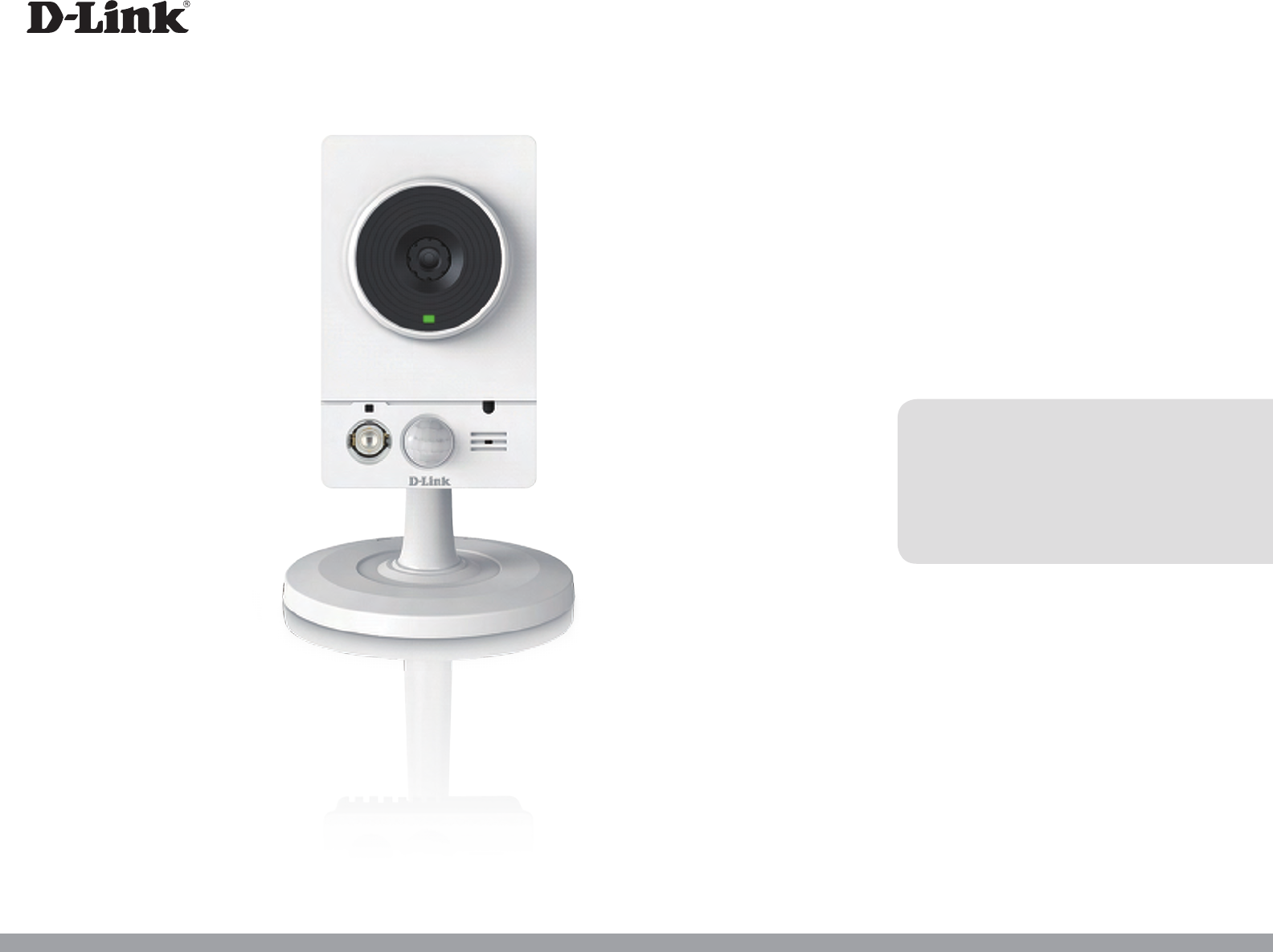
User Manual
Vigilance HD Wireless Camera
Version 1.00 | 04/24/2015
DCS-4201

2D-Link DCS-4201 User Manual
D-Link reserves the right to revise this publication and to make changes in the content hereof without obligation to notify any person or
organization of such revisions or changes. Information in this document may become obsolete as our services and websites develop and
change. Please refer to the www.mydlink.com website for the most current information.
Manual Revisions
Revision Date Description
1.0 April 24, 2015 DCS-4201 Revision A1 with rmware version 1.00
Trademarks
D-Link and the D-Link logo are trademarks or registered trademarks of D-Link Corporation or its subsidiaries in the United States or other
countries. All other company or product names mentioned herein are trademarks or registered trademarks of their respective companies.
Copyright © 2015 D-Link Corporation.
All rights reserved. This publication may not be reproduced, in whole or in part, without prior expressed written permission from D-Link Corporation.
Preface

3D-Link DCS-4201 User Manual
Table of Contents
Product Overview ......................................................................... 4
Package Contents ................................................................. 4
Introduction ............................................................................ 5
System Requirements ......................................................... 5
Features .................................................................................... 6
Hardware Overview ............................................................. 7
Front ...................................................................................... 7
Rear ........................................................................................ 8
Sides ...................................................................................... 9
Wireless Installation Considerations ............................10
Installation ....................................................................................11
Hardware Installation ........................................................11
Mount the Camera .............................................................12
Conguration with Wizard ..............................................13
Viewing Camera via Web Browser ............................17
Setup Wizard SE ...................................................................17
Conguration ...............................................................................19
Using the Conguration Interface ................................19
Live Video ..............................................................................20
Setup .......................................................................................22
Setup Wizard ....................................................................22
Network Setup .................................................................27
Wireless Setup .................................................................. 31
Dynamic DNS ...................................................................32
Image Setup .....................................................................33
Audio and Video ..............................................................35
Preset ................................................................................... 37
Motion Detection ...........................................................39
Sound Detection .............................................................41
Time and Date .................................................................. 42
Event Setup .......................................................................43
SD Card ...............................................................................52
Advanced ............................................................................... 53
Digital Input/Output ......................................................53
ICR and IR ...........................................................................54
HTTPS ..................................................................................55
Access List .......................................................................... 56
Maintenance .........................................................................57
Device Management .....................................................57
System ................................................................................58
Firmware Upgrade ..........................................................59
Status ......................................................................................60
Device Info ........................................................................60
Logs .....................................................................................61
Help......................................................................................62
DI/DO Specications .................................................................63
Technical Specications ...........................................................64
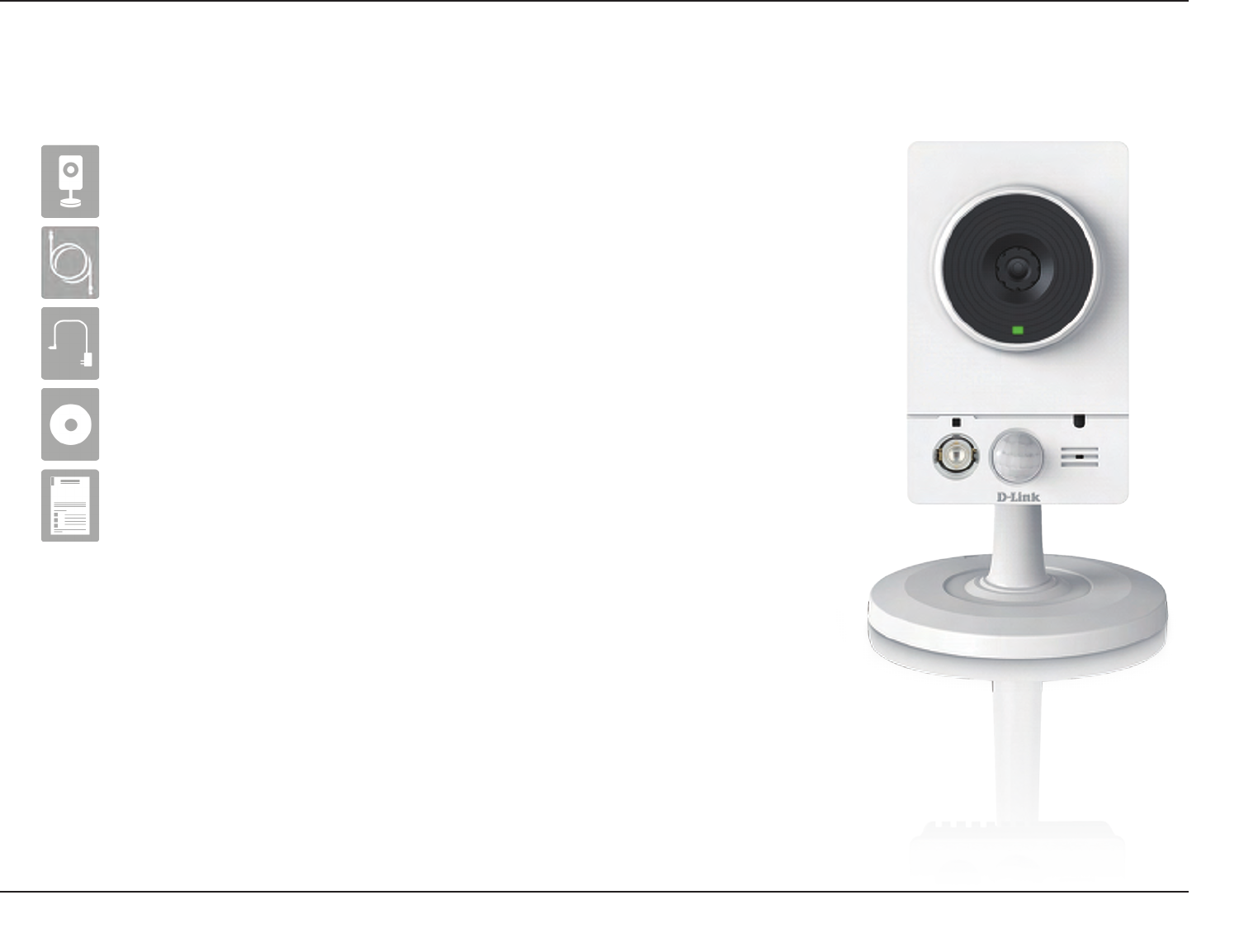
4D-Link DCS-4201 User Manual
Section 1: Product Overview
Product Overview
Package Contents
If any of the above items are missing, please contact your reseller.
Safety Notice: Installation and servicing should be done by certied technicians so as
to conform to all local codes and prevent voiding your warranty.
Quick Installation Guide
CAT5 Ethernet cable
Power adapter
CD-ROM with User Manual and software
DCS-4201 Vigilance HD Wireless Camera

5D-Link DCS-4201 User Manual
Section 1: Product Overview
Introduction
Congratulations on your purchase of the DCS-4201 Vigilance HD Wireless Camera. The DCS-4201 is a versatile and unique
solution for your small oce. Unlike a standard webcam, the DCS-4201 is a complete system with a built-in CPU and web
server that transmits high quality video images for security and surveillance. The DCS-4201 can be accessed remotely, and
controlled from any PC/Notebook over your local network or through the Internet via a web browser. The simple installation
and intuitive web-based interface oer easy integration with your Ethernet/Fast Ethernet or 802.11n/g wireless network. The
DCS-4201 also comes with motion and sound detection features for a complete security solution.
• Computer with Microsoft Windows® 7/8/Vista, Mac OS or Linux
• Internet Explorer 7, Firefox 20, Safari 6, or higher version with Java installed and enabled
• Existing 10/100 Ethernet-based network
• A microSD memory card (optional) is required for recording to onboard storage. SDHC Class 6 or above is recommended.
System Requirements

6D-Link DCS-4201 User Manual
Section 1: Product Overview
Simple to Use
The DCS-4201 is a stand-alone system with a built-in CPU, requiring no special hardware or software. The DCS-4201 supports both ActiveX mode
for Internet Explorer and Java mode for other browsers such as Firefox® and Safari®.
Supports a Variety of Platforms
Supporting TCP/IP networking, HTTP, and other Internet related protocols. The DCS-4201 can also be integrated easily into other Internet/Intranet
applications because of its standards-based features.
Advanced Event Management
The DCS-4201 can be set up to send e-mail notications with snapshots when an event occurs, such as when motion is detected. Events can be
triggered from several sources, such as motion detection and time based events.
Broad Range of Applications
With today’s high-speed Internet services, the Network Camera can provide the ideal solution for delivering live video images over the Intranet and
Internet for remote monitoring. The Network Camera allows remote access using a Web browser for live image viewing, and allows the administrator
to manage and control the Network Camera anytime, anywhere in the world. Many applications exist, including industrial and public monitoring
of homes, oces, banks, hospitals, child-care centers, and amusement parks.
IR LED for Day and Night functionality
The built-in infrared LED enables night time viewing of up to 10 meters.
802.11n Wireless or Ethernet/Fast Ethernet Support
The DCS-4201 oers wireless 802.11n and Ethernet/Fast Ethernet connectivity, making the network camera easy to integrate into your existing
network environment. The DCS-4201 works with a 10Mbps Ethernet based network or 100Mbps Fast Ethernet based network for traditional wired
environments, and works with 802.11n routers or access points for added exibility. The Site Survey feature also allows you to view and connect to
any available wireless networks.
Features

7D-Link DCS-4201 User Manual
Section 1: Product Overview
Hardware Overview
Front
1 Status LED Indicates the camera's current status
2 Infrared LED Used to illuminate the camera's eld of view at night
3 PIR Sensor Passive infrared sensor for motion detection
4 Camera Lens Records video of the surrounding area
5 Microphone Records audio from the surrounding area
6Light Sensor The light sensor monitors lighting conditions and switches between day and
night vision modes accordingly
7Speaker Can play audio sent to camera for two-way communication
1
2
3
4
5
7
6
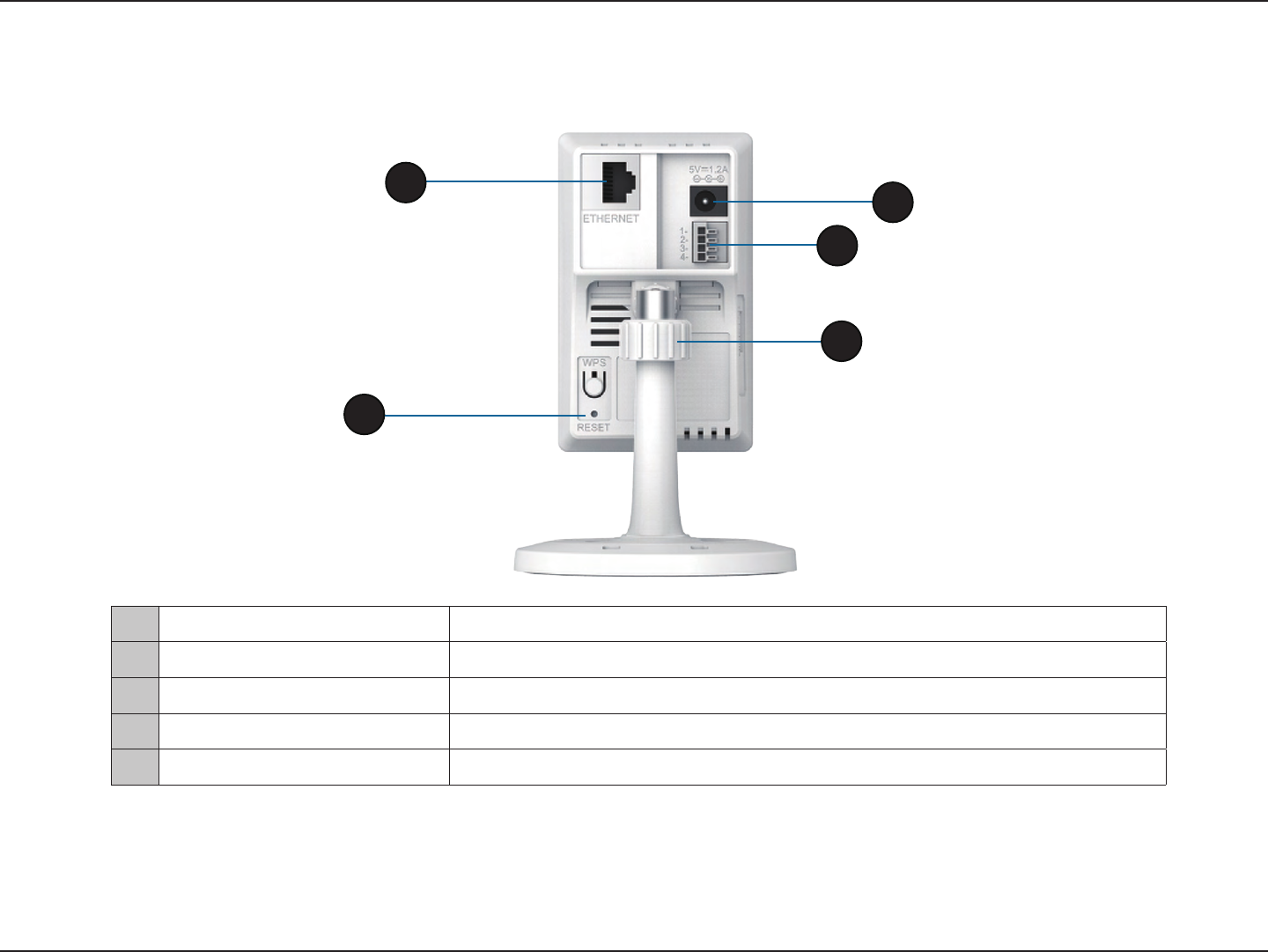
8D-Link DCS-4201 User Manual
Section 1: Product Overview
Rear
1 Ethernet Port Connects to your Ethernet network
2 Reset Button Press and hold this button for 10 seconds to reset the camera
3 Power Connector Connects to the included DC 5 V power adapter
4 DI/DO Connector I/O connectors for external devices
5 Adjustment Ring Tighten or loosen the adjustment ring to adjust the camera's position
1
2
3
5
4
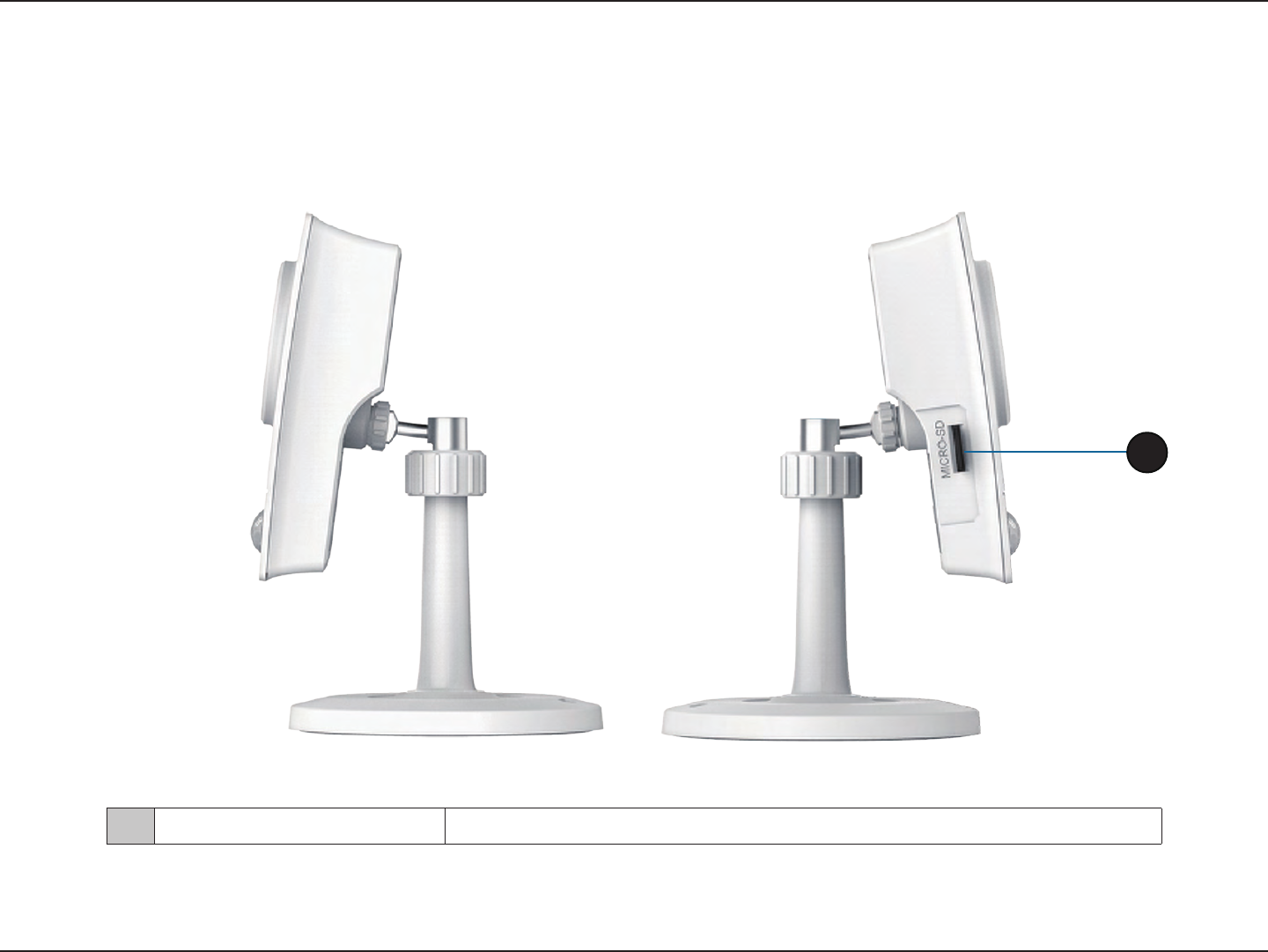
9D-Link DCS-4201 User Manual
Section 1: Product Overview
Sides
1 microSD Card Slot Insert a microSD card for storing recorded images and video locally
1

10D-Link DCS-4201 User Manual
Section 1: Product Overview
This D-Link device can connect to your wireless network from anywhere within the operating range of your wireless network.
However, the number, thickness and location of walls, ceilings, or other objects that the wireless signals must pass through,
may limit the range. Typical ranges vary depending on the types of materials and background RF (radio frequency) noise in
your home or business. The key to maximizing wireless range is to follow these basic guidelines:
1. Minimize the number of walls and ceilings between your adapter and other network devices (such as your network
camera) - each wall or ceiling can reduce your adapter’s range from 3-90 feet (1-30 meters).
2. Be aware of the direct line between network devices. A wall that is 1.5 feet thick (.5 meters), at a 45-degree angle appears
to be almost 3 feet (1 meter) thick. At a 2-degree angle, it looks over 42 feet (14 meters) thick. Position your devices so
that the signal will travel straight through a wall or ceiling (instead of at an angle) for better reception.
3. Building materials make a dierence. A solid metal door or aluminum studs may weaken the wireless signal. Try to position
your access points, wireless routers, and other networking devices where the signal passes through drywall or open
doorways. Materials and objects such as glass, steel, metal, walls with insulation, water (sh tanks), mirrors, le cabinets,
brick, and concrete will degrade your wireless signal.
4. Keep your product at least 3-6 feet or 1-2 meters away from electrical devices or appliances that generate RF noise.
5. If you are using 2.4GHz cordless phones or other radio frequency sources (such as microwave ovens), your wireless
connection may degrade dramatically or drop completely. Make sure your 2.4GHz phone base is as far away from your
wireless devices as possible. The base transmits a signal even if the phone is not in use.
Wireless Installation Considerations
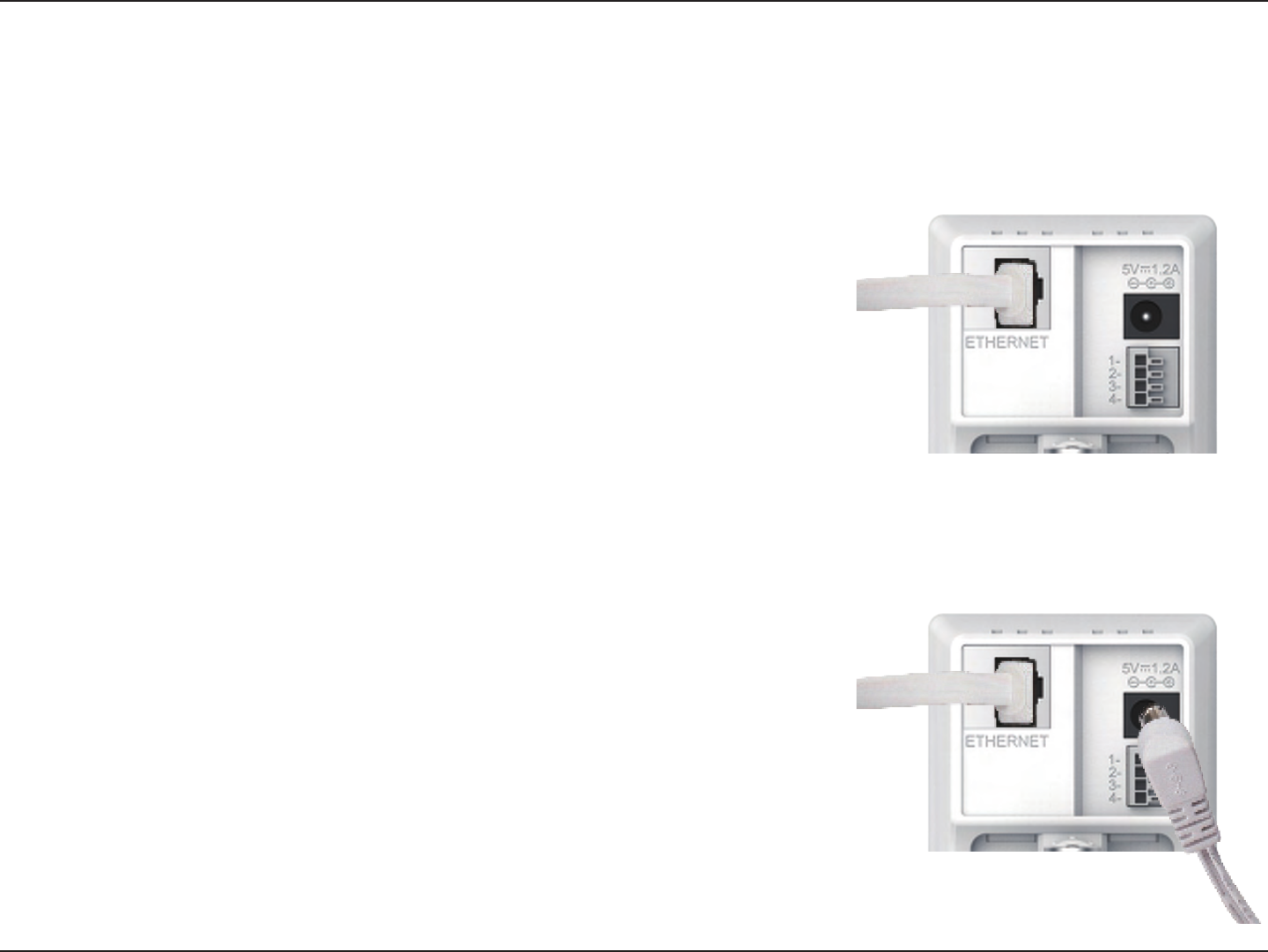
11D-Link DCS-4201 User Manual
Section 2: Installation
Connect the Ethernet Cable
Connect the included Ethernet cable to the network cable connector located on
the panel at the rear of the DCS-4201 and attach it to the network.
Attach the External Power Supply
Attach the external power supply to the DC Power receptor located on the rear
panel of the DCS-4201 and connect it to your wall outlet or power strip.
Note: If you choose to take advantage of the Power over Ethernet feature you
may unplug the power cable.
If you wish to set up your camera without using the Camera Setup Wizard, please follow these steps.
Installation
Hardware Installation
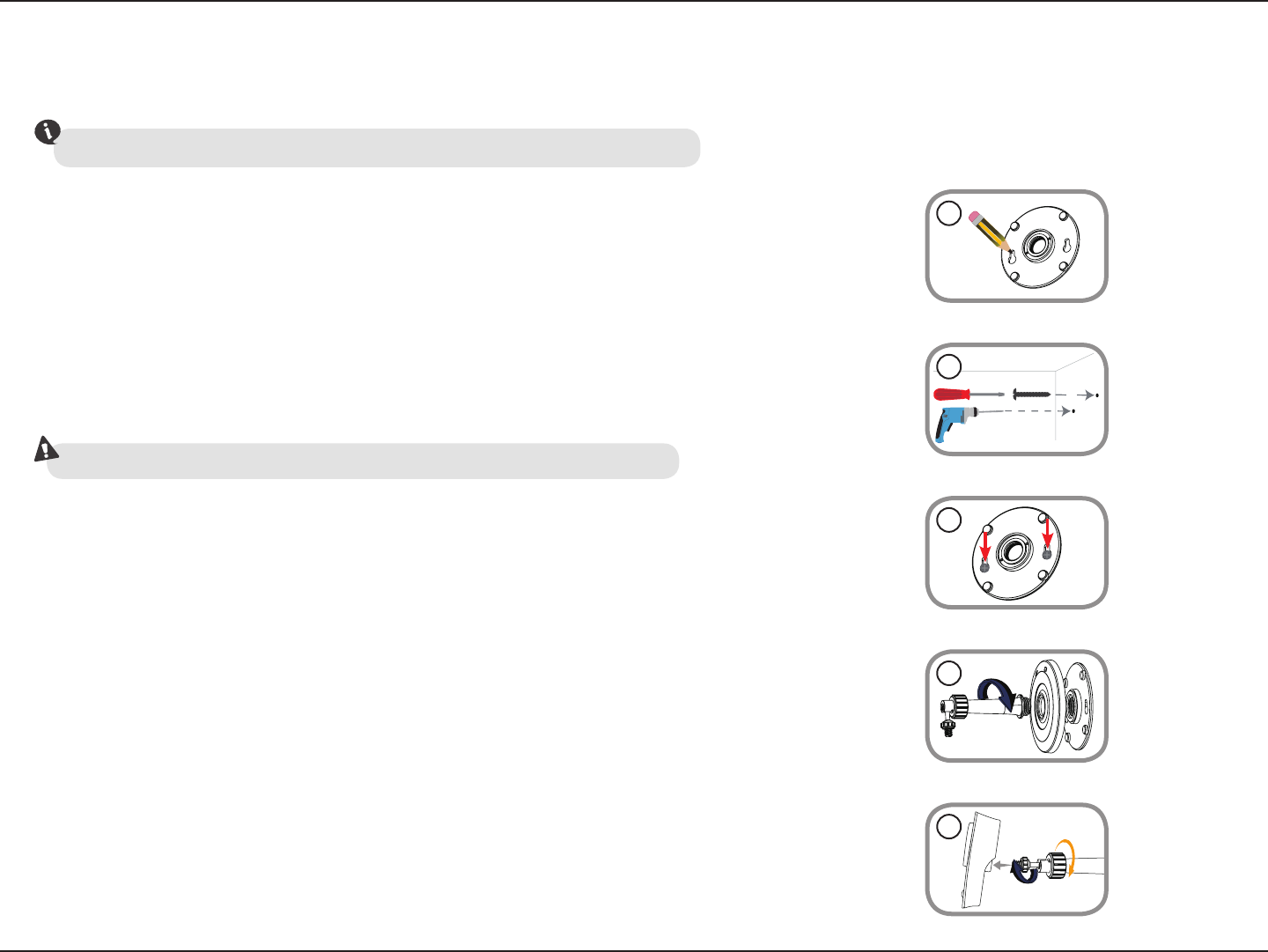
12D-Link DCS-4201 User Manual
Section 2: Installation
1. Place the mounting base where you want to position the camera and use a pencil
to mark the holes.
4. Place the base cover on the base and screw the camera stem clockwise into the
mounting base.
2. Depending on the material of the wall or ceiling, use proper tools to drill two
holes or screws where you marked. If the wall is made out of concrete, drill the
holes rst, insert the plastic anchors and then the screws.
3. Place the mounting base over the screw that is mounted on the wall. Make sure
to t the screw-heads over the big holes and slide it downward to lock rmly.
Lightly pull the base forward to make sure that it is locked.
Please refer to the steps below to assist you with mounting the camera.
The space between the camera and the screwheads should be 3 mm.
We suggest that you congure the camera before mounting.
1
2
3
4
5. Adjust the angle of the camera as desired, then tighten the collar on the camera
stem to lock it in place.
5
Mount the Camera
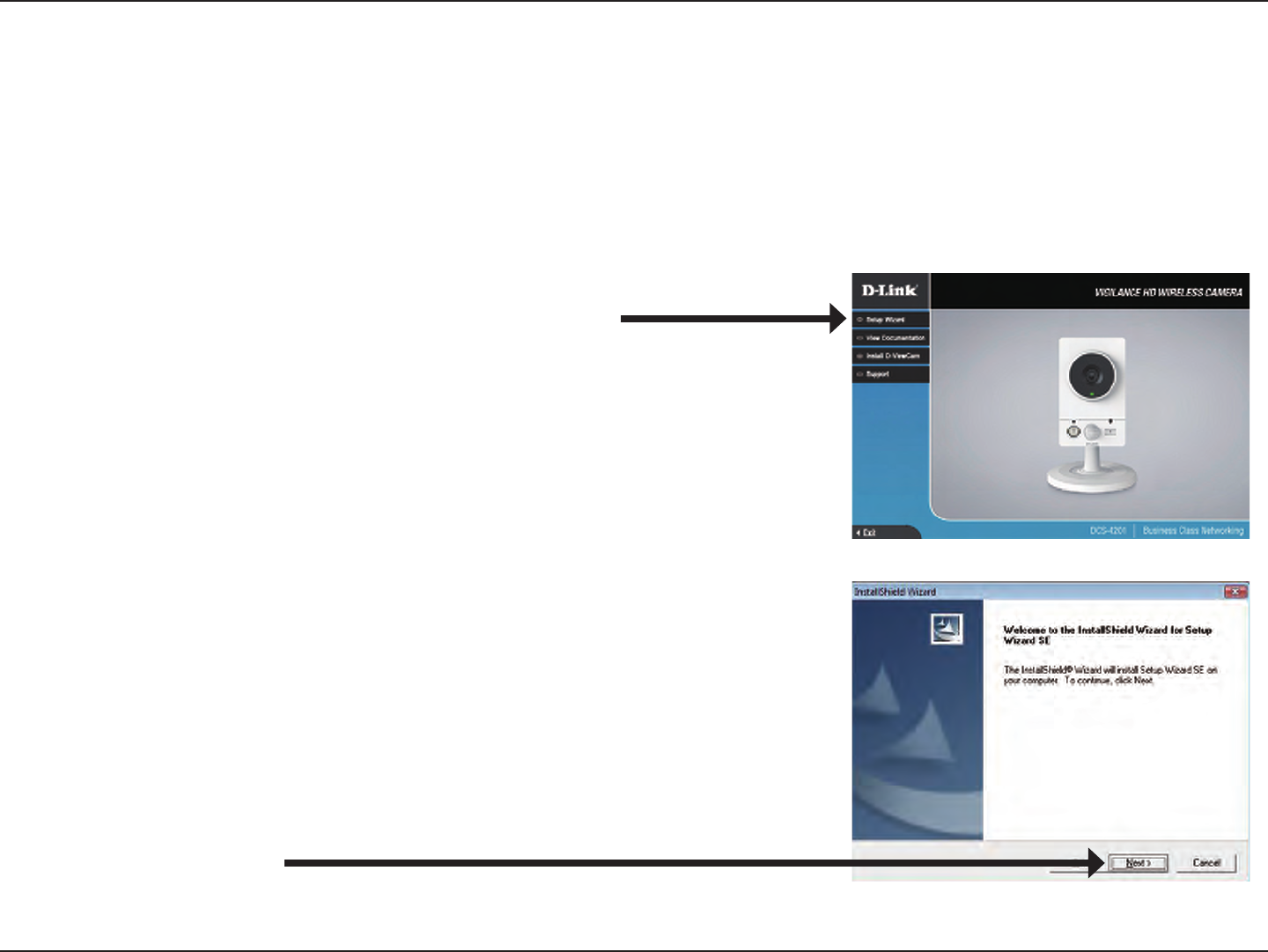
13D-Link DCS-4201 User Manual
Section 2: Installation
Conguration with Wizard
Insert the DCS-4201 CD into your computer's CD-ROM drive to begin the installation. If the Autorun function on your
computer is disabled, or if the D-Link Launcher fails to start automatically, click Start > Run. Type D:\autorun.exe,
where D: represents the drive letter of your CD-ROM drive.
Click Setup Wizard to begin the installation.
After clicking Setup Wizard, the following window will open.
Click Next to continue.
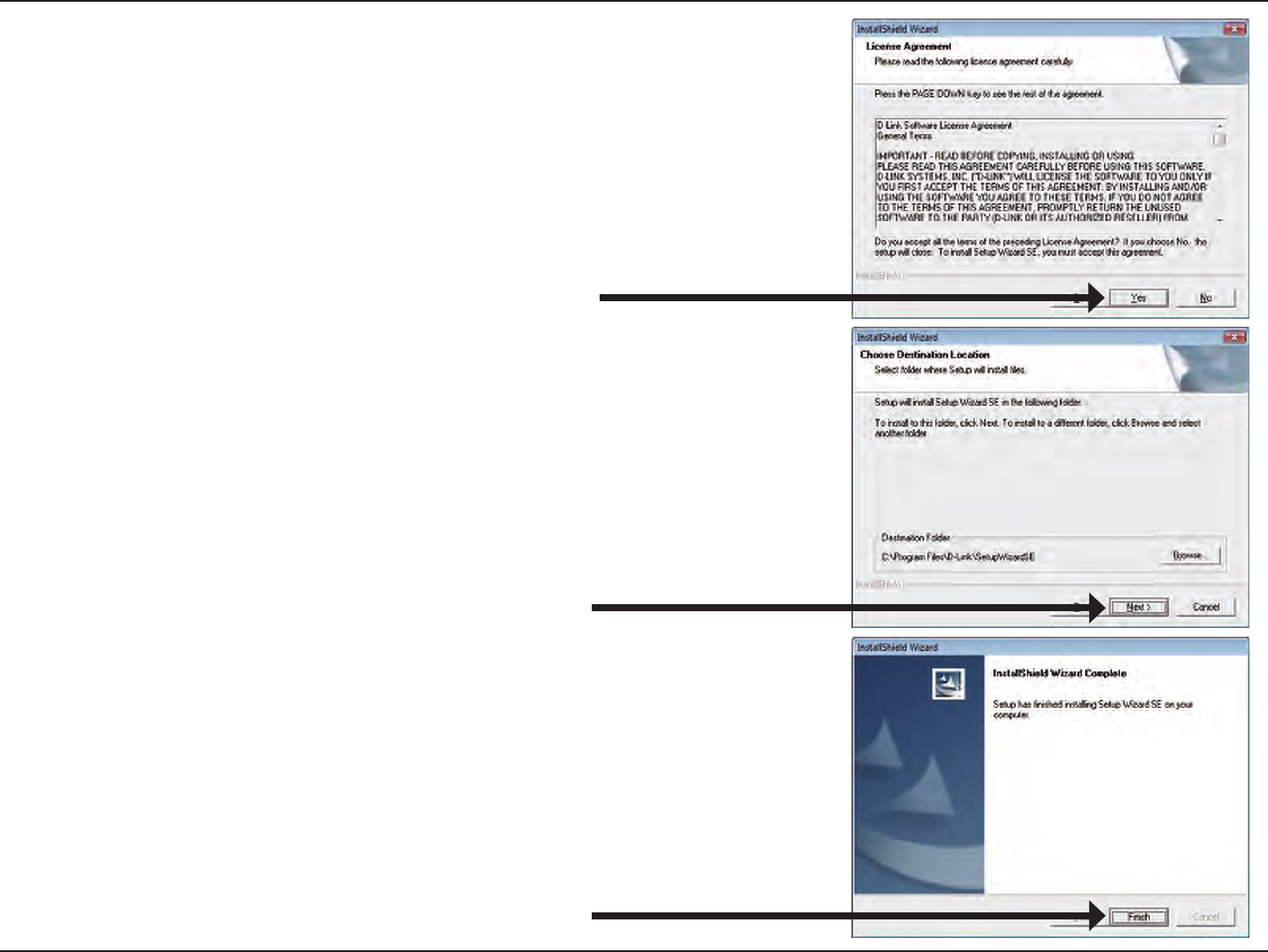
14D-Link DCS-4201 User Manual
Section 2: Installation
Click Yes to accept the License Agreement.
Click Finish to complete the installation.
Click Next to start the installation process.
Note: The installation may take several minutes to
nish.
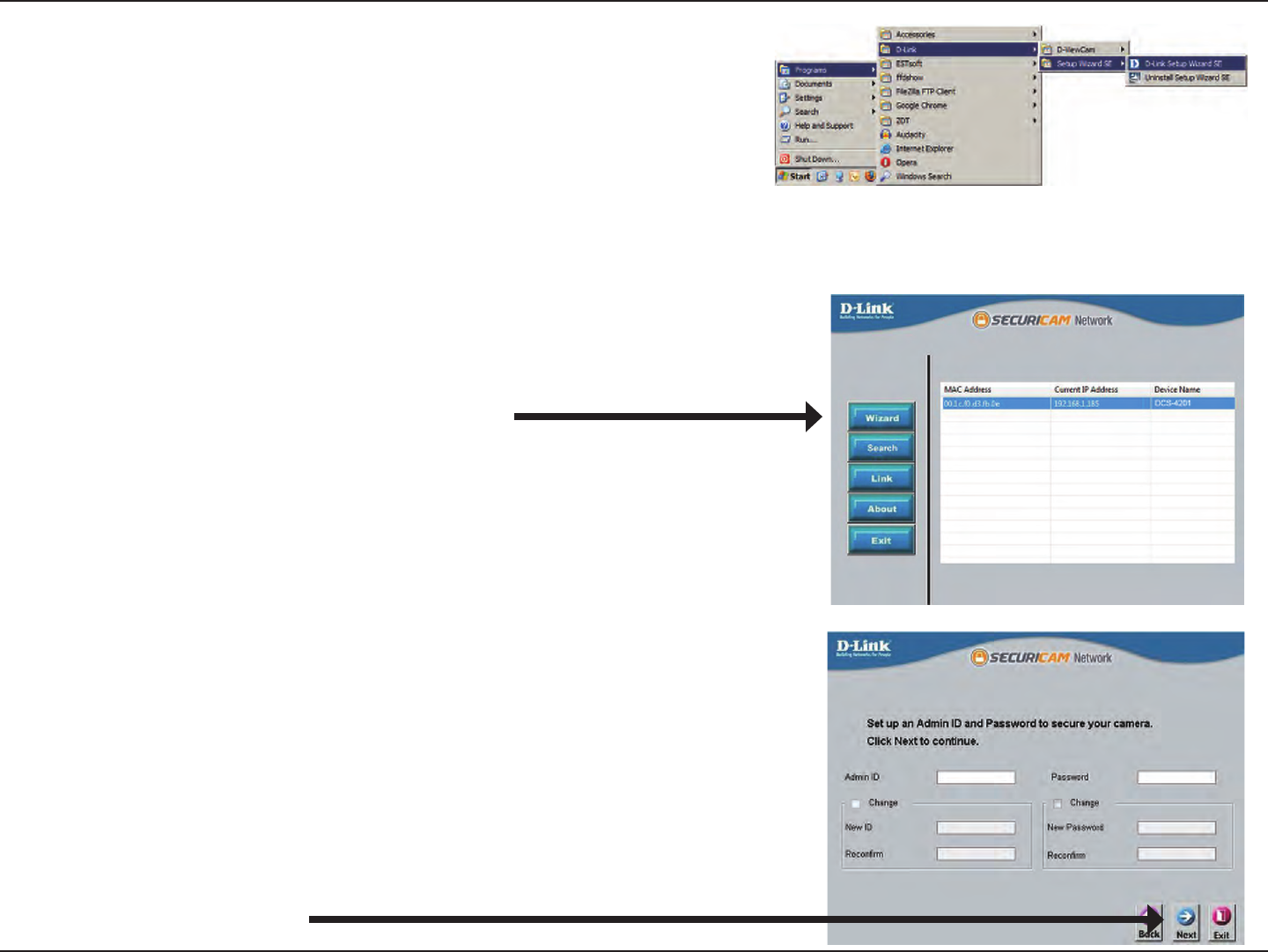
15D-Link DCS-4201 User Manual
Section 2: Installation
Click on the D-Link Setup Wizard SE icon that was created in your
Windows Start menu.
Start > D-Link > Setup Wizard SE
Enter the Admin ID and password. When logging in for the rst time,
the default Admin ID is admin with the password left blank.
Click Next to continue.
The Setup Wizard will appear and display the MAC address and
IP address of your camera(s). If you have a DHCP server on your
network, a valid IP Address will be displayed. If your network does
not use a DHCP server, the network camera's default static IP
192.168.0.20 will be displayed.
Click the Wizard button to continue.
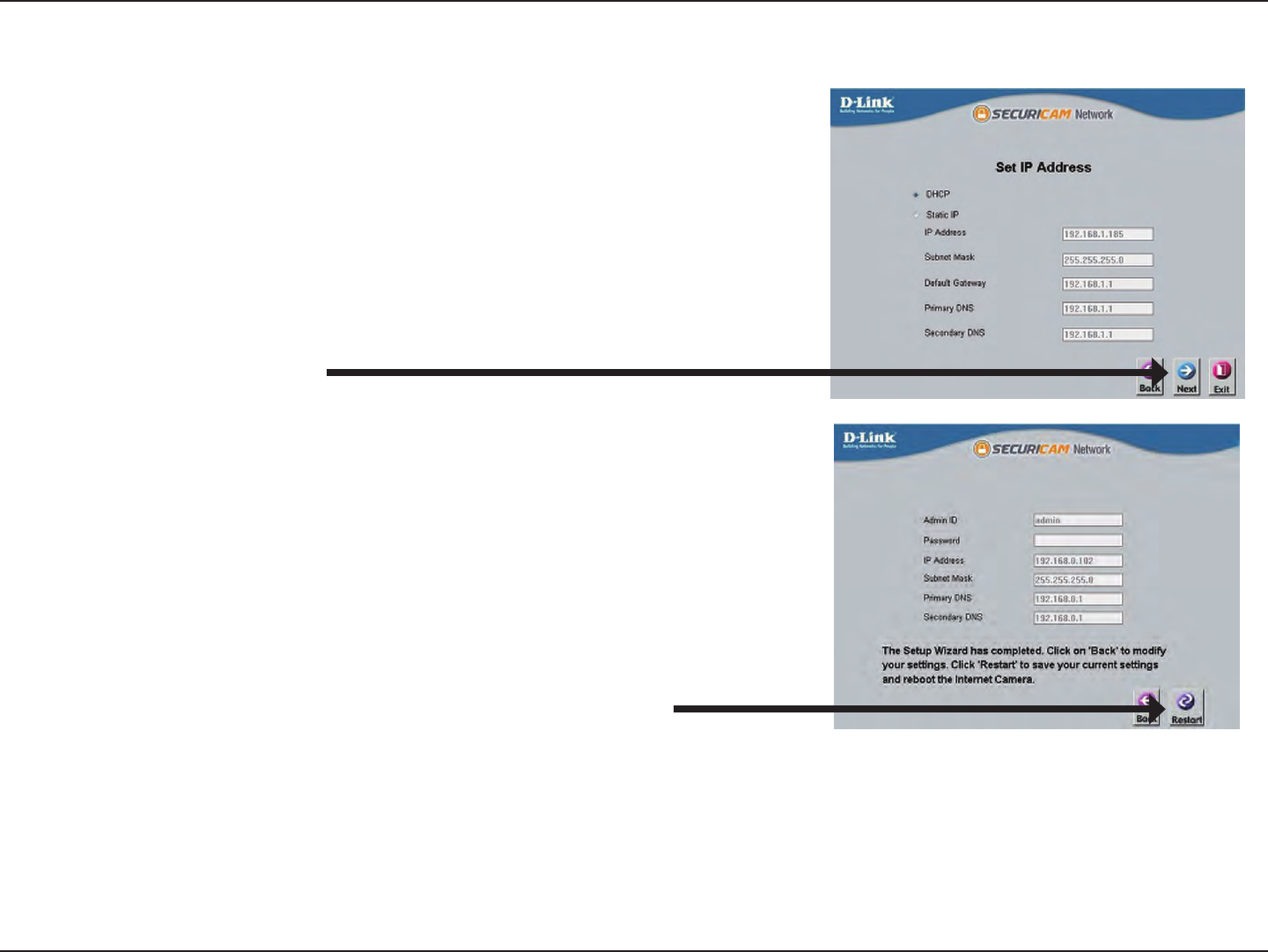
16D-Link DCS-4201 User Manual
Section 2: Installation
Take a moment to conrm your settings and click Restart.
Select DHCP if your camera obtains an IP address
automatically from a DHCP server (e.g., router). Select Static
IP if you want to manually enter the IP settings for the camera.
Click Next to continue.
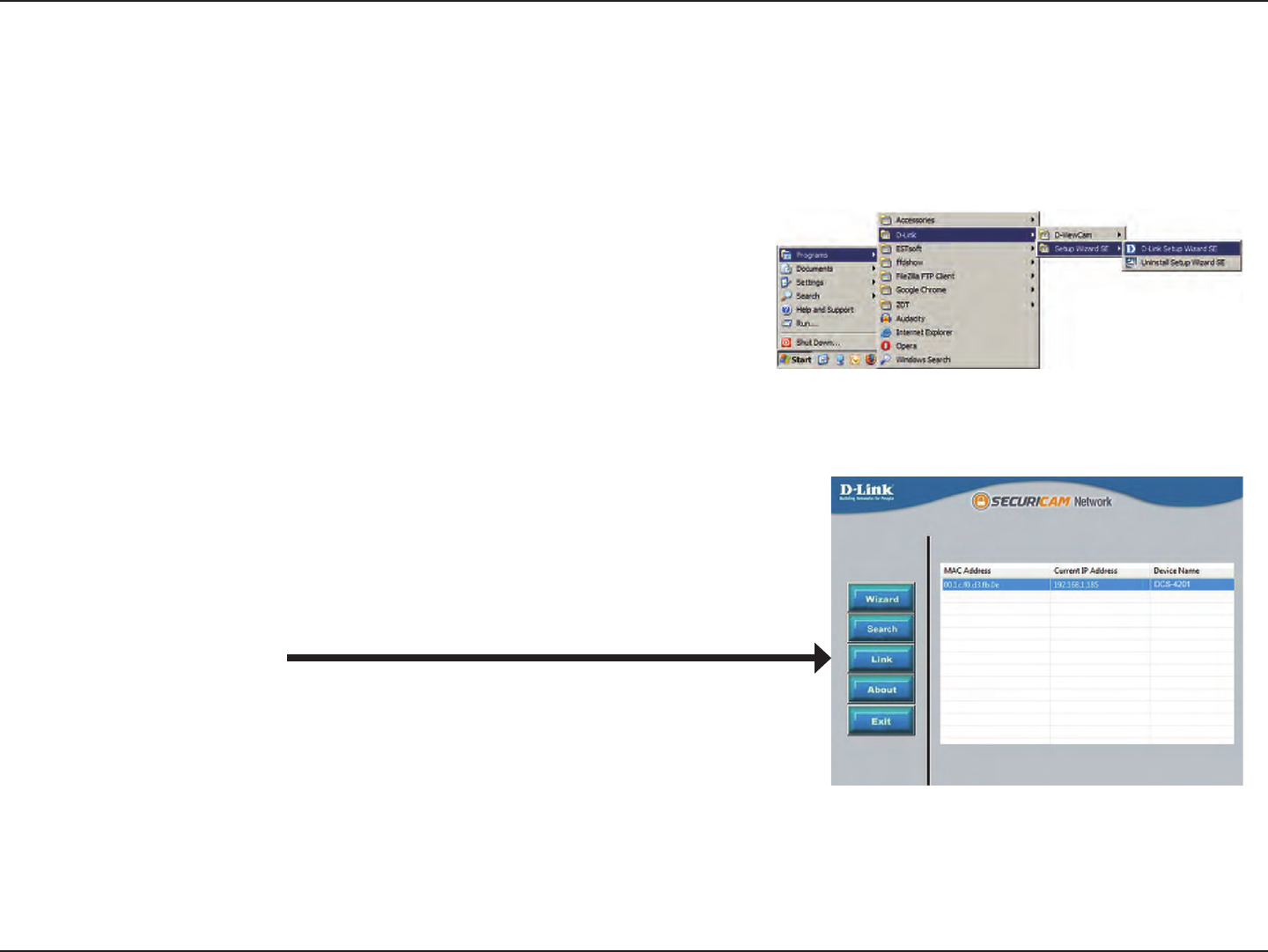
17D-Link DCS-4201 User Manual
Section 2: Installation
Setup Wizard SE
Click on the D-Link Setup Wizard SE icon that was created in your
Windows Start menu.
Start > D-Link > Setup Wizard SE
Viewing Camera via Web Browser
Select the camera and click Link to access the web
conguration.
The Setup Wizard will automatically open your web browser
to the IP address of the camera.
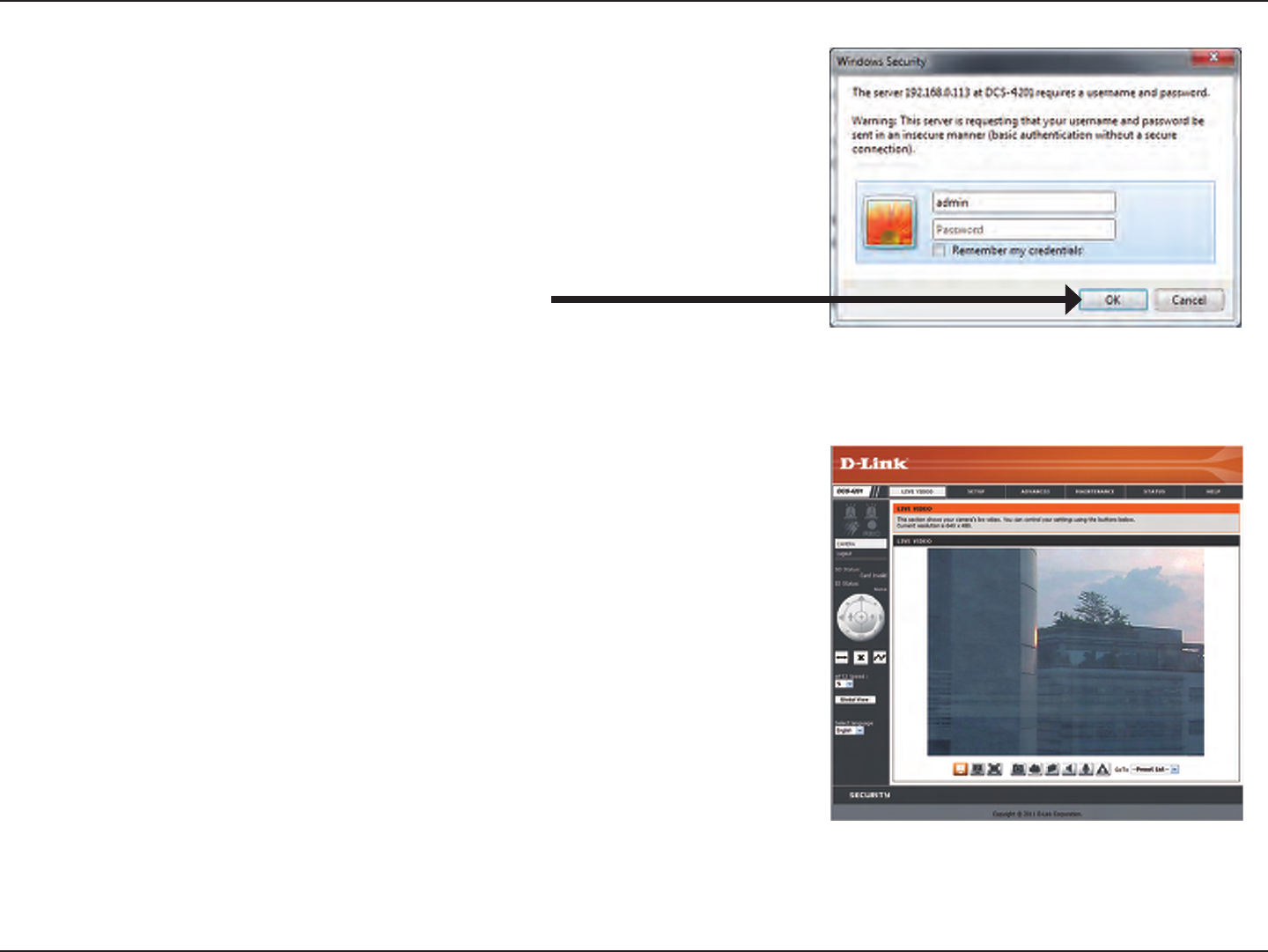
18D-Link DCS-4201 User Manual
Section 2: Installation
This section displays your camera’s live video. You can select
your video prole and view or operate the camera. For additional
information about web conguration, please refer to the user
manual included on the CD-ROM or the D-Link website.
Enter admin as the default username and leave
the password blank. Click OK to continue.
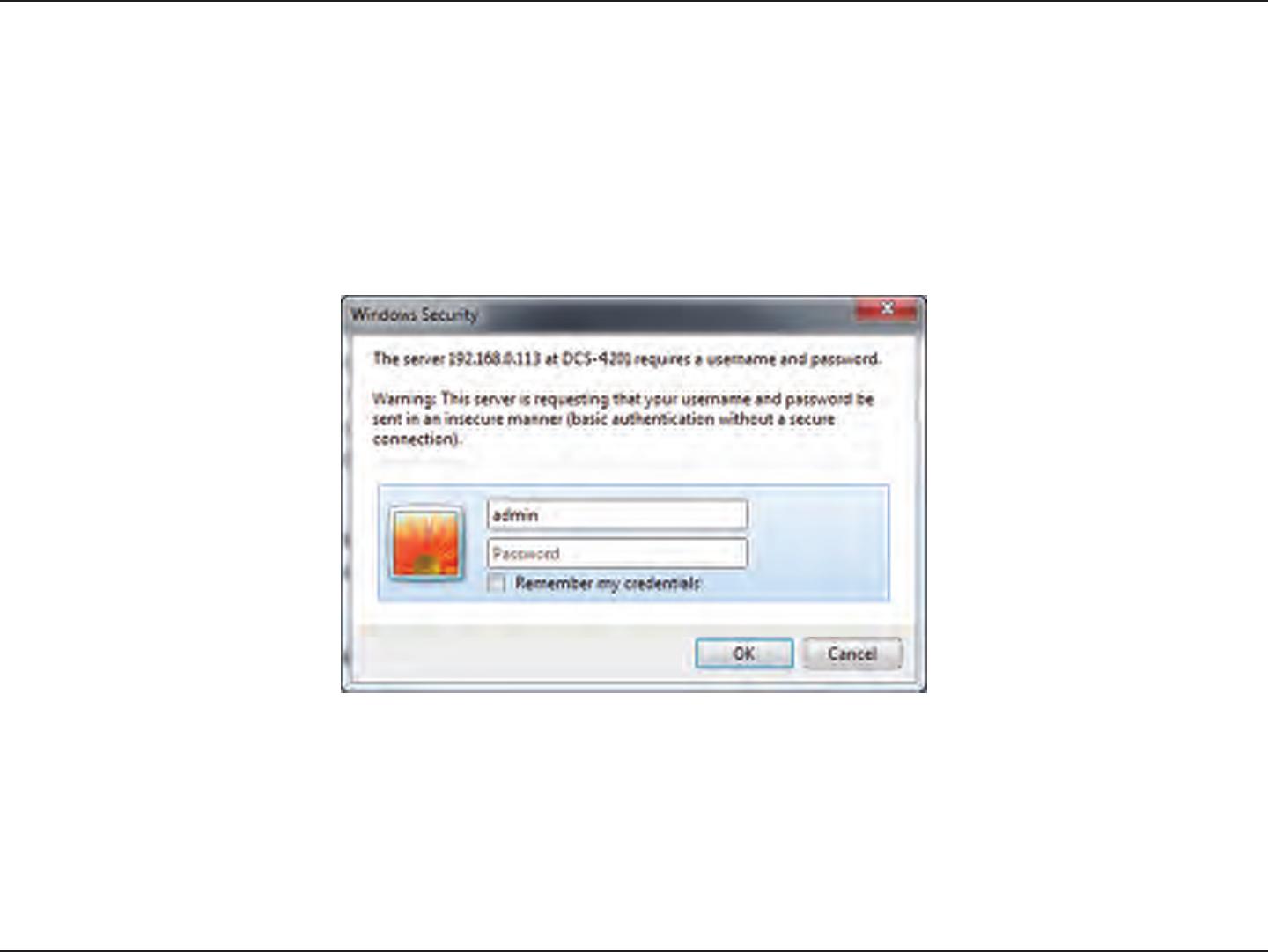
19D-Link DCS-4201 User Manual
Section 3: Conguration
Conguration
Using the Conguration Interface
After completing the Camera Installation Wizard, you are ready to use your camera. The camera’s built-in Web conguration utility is designed to
allow you to easily access and congure your DCS-4201. At the end of the wizard, enter the IP address of your camera into a web browser, such as
Mozilla Firefox. To log in, use the User name admin and the password you created in the Installation Wizard. If you did not create a password, the
default password is blank. After entering your password, click OK.
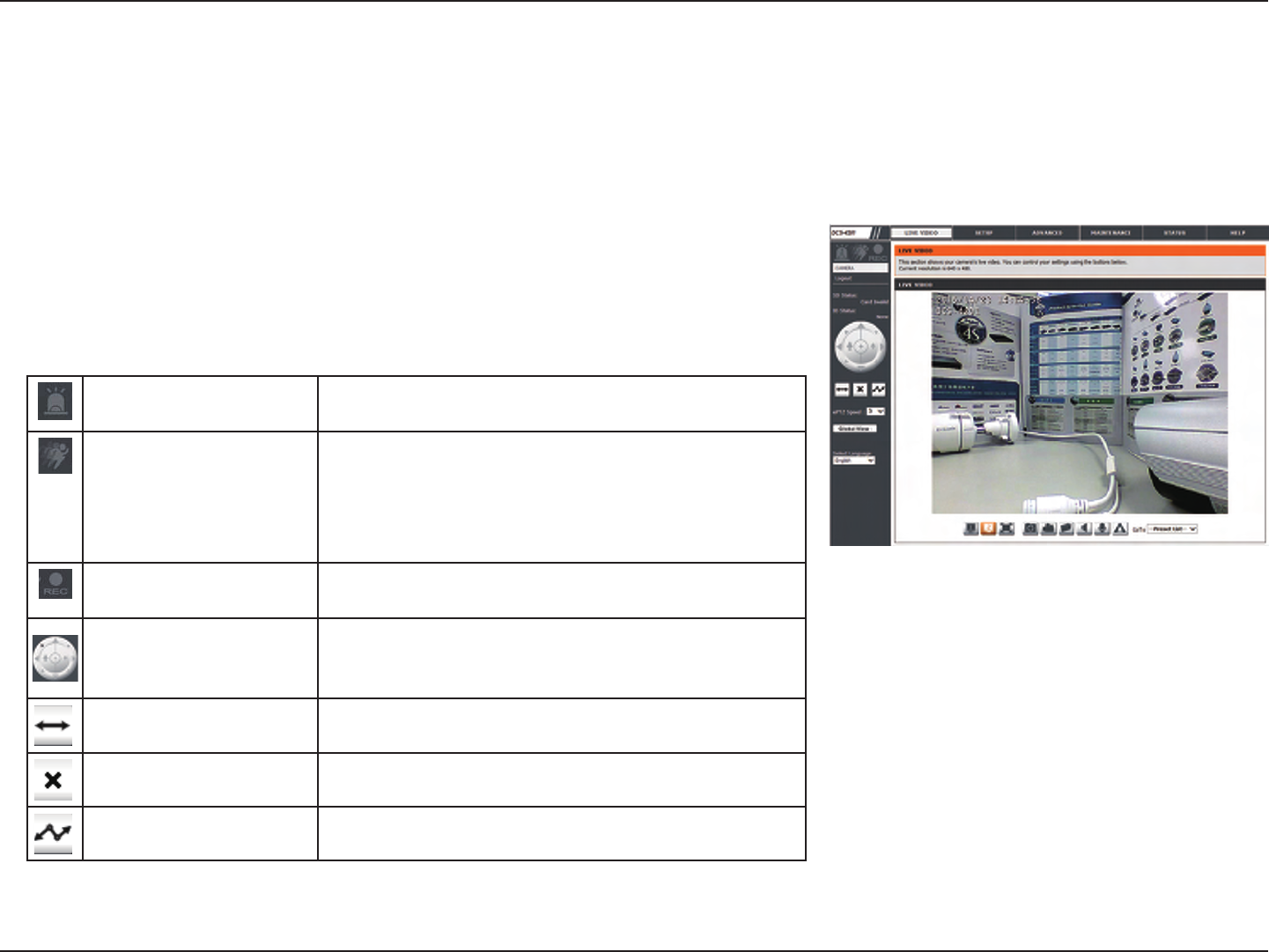
20D-Link DCS-4201 User Manual
Section 3: Conguration
Live Video
This section shows your camera’s live video. You may select any of the available icons listed below to operate the camera. You may also select your
language using the drop-down menu on the left side of the screen.
You can zoom in and out on the live video image using your mouse. Right-click to zoom out or left-click to zoom in on the image.
Digital Input Indicator This indicator will change color when a digital input
signal is detected.
Motion Trigger
Indicator
This indicator will change color when a trigger event
occurs.
Note: The video motion feature for your camera must
be enabled.
Recording Indicator When a recording is in progress, this indicator will
change color.
Control Pad
This control pad can be used to electronically pan, tilt,
and zoom (ePTZ) within the camera's predened view
area, if one has been dened.
Auto Pan Starts the automatic panning function.
Stop Stops automatic panning.
Preset Path Starts the camera's motion along the predened path.
You may select a value between 0 and 64. 0 is the slowest
and 64 is the fastest.
ePTZ Speed:
This option displays the status of the microSD card. If no
microSD card has been inserted, this screen will display
the message "Card Invalid."
This option displays the status of your I/O device if a
device has been connected.
SD Status:
IO Status:
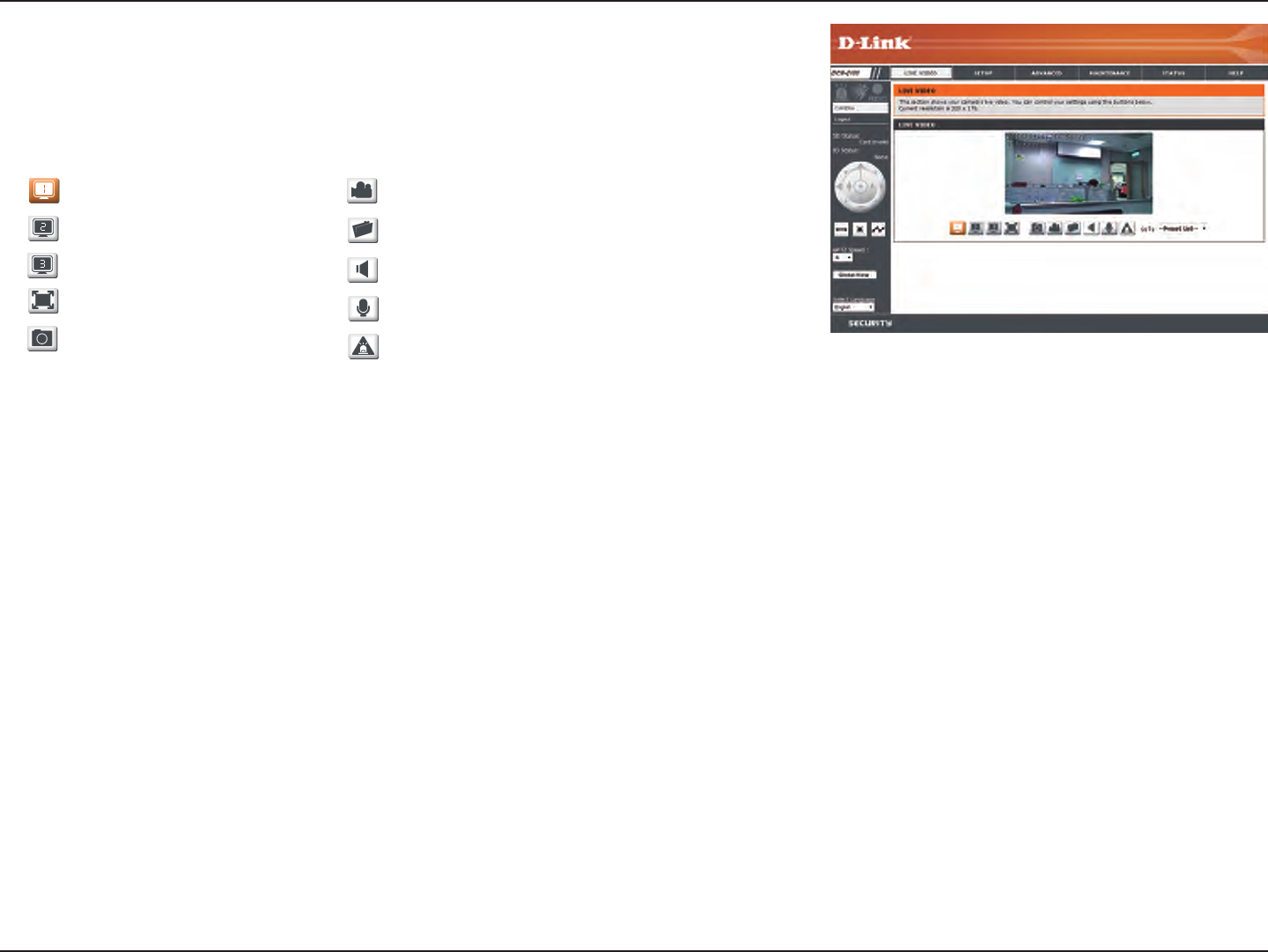
21D-Link DCS-4201 User Manual
Section 3: Conguration
If any presets have been dened, you can select them
here to move the camera to the selected preset.
Go To (Preset List):
Video Prole 1
Video Prole 2
Video Prole 3
Full screen mode
Taking a Snapshot
Record a Video Clip
Set a Storage Folder
Listen/Stop Audio In (from microphone)
Start/Stop Audio Out (to speaker)
Start/Stop Digital Output
This window indicates the total eld of view (FOV) of
the camera. The red box indicates the visible region of
interest (ROI).
You may select the interface language using this menu.
Global View:
Language:
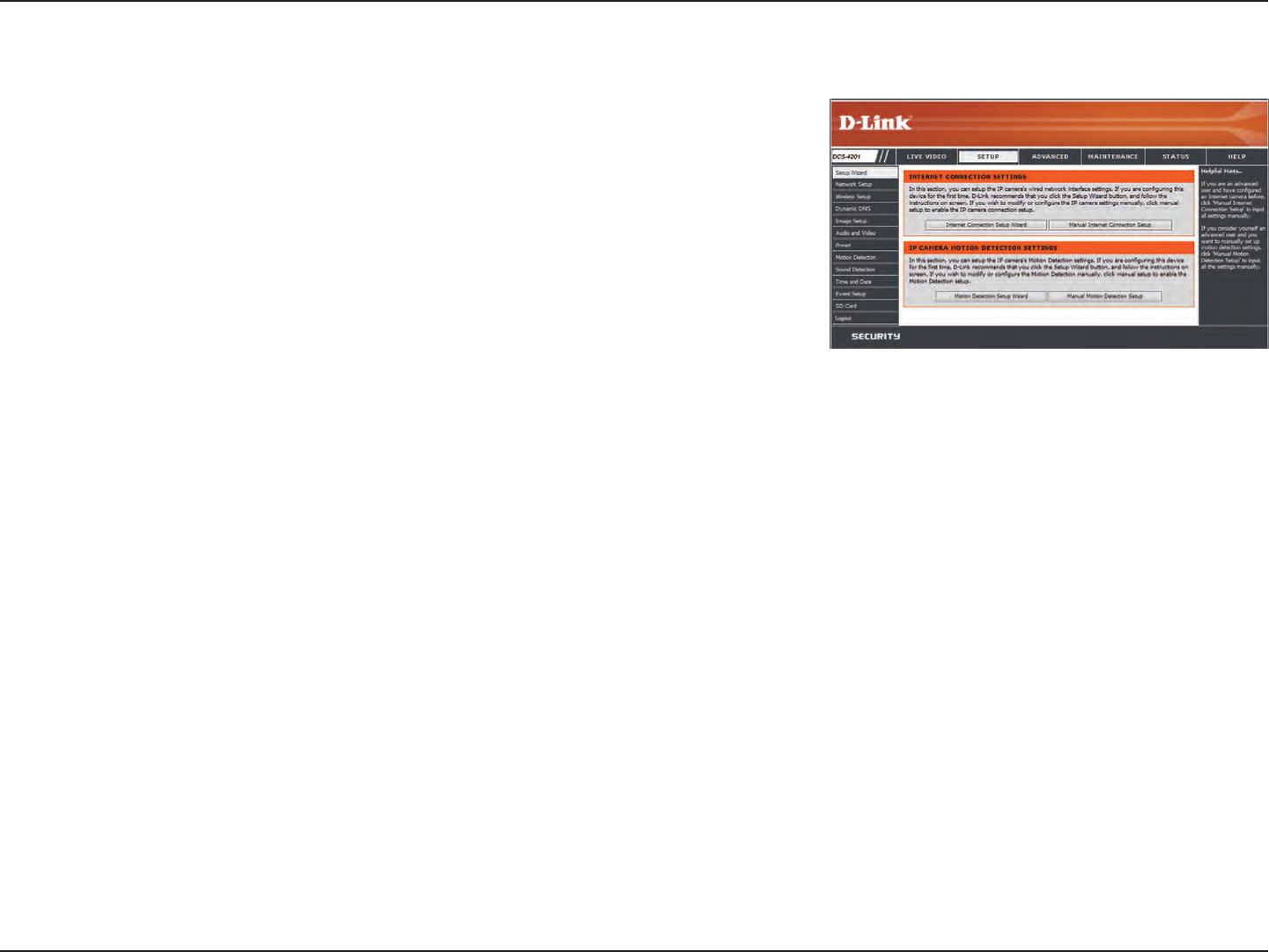
22D-Link DCS-4201 User Manual
Section 3: Conguration
Setup
Setup Wizard
To congure your Network Camera, click Internet Connection Setup Wizard. Alternatively,
you may click Manual Internet Connection Setup to manually congure your Network
Camera and skip to "Network Setup" on page 27.
To quickly congure your Network Camera’s motion detection settings, click Motion
Detection Setup Wizard. If you want to enter your settings without running the wizard, click
Manual Motion Detection Setup and skip to"Motion Detection" on page 39.
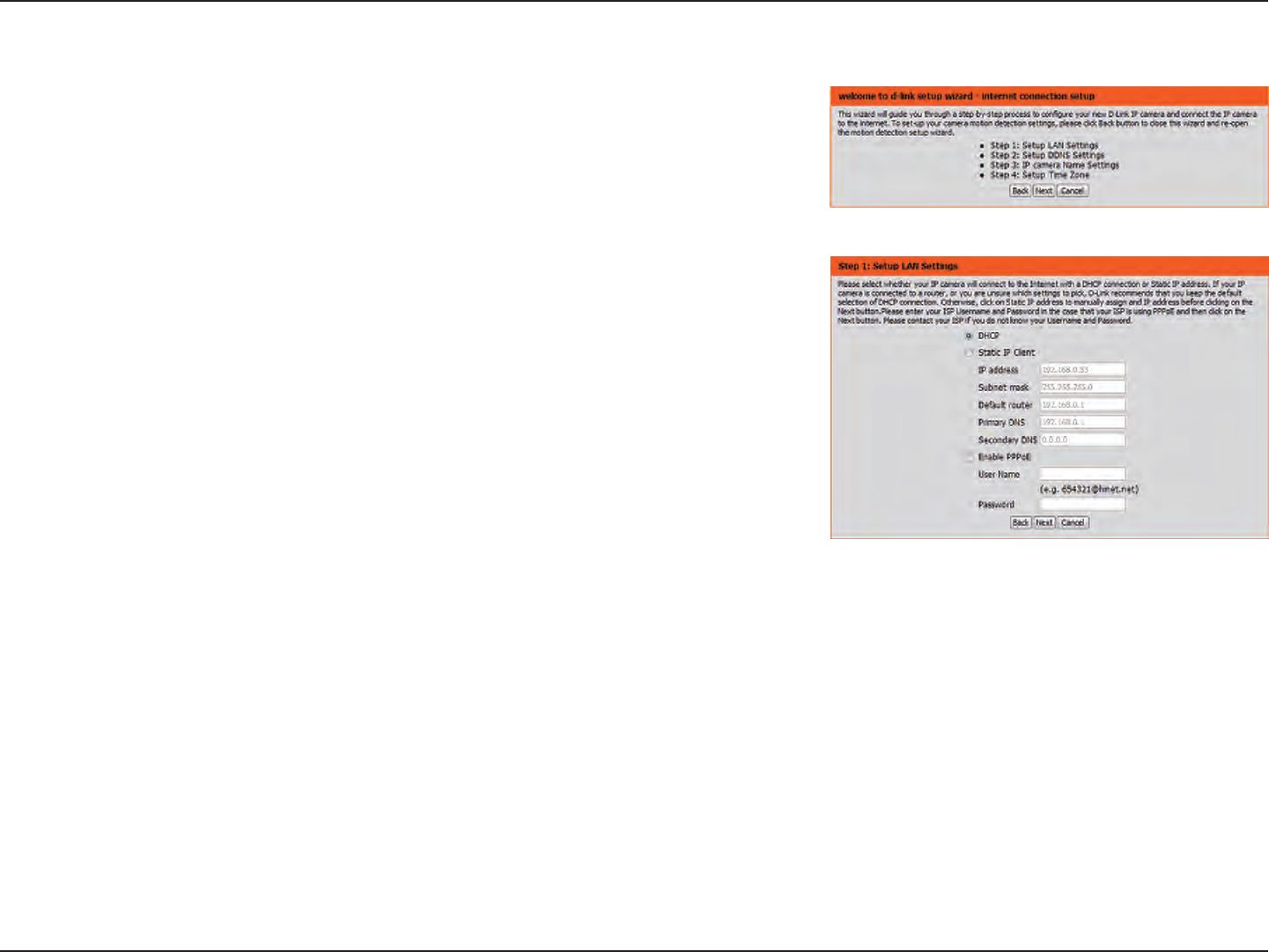
23D-Link DCS-4201 User Manual
Section 3: Conguration
Internet Connection Setup Wizard
This wizard will guide you through a step-by-step process to congure your new D-Link
Camera and connect the camera to the Internet. Click Next to continue.
Select how the camera will connect to the Internet.
If your router is connected to a router, or you are unsure how your camera will connect
to the Internet, select DHCP Connection.
Select Static IP if your Internet Service Provider has provided you with connection settings, or
if you wish to set a static address within your home network. Enter the correct conguration
information and click Next to continue.
If you are using PPPoE, select Enable PPPoE and enter your user name and password.
Click Next to continue.
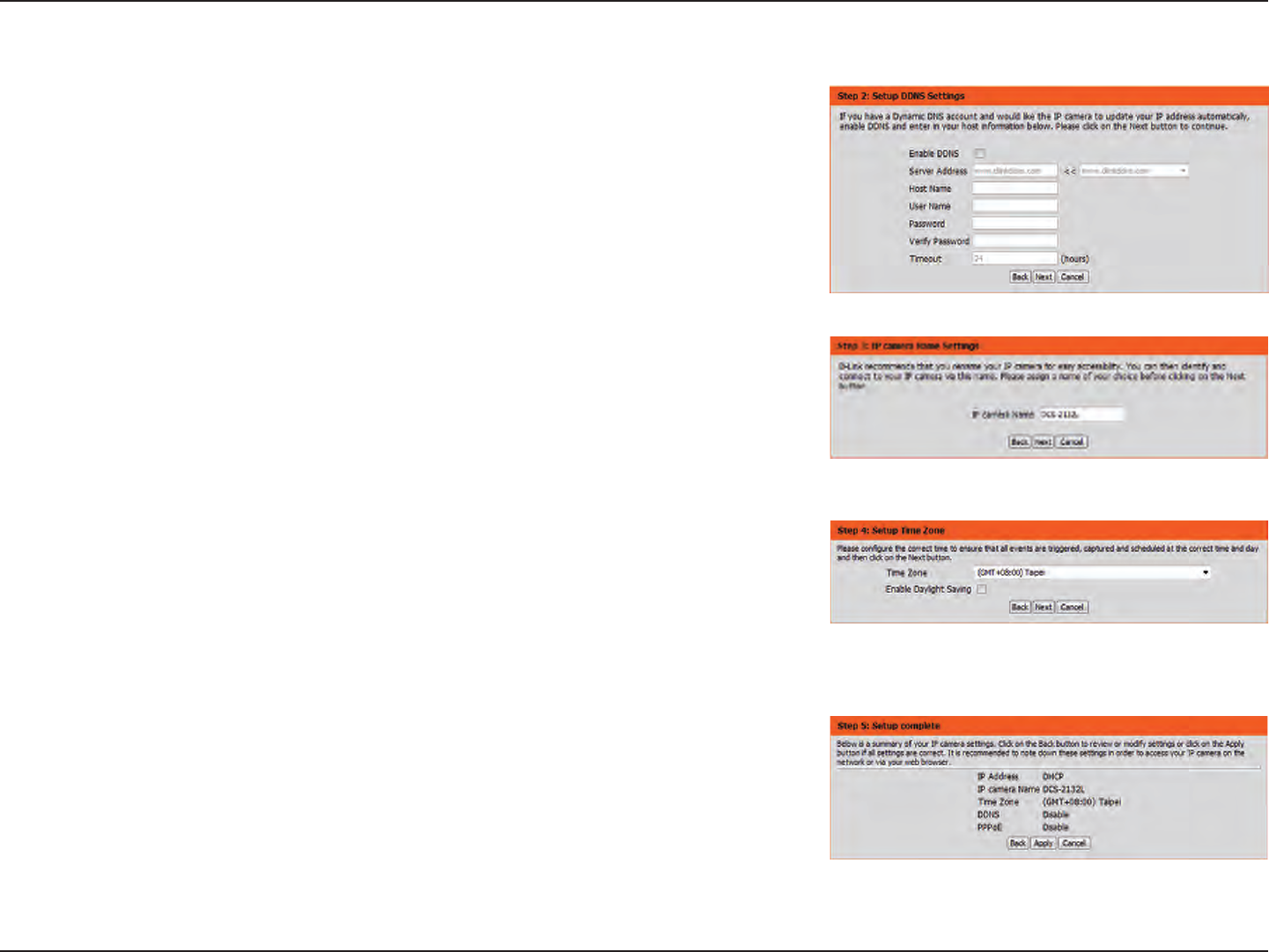
24D-Link DCS-4201 User Manual
Section 3: Conguration
If you have a Dynamic DNS account and would like the camera to update your IP address
automatically, Select Enable DDNS and enter your host information. Click Next to continue.
Enter a name for your camera and click Next to continue.
Congure the correct time to ensure that all events will be triggered as scheduled. Click Next
to continue.
If you have selected DHCP, you will see a summary of your settings, including the camera's IP
address. Please write down all of this information as you will need it in order to access your
camera.
Click Apply to save your settings.
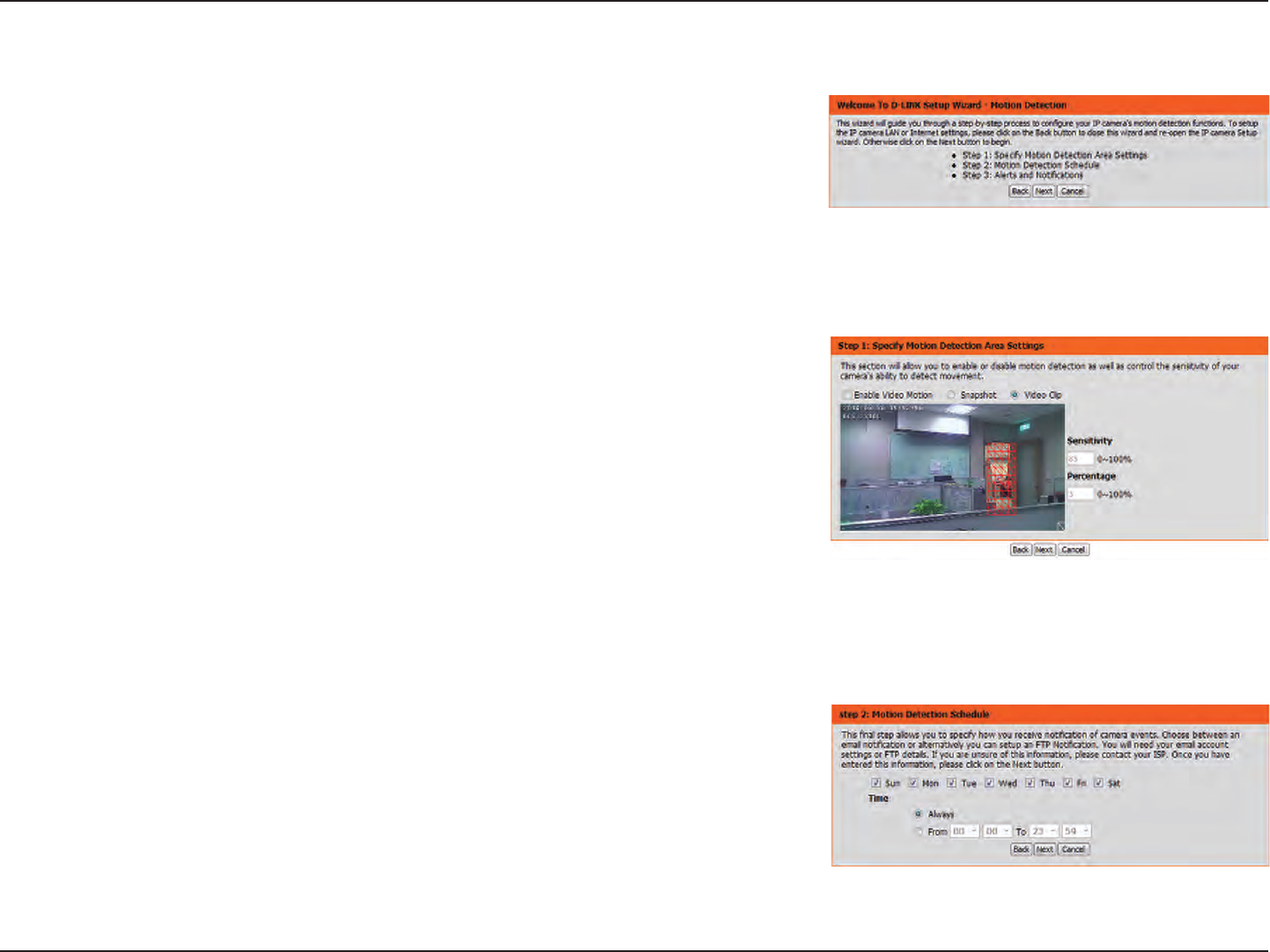
25D-Link DCS-4201 User Manual
Section 3: Conguration
This wizard will guide you through a step-by-step process to congure your camera's
motion detection functions.
Click Next to continue.
Step 1
This step will allow you to enable or disable motion detection, specify the detection sensitivity,
and adjust the camera’s ability to detect movement.
You may specify whether the camera should capture a snapshot or a video clip when motion
is detected.
Please see the Motion Detection section on "Motion Detection" on page 39 for information
about how to congure motion detection.
Step 2
This step allows you to enable motion detection based on a customized schedule. Specify the
day and hours. You may also choose to always record whenever motion is detected.
Motion Detection Setup Wizard

26D-Link DCS-4201 User Manual
Section 3: Conguration
Step 3
This step allows you to specify how you will receive event notications from your camera. You
may choose not to receive notications, or to receive notications via e-mail or FTP.
Please enter the relevant information for your e-mail or FTP account.
Click Next to continue.
Step 4
You have completed the Motion Detection Wizard.
Please verify your settings and click Apply to save them.
Please wait a few moments while the camera saves your settings and restarts.

27D-Link DCS-4201 User Manual
Section 3: Conguration
Network Setup
Use this section to congure the network connections for your camera. All relevant information must be entered accurately. After making any
changes, click the Save Settings button to save your changes.
LAN Settings:
DHCP:
Static IP Client:
IP Address:
Subnet Mask:
Default Router:
Primary DNS:
Secondary DNS:
This section lets you congure settings for your local
area network.
Select this connection if you have a DHCP server running
on your network and would like your camera to obtain
an IP address automatically.
If you choose DHCP, you do not need to ll out the IP
address settings.
You may obtain a static or xed IP address and other
network information from your network administrator
for your camera. A static IP address may simplify access
to your camera in the future.
Enter the xed IP address in this eld.
This number is used to determine if the destination is in
the same subnet. The default value is 255.255.255.0.
The gateway used to forward frames to destinations in a
dierent subnet. Invalid gateway settings may cause the
failure of transmissions to a dierent subnet.
The primary domain name server translates names to IP
addresses.
The secondary DNS acts as a backup to the primary DNS.
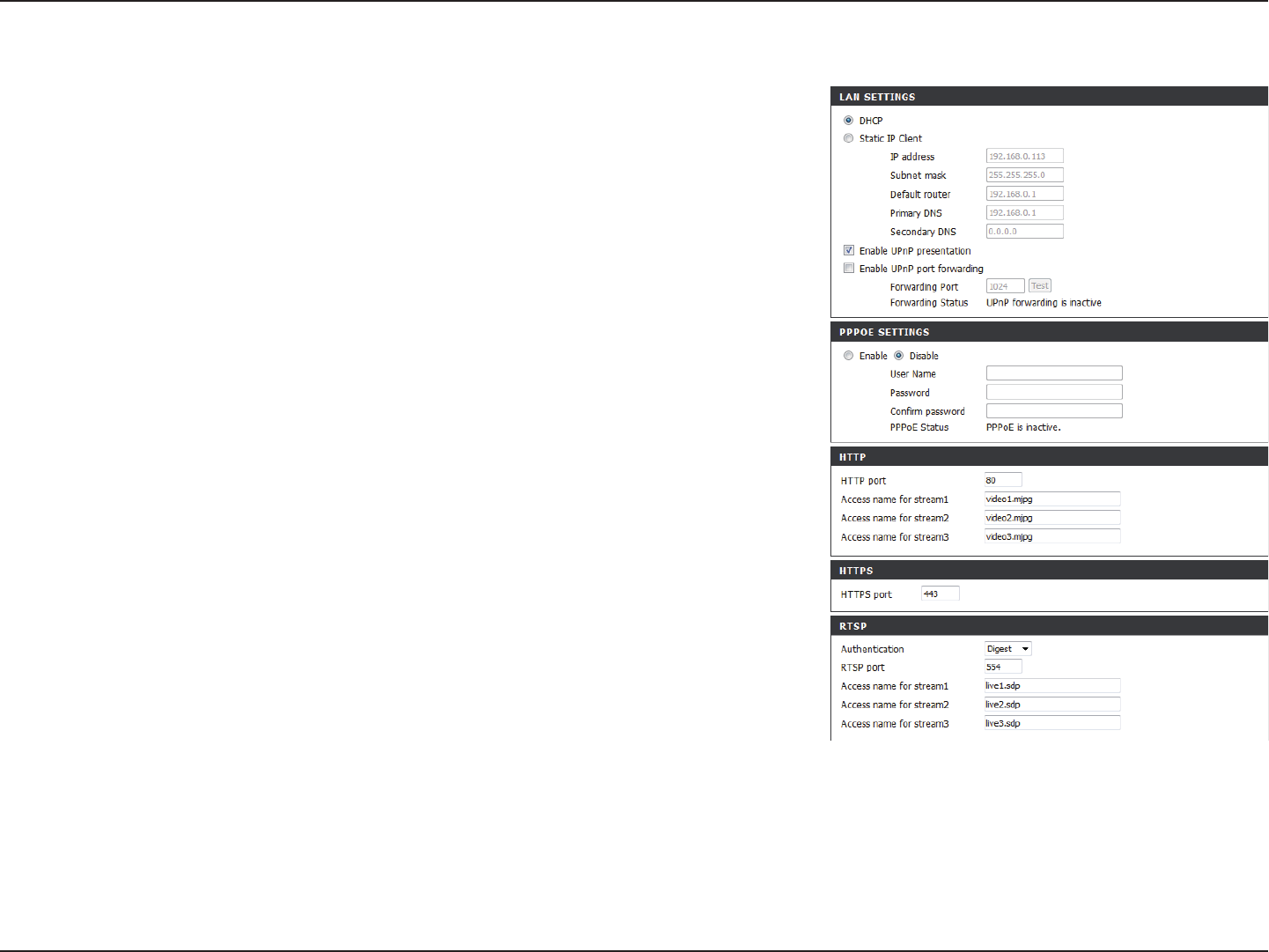
28D-Link DCS-4201 User Manual
Section 3: Conguration
Enable UPnP Presentation:
Enable UPnP Port Forwarding:
PPPoE Settings:
User Name / Password:
HTTP Port:
Access Name for Stream 1~3:
HTTPS Port:
RTSP Port:
Enabling this setting allows your camera to be congured
as a UPnP device on your network.
Enabling this setting allows the camera to add port
forwarding entries into the router automatically on a
UPnP capable network.
Enable this setting if your network uses PPPoE.
Enter the username and password for your PPPoE
account. Re-enter your password in the Conrm
Password eld. You may obtain this information from
your ISP.
The default port number is 80.
The default name is video#.mjpg, where # is the number
of the stream.
You may use a PC with a secure browser to connect to
the HTTPS port of the camera. The default port number
is 443.
The port number that you use for RTSP streaming to
mobile devices, such as mobile phones or PDAs. The
default port number is 554. You may specify the address
of a particular stream. For instance, live1.sdp can be
accessed at rtsp://x.x.x.x/video1.sdp where the x.x.x.x
represents the IP address of your camera.
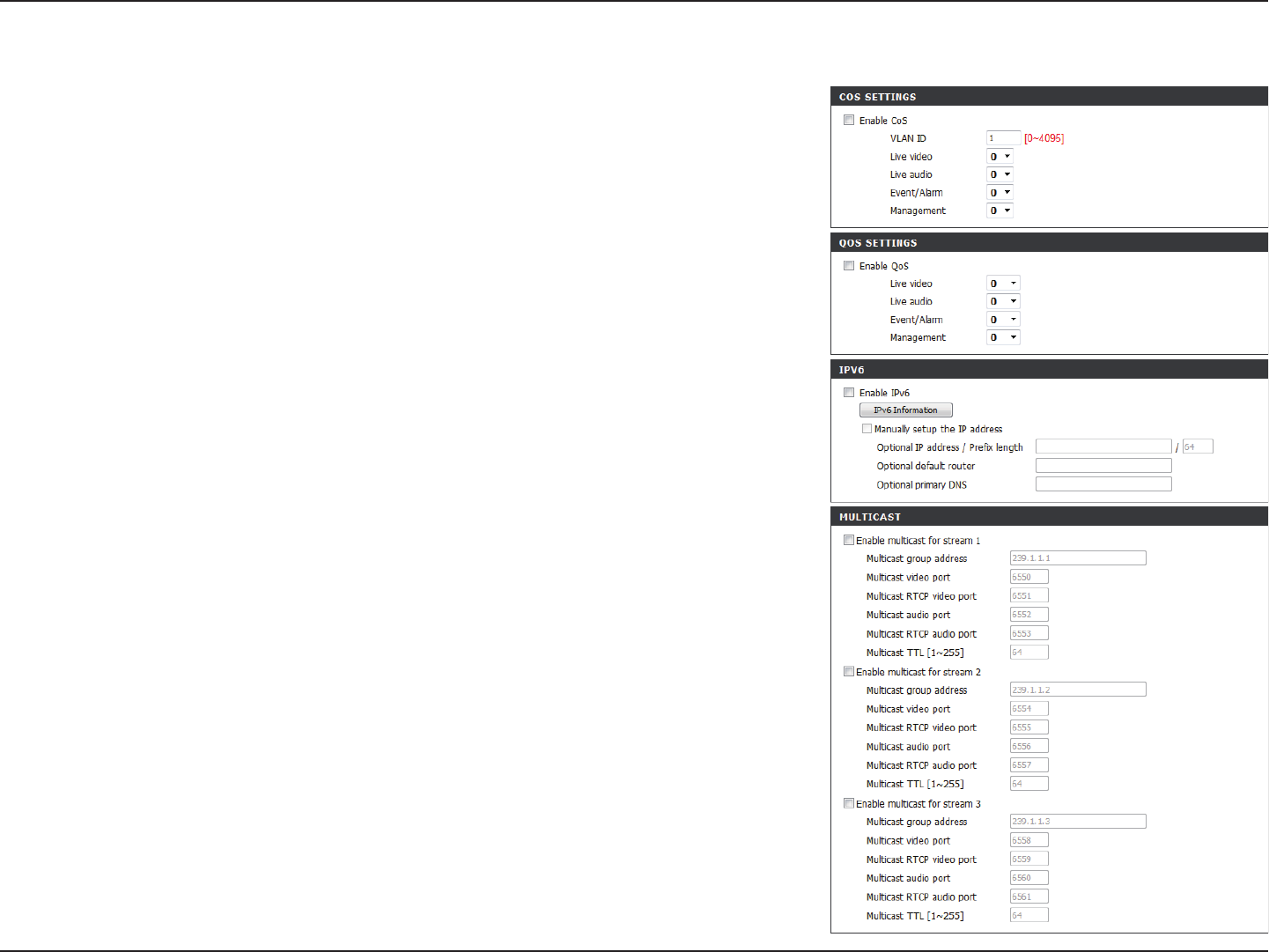
29D-Link DCS-4201 User Manual
Section 3: Conguration
Enable CoS:
Enable QoS:
Enable IPV6:
Enable Multicast for stream
Enabling the Class of Service setting implements a
best-eort policy without making any bandwidth
reservations.
Enabling QoS allows you to specify a trac priority
policy to ensure a consistent Quality of Service during
busy periods. If the Network Camera is connected to a
router that itself implements QoS, the router's settings
will override the QoS settings of the camera.
Enable the IPV6 setting to use the IPV6 protocol. Enabling
the option allows you to manually set up the address,
specify an optional IP address, specify an optional router
and an optional primary DNS.
The DCS-4201 allows you to multicast each of the
available streams via group address and specify the TTL
value for each stream. Enter the port and TTL settings
you wish to use if you do not want to use the defaults.

30D-Link DCS-4201 User Manual
Section 3: Conguration
Enable Bonjour:
Bonjour Name:
Enable this to allow other network devices to connect to
this camera using Bonjour.
Enter the name to identify this camera on Bonjour.
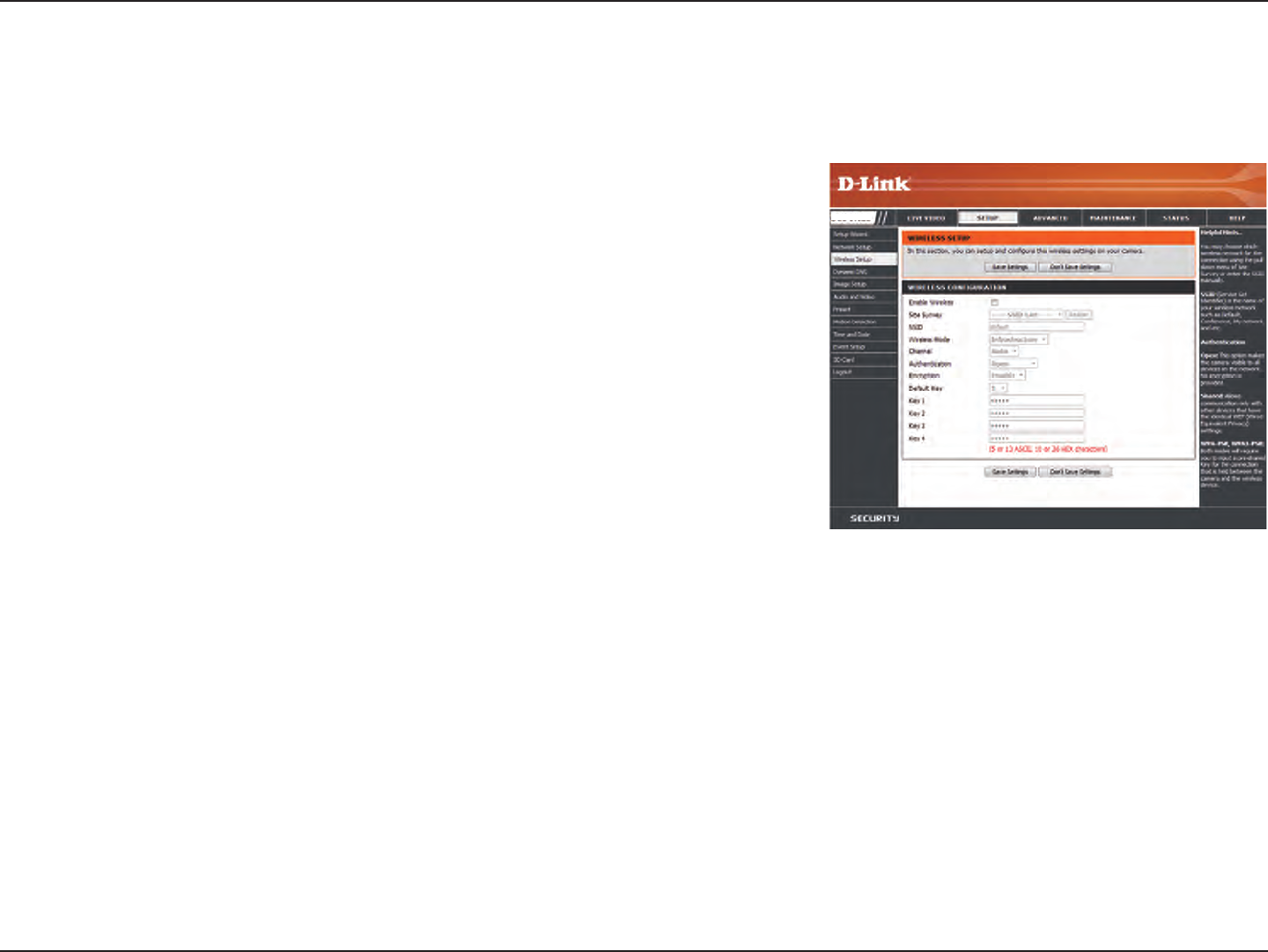
31D-Link DCS-4201 User Manual
Section 3: Conguration
Wireless Setup
This section allows you to set up and congure the wireless settings on your camera. After making any changes, click the Save Settings button to
save your changes.
Site Survey:
SSID:
Wireless Mode:
Channel:
Authentication:
Encryption:
Key:
Click the Rescan button to scan for available wireless
networks. After scanning, you can use the drop-down
box to select an available wireless network. The related
information (SSID, Wireless Mode, Channel, Authentication,
Encryption) will be automatically lled in for you.
Enter the SSID of the wireless access point you wish to
use.
Use the drop-down box to select the mode of the
wireless network you wish to connect to. Infrastructure
is normally used to connect to an access point or router.
Ad-Hoc is usually used to connect directly to another
computer.
If you are using Ad Hoc mode, select the channel of the
wireless network you wish to connect to, or select Auto.
Select the authentication you use on your wireless
network - Open, Shared, WPA-PSK, or WPA2-PSK.
If you use WPA-PSK or WPA2-PSK authentication, you
will need to specify whether your wireless network
uses TKIP or AES encryption. If you use Open or Shared
authentication, WEP encryption should be the setting.
If you use WEP, WPA-PSK, or WPA2-PSK authentication,
enter the Key (also known as password) used for your
wireless network.
DCS-4201
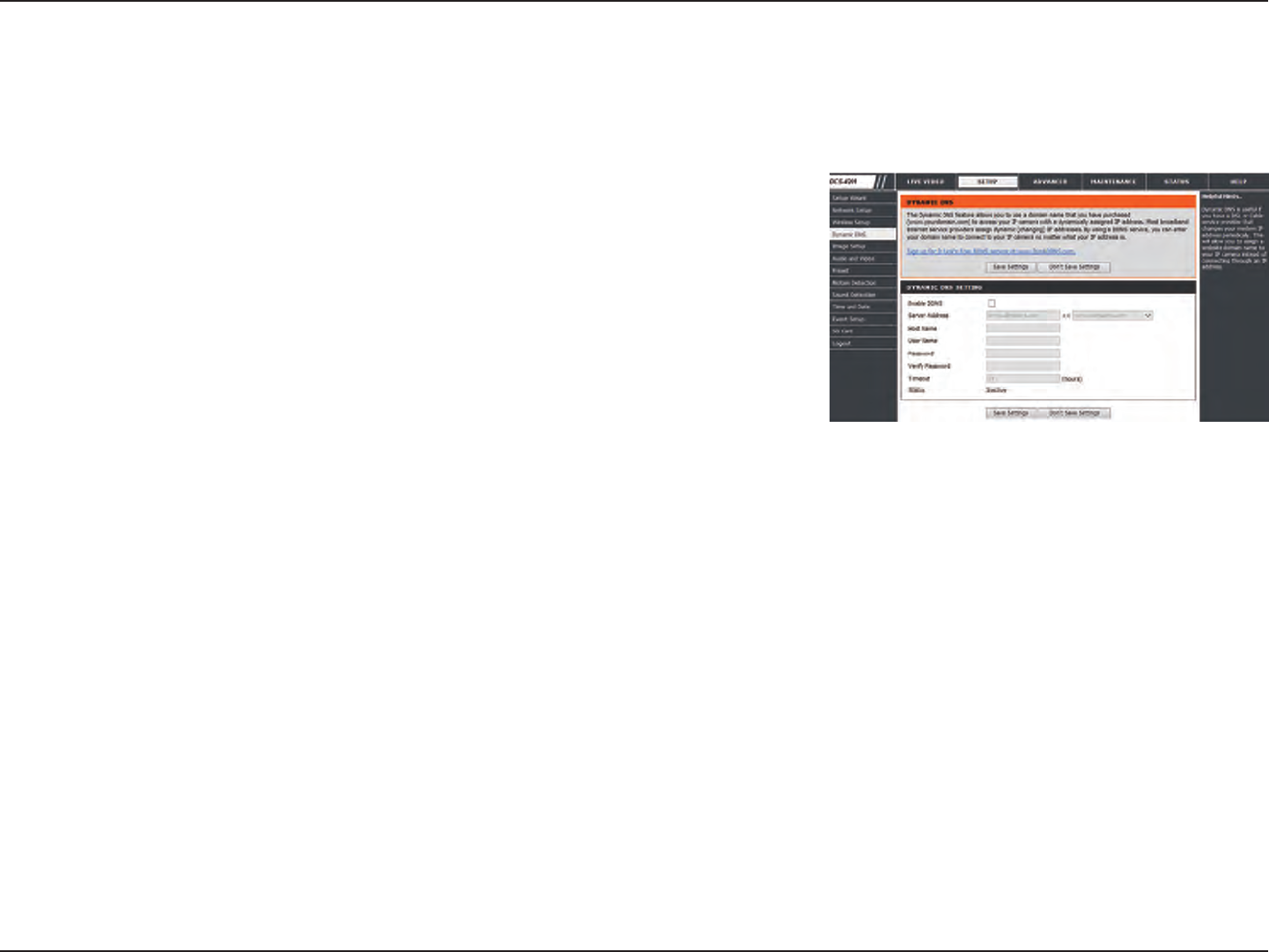
32D-Link DCS-4201 User Manual
Section 3: Conguration
Dynamic DNS
DDNS allows you to access your camera using a domain name instead of an IP address. To do this, you will need to have an account with one of the
DDNS services listed in the drop-down box on this page.
Enable DDNS:
Server Address:
Host Name:
User Name:
Password:
Timeout:
Status:
Select this checkbox to enable the DDNS function.
Select your Dynamic DNS provider from the pull down
menu or enter the server address manually.
Enter the host name of the DDNS server.
Enter the user name or e-mail used to connect to your
DDNS account.
Enter the password used to connect to your DDNS
server account.
Enter the DNS timeout values you wish to use.
Indicates the connection status, which is automatically
determined by the system.
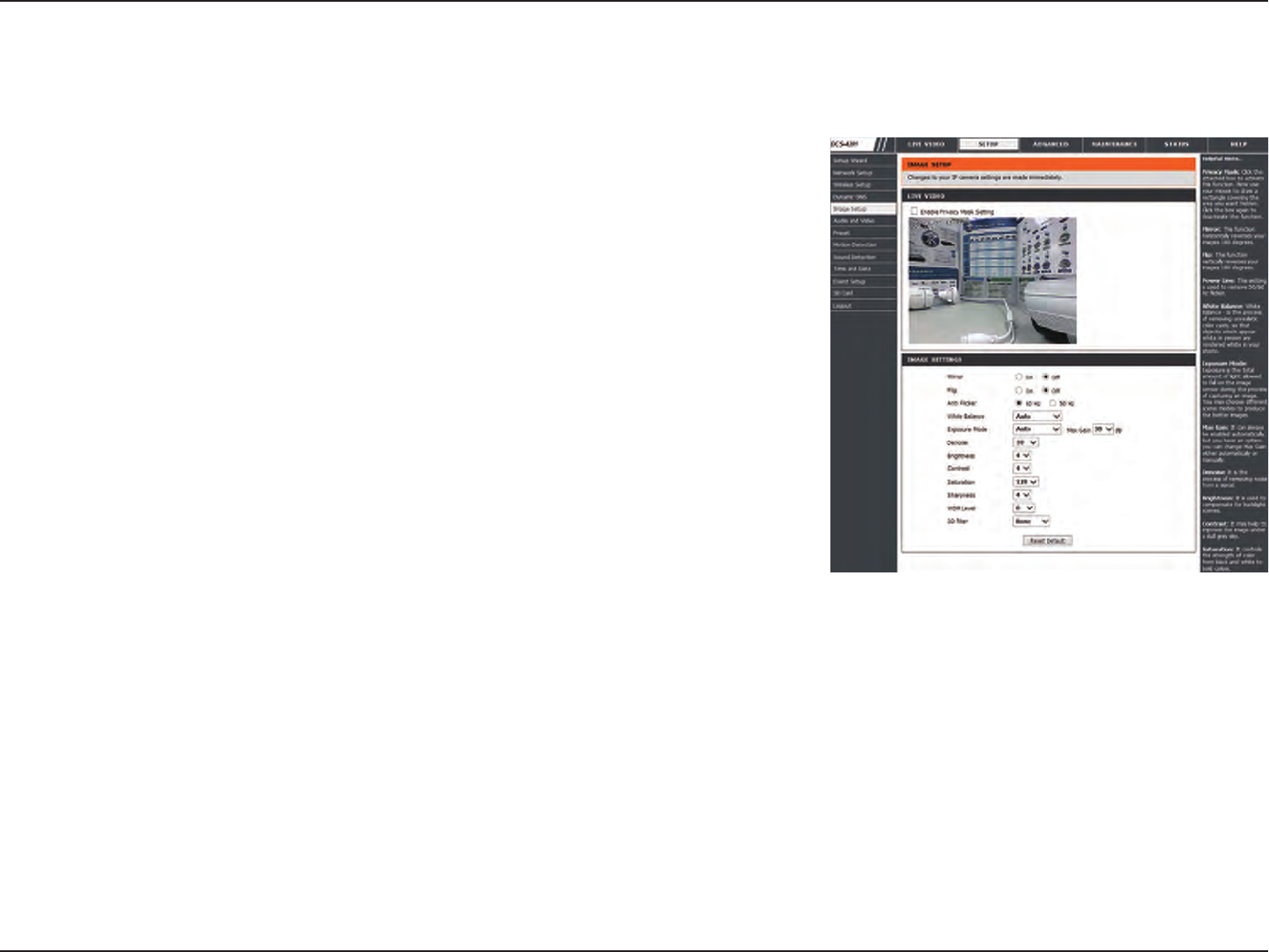
33D-Link DCS-4201 User Manual
Section 3: Conguration
Image Setup
In this section, you may congure the video image settings for your camera. A preview of the image will be shown in Live Video.
Enable Privacy Mask Setting:
Anti Flicker:
Mirror:
Flip:
Power Line:
White Balance:
The Privacy Mask setting allows you to specify up to 3
rectangular areas on the camera's image to be blocked/
excluded from recordings and snapshots.
You may click and drag the mouse cursor over the
camera image to draw a mask area. Right clicking on the
camera image brings up the following menu options:
Disable All: Disables all mask areas
Enable All: Enables all mask areas
Reset All: Clears all mask areas.
If the video ickers, try enabling this setting.
This will mirror the image horizontally.
This will ip the image vertically. When turning Flip on,
you may want to consider turning Mirror on as well.
Select the frequency used by your power lines to avoid
interference or distortion.
Use the drop-down box to change white balance settings
to help balance colors for dierent environments. You
can choose from Auto, Outdoor, Indoor, Fluorescent, and
Push Hold. Push Hold will save and lock the currently
detected white balance settings when you click Save.
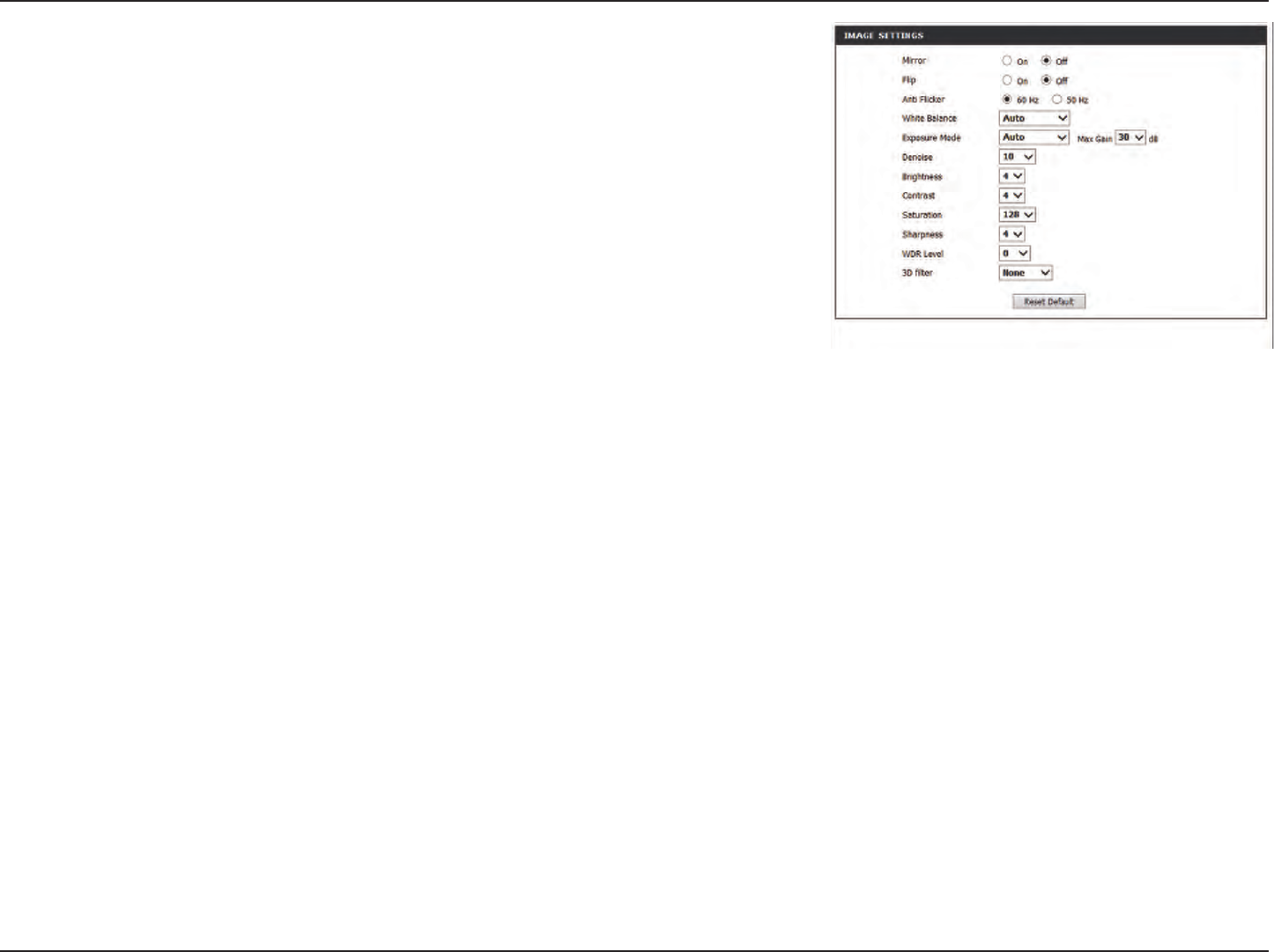
34D-Link DCS-4201 User Manual
Section 3: Conguration
Exposure Mode:
Denoise:
Brightness:
Contrast:
Saturation:
Sharpness:
Reset Default:
WDR Level:
3D ltering:
Changes the exposure mode. Use the drop-down
box to set the camera for Indoor, Outdoor, or Night
environments, or to Moving to capture moving objects.
The Low Noise option will focus on creating a high-
quality picture without noise. You can also create 3
dierent custom exposure modes. The Max Gain setting
will allow you to control the maximum amount of gain
to apply to brighten the picture.
This setting controls the amount of noise reduction that
will be applied to the picture.
Adjust this setting to compensate for backlit subjects.
Adjust this setting to alter the color intensity/strength.
This setting controls the amount of coloration, from
grayscale to fully saturated.
Specify a value from 0 to 8 to specify how much
sharpening to apply to the image.
Click this button to reset the image to factory default
settings.
WDR makes it easier to see objects that may appear dark
due to strong backlighting conditions during the daytime.
Higher WDR levels will make it easier to see objects in
shadows.
3D ltering reduces the amount of image noise when
viewing a low-light environment. Higher levels of 3D
ltering will apply stronger levels of noise reduction.
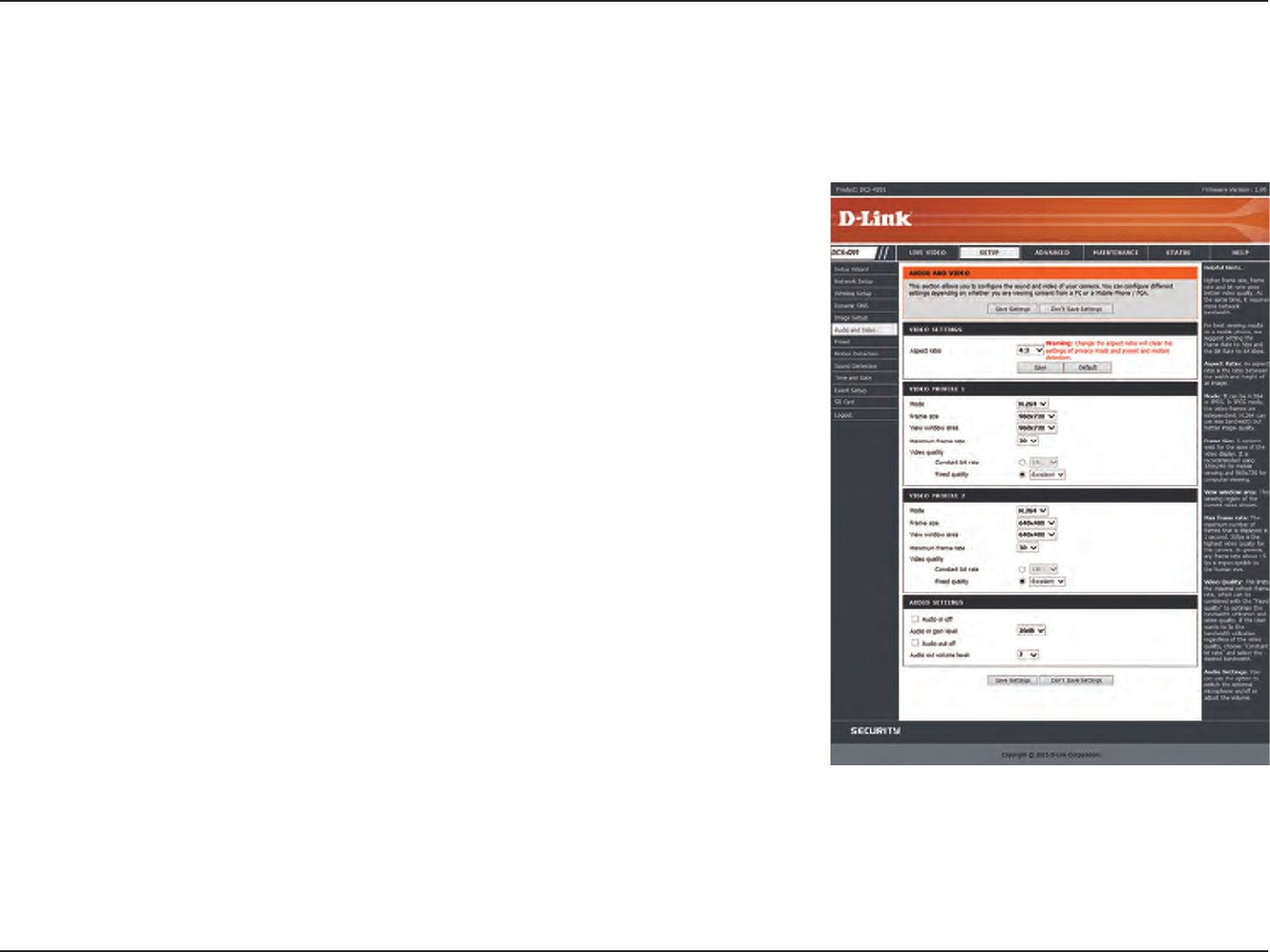
35D-Link DCS-4201 User Manual
Section 3: Conguration
Audio and Video
You may congure up to 3 video proles with dierent settings for your camera. Hence, you may set up dierent proles for your computer and
mobile display. In addition, you may also congure the two-way audio settings for your camera. After making any changes, click the Save Settings
button to save your changes.
Aspect ratio:
Mode:
Frame size / View window area:
Maximum frame rate:
Video Quality:
Set the aspect ratio of the video to 4:3 standard or 16:9
widescreen.
Set the video codec to be used to MJPEG or H.264.
Frame size determines the total capture resolution, and
View window area determines the Live Video viewing
window size. If the Frame size is larger than the Live
Video size, you can use the ePTZ controls to look around.
16:9 1280 x 720, 800 x 448, 640 x 360, 480 x 272,
320 x 176
4:3 960 x 720, 800 x 592, 640 x 480, 480 x 352,
320 x 240
Note: If your View window area is the same as your Frame
size, you will not be able to use the ePTZ function.
A higher frame rate provides smoother motion for
videos, and requires more bandwidth. Lower frame
rates will result in stuttering motion, and requires less
bandwidth.
This limits the maximum bandwidth, which can be
combined with the "Fixed quality" option to optimize
the bandwidth utilization and video quality. If xed
bandwidth utilization is desired regardless of the video
quality, choose "Constant bit rate" and select the desired
bandwidth.
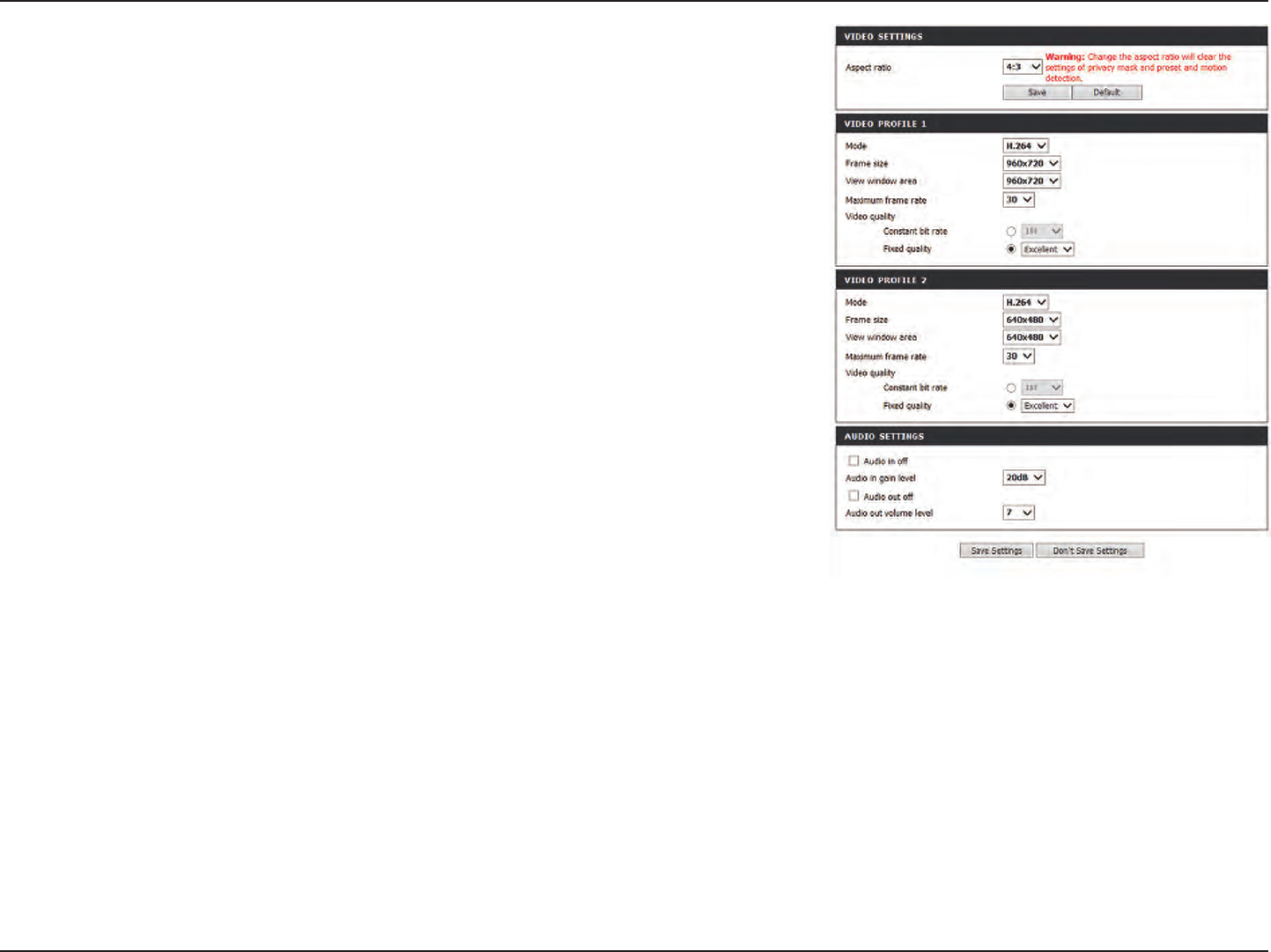
36D-Link DCS-4201 User Manual
Section 3: Conguration
Constant bit rate:
Fixed quality:
Audio in o:
Audio in gain level:
Audio out o:
Audio out volume level:
The bps will aect the bit rate of the video recorded
by the camera. Higher bit rates result in higher video
quality.
Select the image quality level for the camera to try to
maintain. High quality levels will result in increased bit
rates.
Selecting this checkbox will mute incoming audio.
This setting controls the amount of gain applied to
incoming audio to increase its volume.
Selecting this checkbox will mute outgoing audio.
This setting controls the amount of gain applied to
outgoing audio to increase its volume.
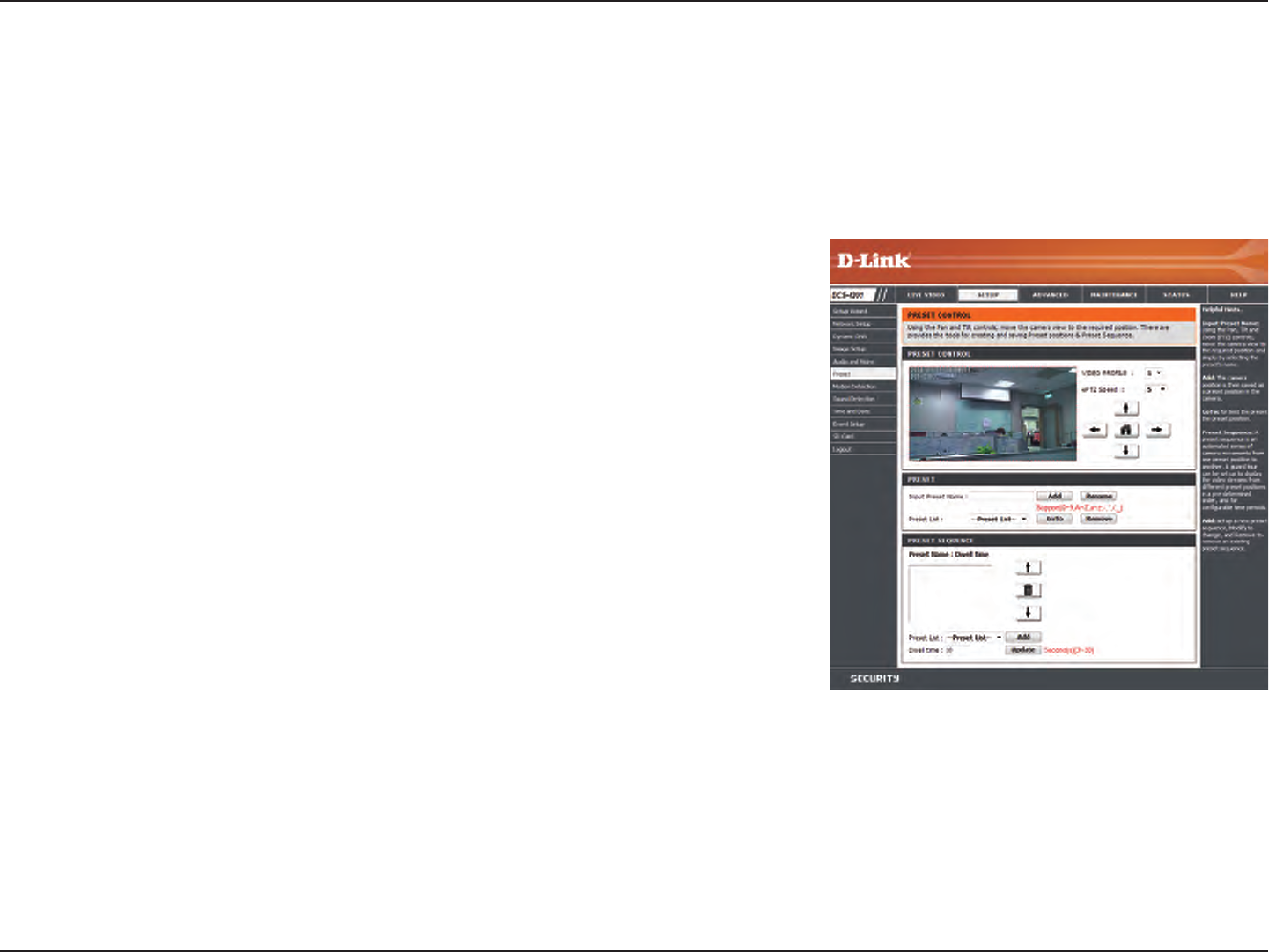
37D-Link DCS-4201 User Manual
Section 3: Conguration
Preset
This screen allows you to set preset points for the ePTZ function of the camera, which allows you to look around the camera's viewable area by
using a zoomed view. Presets allow you to quickly go to and view a specic part of the area your camera is covering, and you can create preset
sequences, which will automatically change the camera's view between the dierent presets according to a dened order and timing you can set.
Note: If your View window area is the same as your Frame size, you will not be able to use the ePTZ function.
Video Prole:
ePTZ Speed:
Arrow Buttons and Home Button:
Input Preset Name:
Preset List:
Preset Sequence:
This selects which video prole to use.
You may select a value between 0 and 64. 0 is the slowest
and 64 is the fastest.
Use these buttons to move to a specic part of the
viewing area, which you can then set as a preset. Click
the Home button to return to the center of the viewing
area.
Enter the name of the preset you want to create, then
click the Add button to make a new preset. If an existing
preset has been selected from the Preset List, you can
change its name by typing in a new name, then clicking
the Rename button.
Click this drop-down box to see a list of all the presets
that have been created. You can select one, then click
the GoTo button to change the displayed camera view
to the preset. Clicking the Remove button will delete
the currently selected preset.
This section allows you to create a preset sequence,
which automatically moves the camera's view between
a set of preset views.
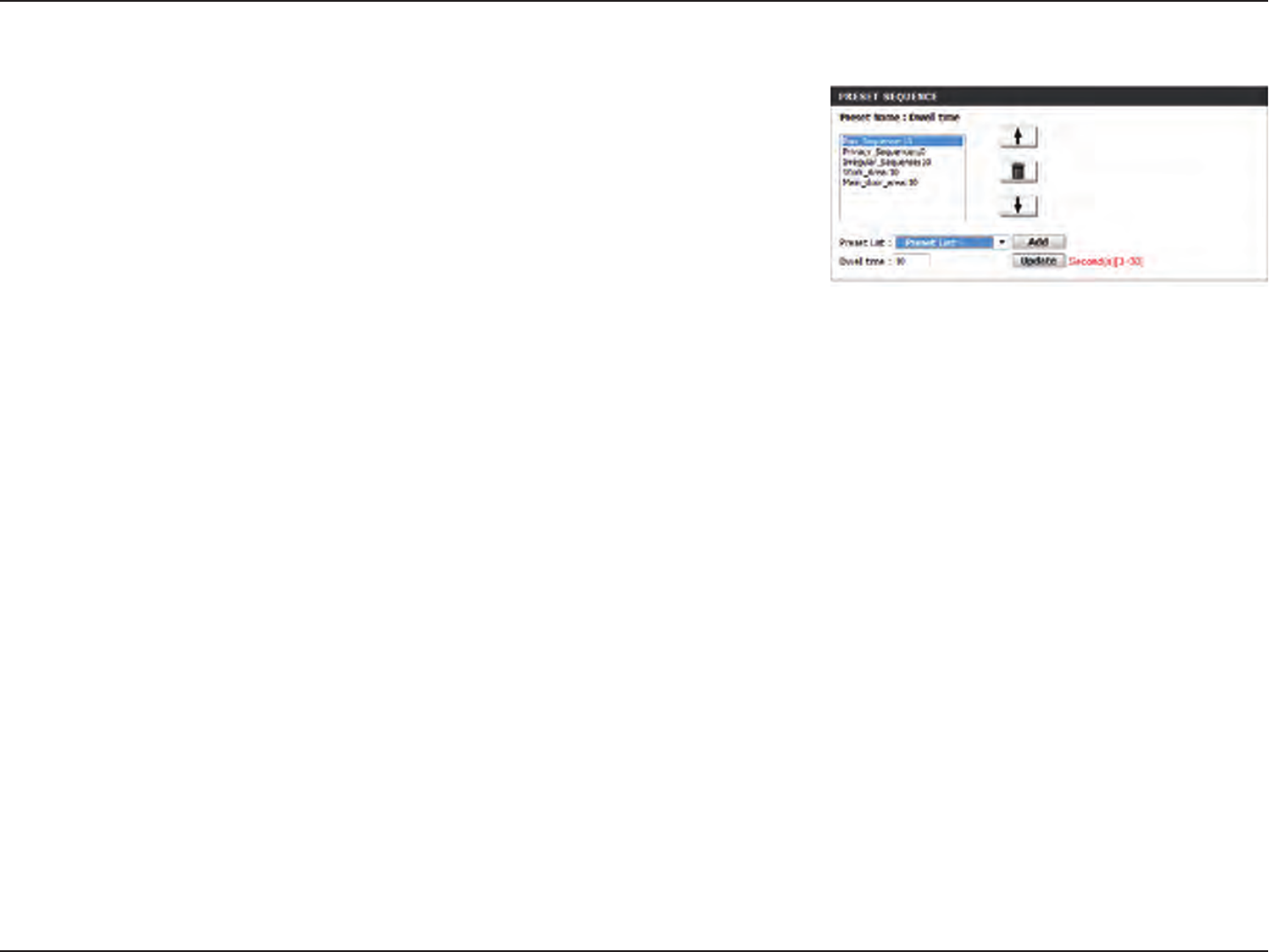
38D-Link DCS-4201 User Manual
Section 3: Conguration
Preset List: To add a preset to the sequence, select it from the drop-
down box at the bottom of this window, set the Dwell
time to determine how long the camera view will stay at
that preset, then click the Add button. The preset name
will appear in the list, followed by the dwell time to view
that preset for.
You can rearrange your presets in the sequence by
selecting a preset in the sequence, then clicking the
arrow buttons to move it higher or lower in the current
sequence.
Clicking the trash can button will remove the currently
selected preset from the sequence.
If you want to change the dwell time for a preset, select
it from the list, enter a new dwell time, then click the
Update button.

39D-Link DCS-4201 User Manual
Section 3: Conguration
Motion Detection
Motion detection enables the camera to monitor the video feed for movement. Here, you can adjust the sensitivity and percentage settings, which
work together to determine whether motion is detected by the camera or not. After making any changes, click the Save Settings button to save
your changes.
Enable Video Motion:
Enable PIR:
Sensitivity:
Select this box to enable the motion detection feature
of your camera.
Select this box to enable Passive Infrared detection.
Species how sensitive motion detection will be from
0% to 100%. A low sensitivity setting means that there
must be large changes between two images in order to
detect motion, and a high sensitivity setting means that
even small changes will cause motion to be detected.
Low sensitivities may be useful when monitoring an area
that has ickering lights or a window to the outside in
view. High sensitivities may be useful when monitoring
an area that rarely changes, such as a storeroom or
warehouse.
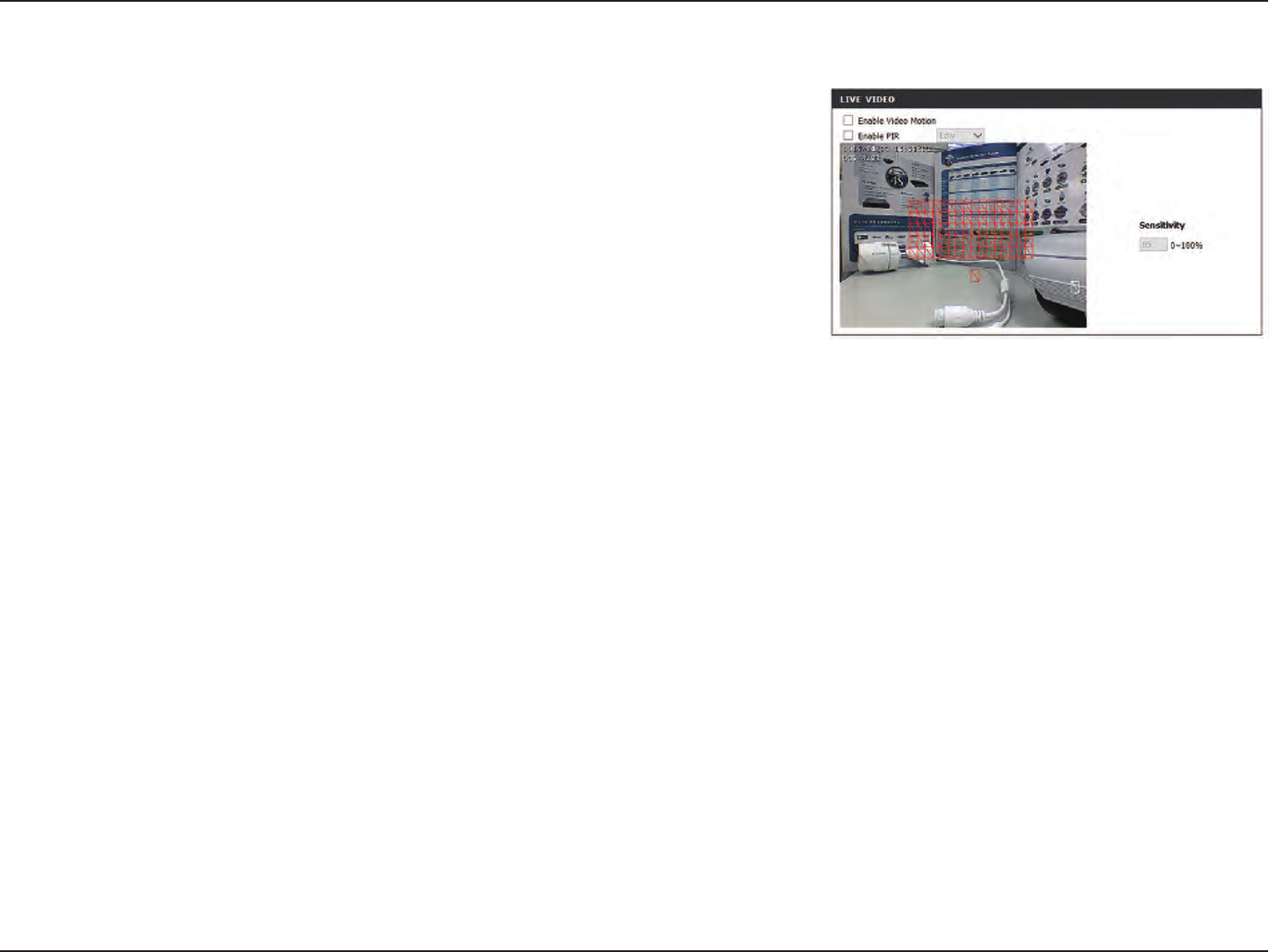
40D-Link DCS-4201 User Manual
Section 3: Conguration
Draw Motion Area:
Erase Motion Area:
Use your mouse to click and drag on the area that you
would like to monitor for motion.
To erase a motion detection area, simply click on the red
square that you wish to remove.
Right clicking on the camera image brings up the
following menu options:
Select All: Draws a motion detection area over the
entire screen.
Clear All: Clears any motion detection areas that
have been drawn.
Restore: Restores the previously specied motion
detection areas.

41D-Link DCS-4201 User Manual
Section 3: Conguration
Sound Detection
Check this box to enable the sound detection feature of
your camera.
Species the measurable level that would indicate
sound. Please enter a value between 50 and 90, the
higher the number the more sensitive the camera will
be to sound.
Sound detection enables the camera to monitor the environment for loud sounds. You may set the volume threshold used to determine whether
sound was detected or not.
Enable Sound Detection:
Detection Level:
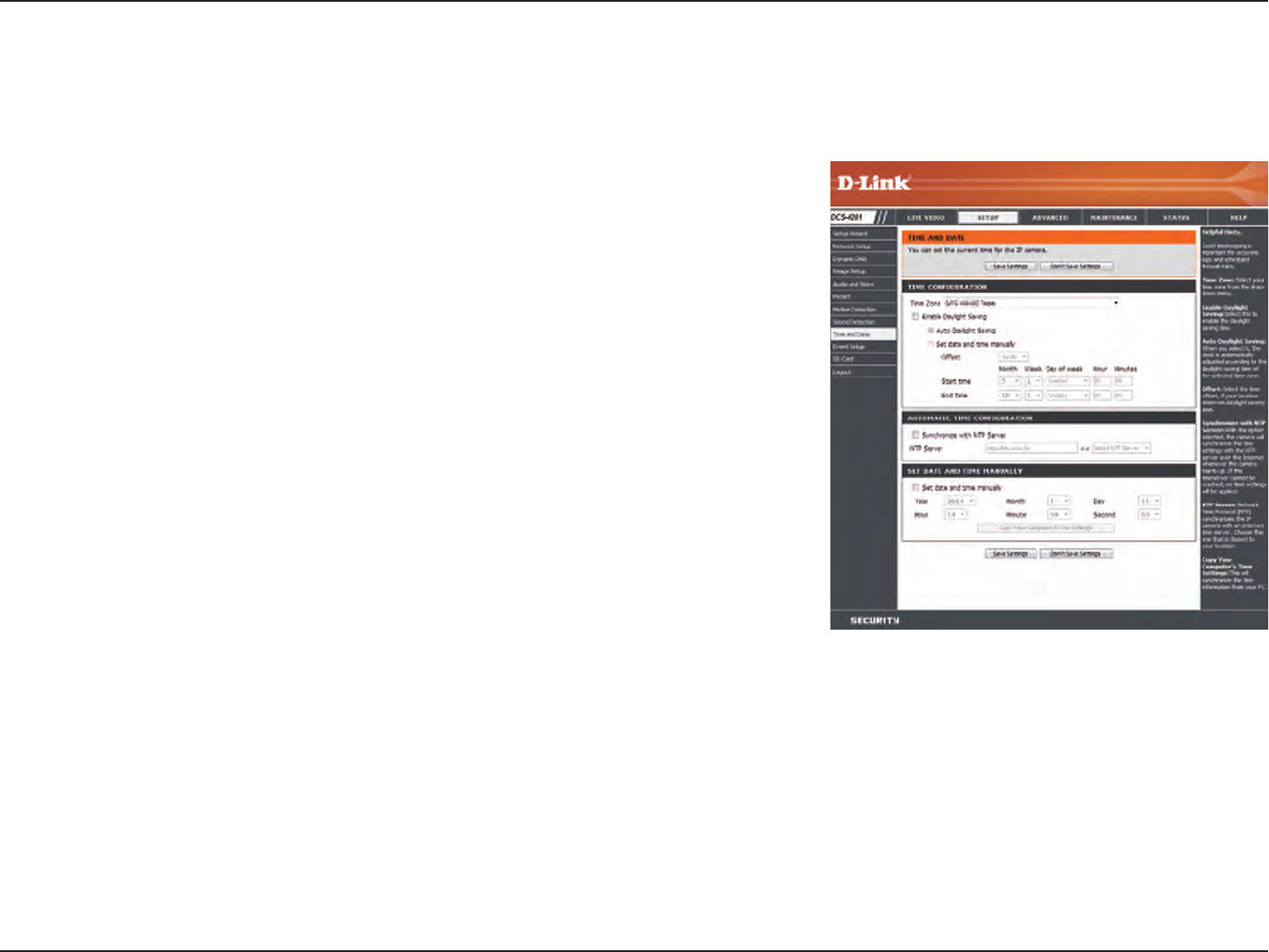
42D-Link DCS-4201 User Manual
Section 3: Conguration
Time and Date
This section allows you to automatically or manually congure, update, and maintain the internal system clock for your camera. After making any
changes, click the Save Settings button to save your changes.
Time Zone:
Enable Daylight Saving:
Auto Daylight Saving:
Set Date and Time Manually:
Oset:
Synchronize with NTP Server:
NTP Server:
Set the Date and Time Manually:
Copy Your Computer's Time
Settings:
Select your time zone from the drop-down menu.
Select this to enable Daylight Saving Time.
Select this option to allow your camera to congure the
Daylight Saving settings automatically.
Selecting this option allows you to congure the Daylight
Saving date and time manually.
Sets the amount of time to be added or removed when
Daylight Saving is enabled.
Enable this feature to set the time automatically by using
an NTP server.
Network Time Protocol (NTP) synchronizes the DCS-4201
with an Internet time server. Choose the one that is
closest to your location.
This option allows you to set the time and date manually.
This will synchronize the time information from your PC.
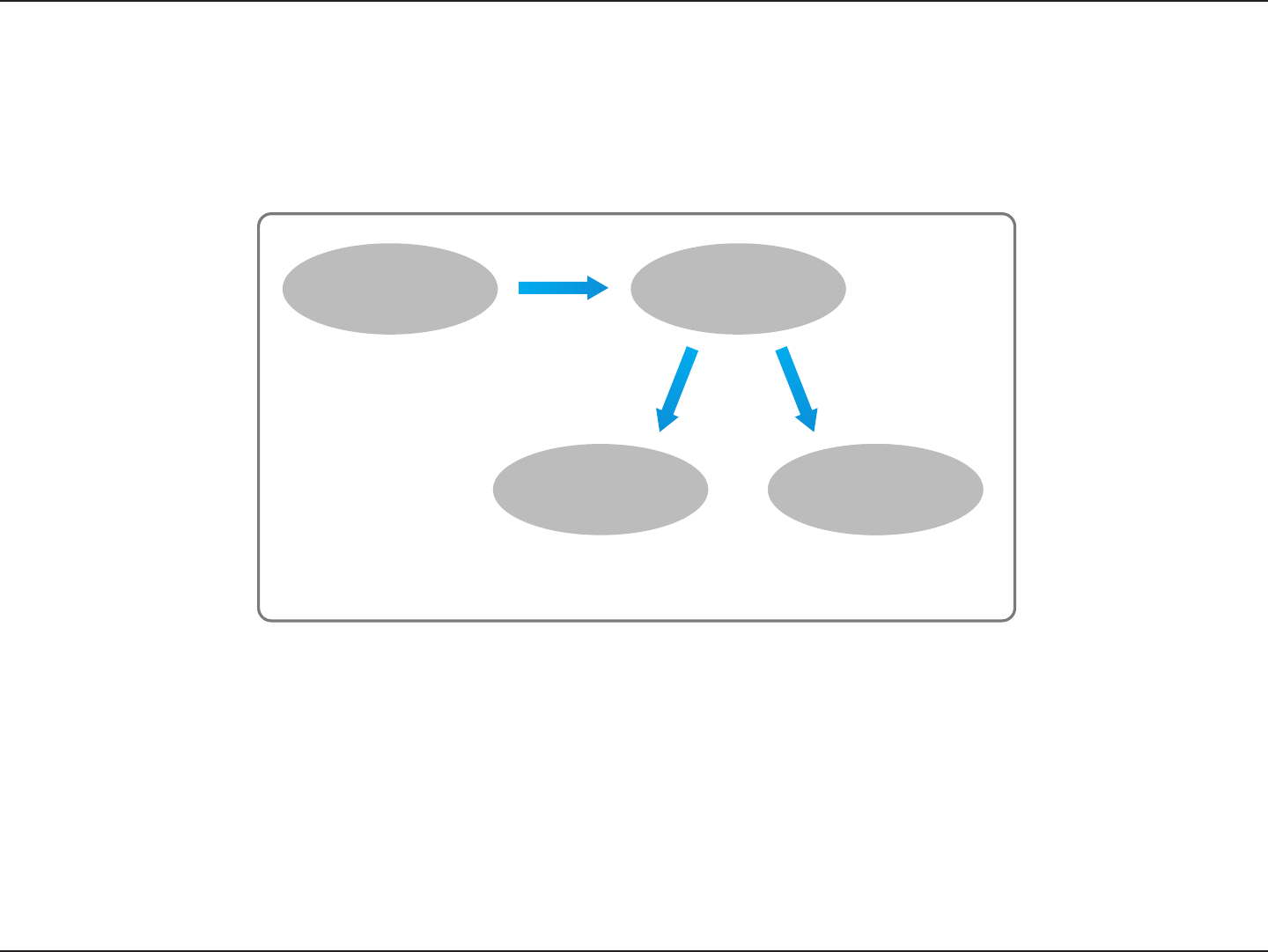
43D-Link DCS-4201 User Manual
Section 3: Conguration
Event Setup
In a typical application, when motion is detected, the DCS-4201 sends images to a FTP server or via e-mail as notications. As shown in the
illustration below, an event can be triggered by many sources, such as motion detection or external digital input devices. When an event is
triggered, a specied action will be performed. You can congure the Network Camera to send snapshots or videos to your e-mail address or FTP
site.
ex.
Motion detection,
Periodically, Digital input,
System reboot
Event Condition
ex.
Snapshot, Video Clips ex.
Email, FTP
Media
(what to send)
Server
(where to send)
Action
To start plotting an event, it is suggested to congure server and media columns rst so that the Network Camera will know what action shall be
performed when a trigger is activated.
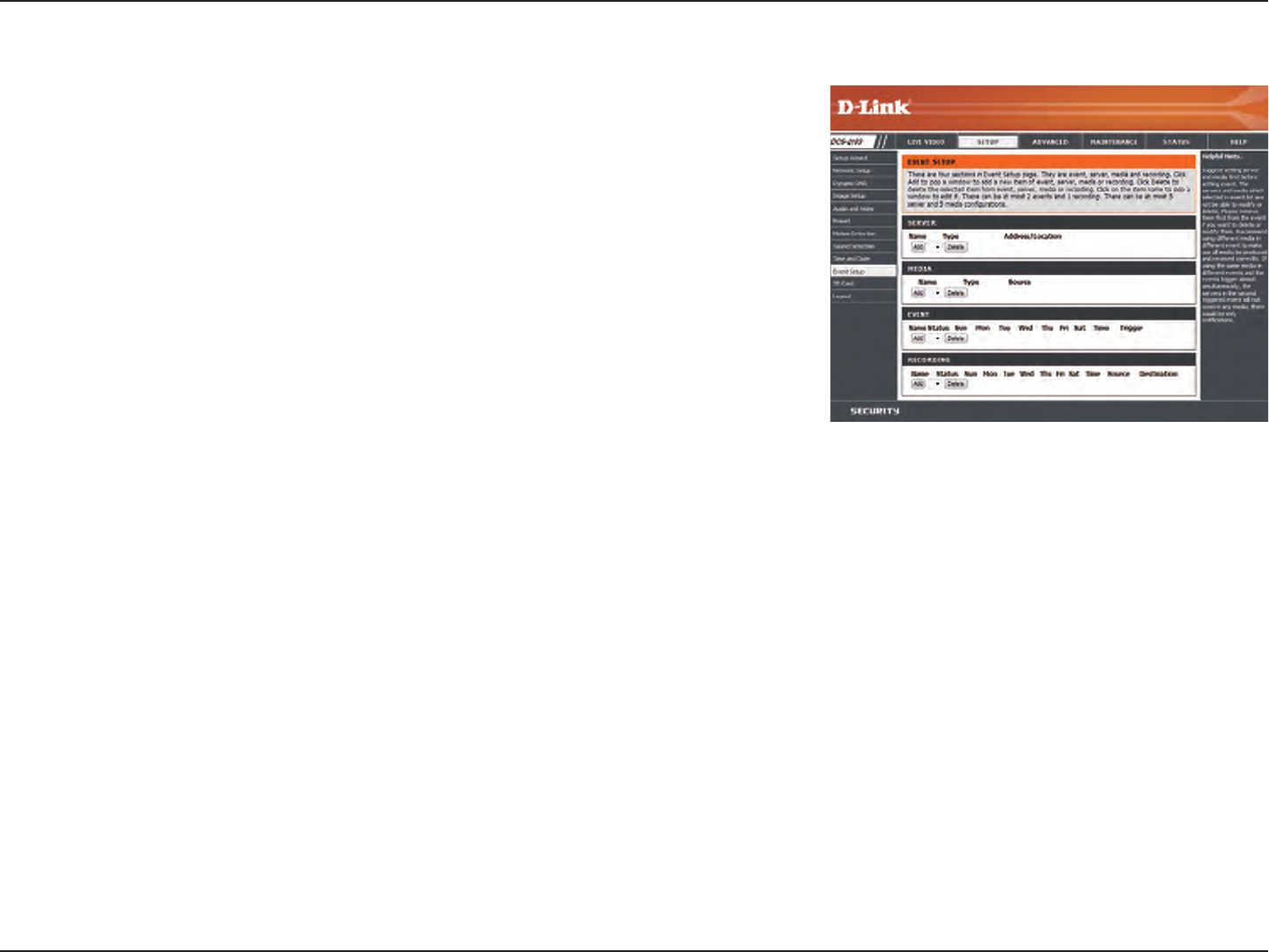
44D-Link DCS-4201 User Manual
Section 3: Conguration
The Event Setup page includes 4 dierent sections.
• Server
• Media
• Event
• Recording
1. To add a new item - "event, server or media," click Add. A screen will appear and allow you
to update the elds accordingly.
2. To delete the selected item from the pull-down menu of event, server or media, click Delete.
3. Click on the item name to pop up a window for modifying.
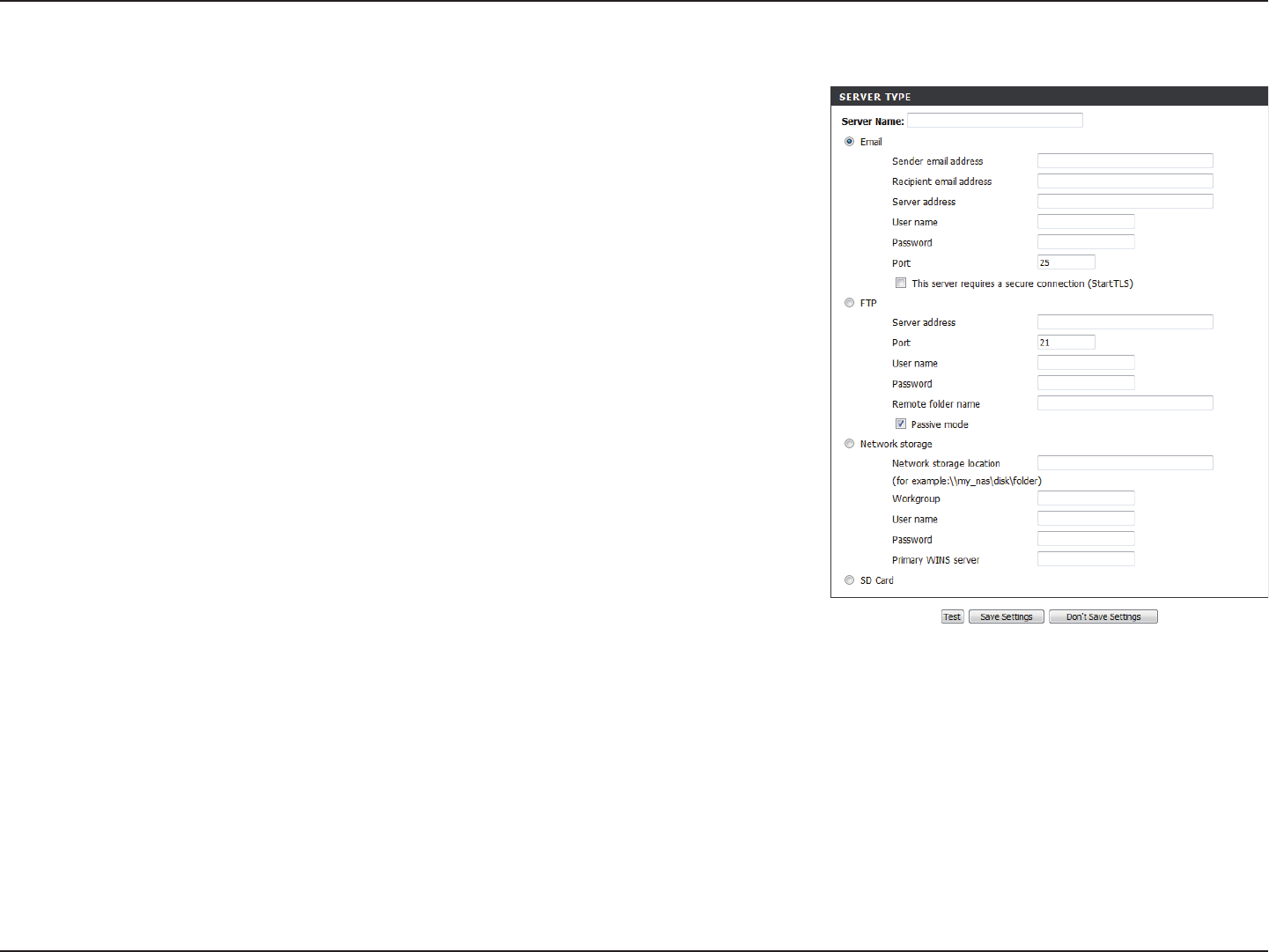
45D-Link DCS-4201 User Manual
Section 3: Conguration
Add Server
Server Name:
E-mail:
FTP:
Network Storage:
SD Card:
Enter the unique name of your server.
Enter the conguration for the target e-mail server
account.
Enter the conguration for the target FTP server account.
Specify a network storage device. Only one network
storage device is supported.
Use the camera's onboard SD card storage.
You can congure up to 5 servers to save snapshots and/or video to. After making any
changes, click the Save Settings button to save your changes.
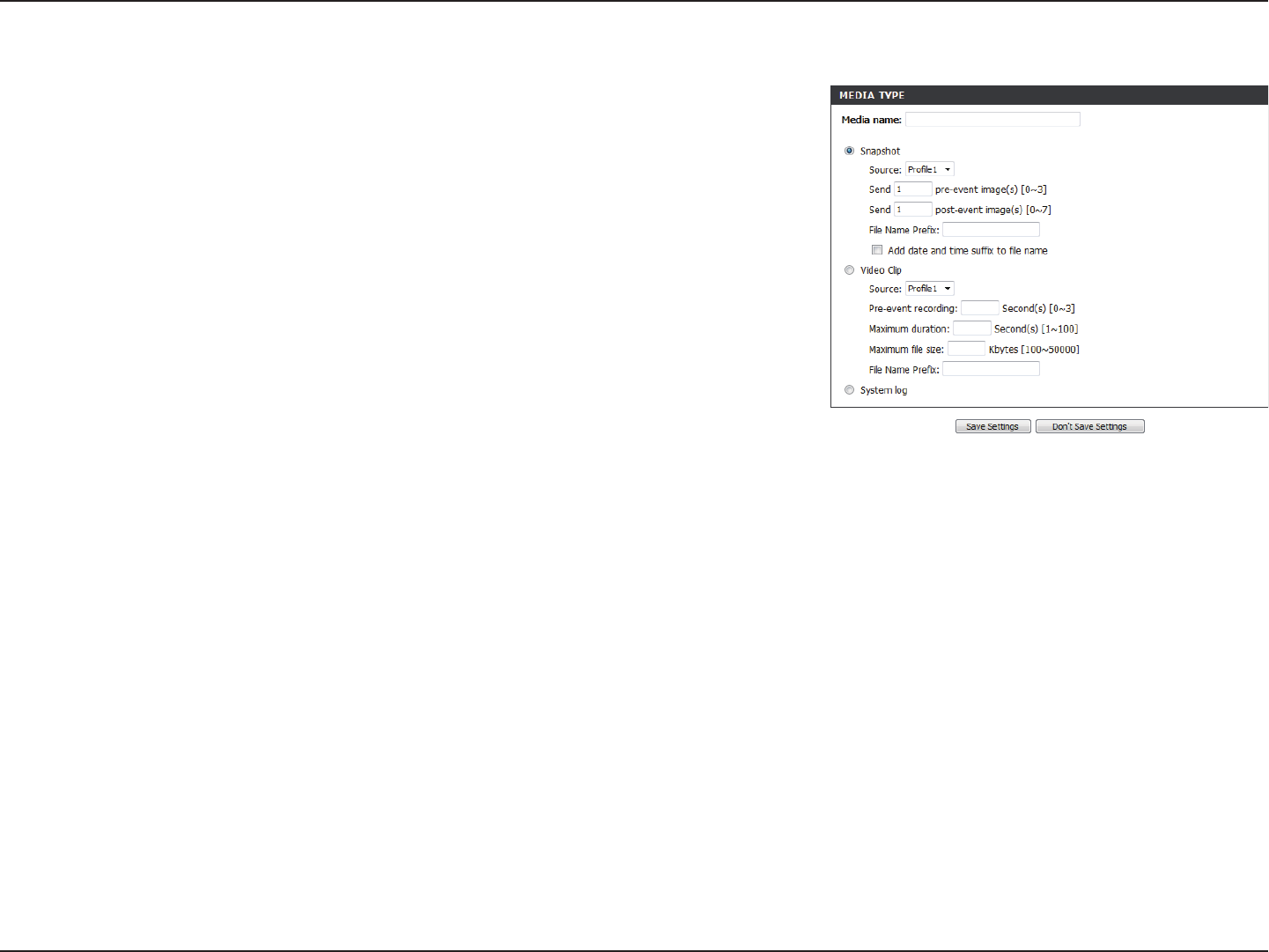
46D-Link DCS-4201 User Manual
Section 3: Conguration
Add Media
Media Name:
Snapshot:
Source:
Send pre-event image(s) [0~4]:
Send post-event image(s) [0~7]:
File name prex:
Add date and time sux to le
name:
Enter a unique name for media type you want to create.
Select this option to set the media type to snapshots.
Set the video prole to use as the media source. Refer to
Audio and Video on "Audio and Video" on page 35 for
more information on video proles.
Set the number of pre-event images to take. Pre-event
images are images taken before the main event snapshot
is taken.
Set the number of post-event images to take. Post-event
images are images taken after the main event snapshot
is taken. You can set up to 7 post-event images to be
taken.
The prex name will be added on the le name.
Check it to add timing information as le name sux.
There are three types of media, Snapshot, Video Clip, and System Log. After making any
changes, click the Save Settings button to save your changes.
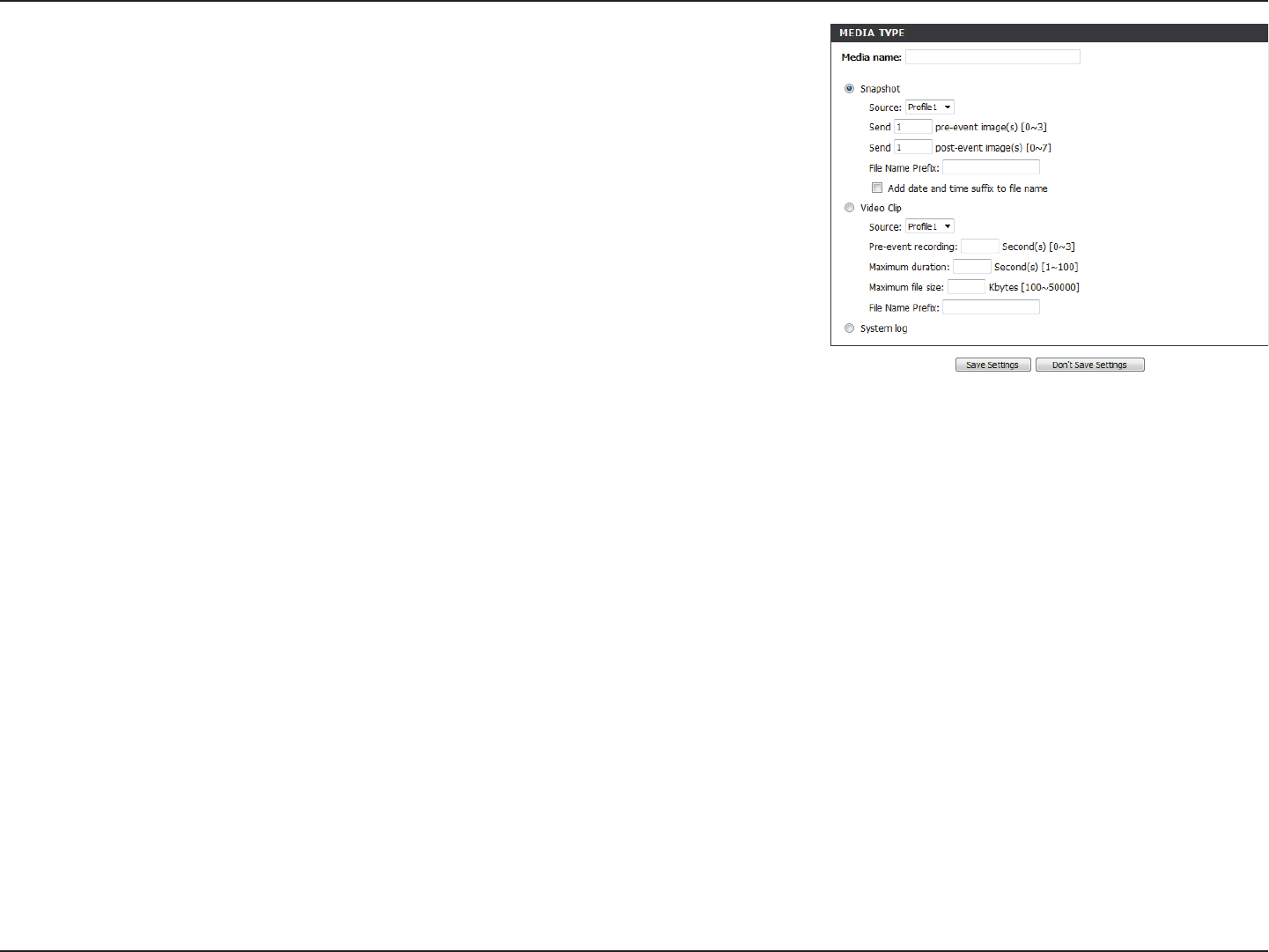
47D-Link DCS-4201 User Manual
Section 3: Conguration
Video clip:
Source:
Pre-event recording:
Maximum duration:
Maximum le size:
File name prex:
System log:
Select this option to set the media type to video clips.
Set the video prole to use as the media source. Refer to
"Audio and Video" on page 51 for more information on
video proles.
This sets how many seconds to record before the main
event video clip starts. You can record up to 4 seconds of
pre-event video.
Set the maximum length of video to record for your
video clips.
Set the maximum le size to record for your video clips.
This is the prex that will be added to the lename of
saved video clips.
Select this option to set the media type to system logs.
This will save the event to the camera system log, but
will not record any snapshots or video.
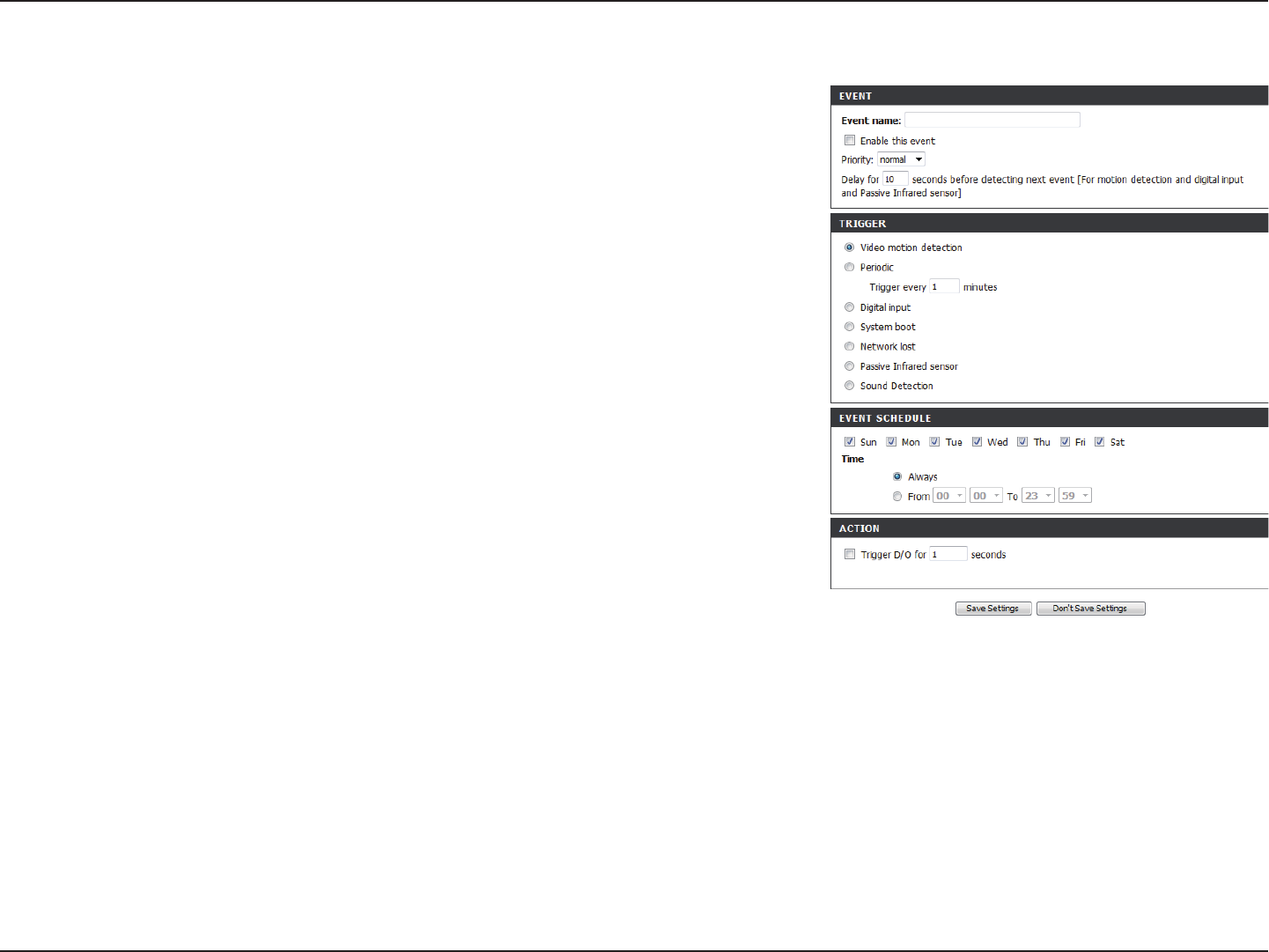
48D-Link DCS-4201 User Manual
Section 3: Conguration
Add Event
Create and schedule up to 2 events with their own settings here. After making any changes,
click the Save Settings button to save your changes.
Event name:
Enable this event:
Priority:
Delay:
Trigger:
Video Motion Detection:
Periodic:
Digital input:
System Boot:
Network Lost:
Passive Infrared Sensor:
Sound Detection:
Enter a name for the event.
Select this box to activate this event.
Set the priority for this event. The event with higher
priority will be executed rst.
Select the delay time before checking the next event. It
is being used for both events of motion detection and
digital input trigger.
Specify the input type that triggers the event.
Motion is detected during live video monitoring. Select
the windows that need to be monitored.
The event is triggered in specied intervals. The trigger
interval unit is in minutes.
The external trigger input to the camera.
Triggers an event when the system boots up.
Triggers an event when the network connection is lost.
Triggers an event when the PIR sensor detects movement.
Triggers an event when sound is detected.
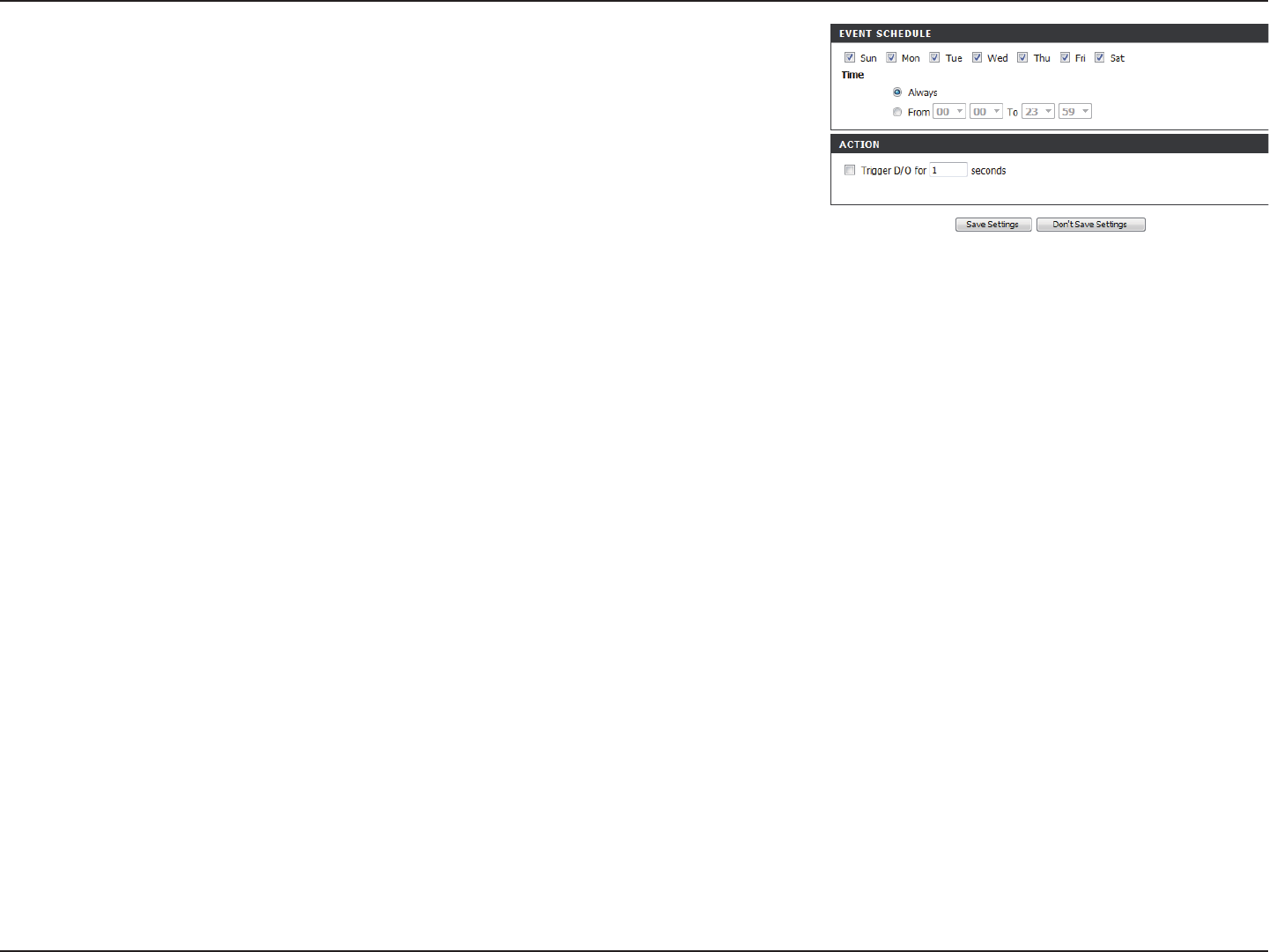
49D-Link DCS-4201 User Manual
Section 3: Conguration
Time:
Action:
Trigger D/O:
Select Always or enter the time interval.
If you have created Server and Media entries, you will
see them appear here. Select which Server you want to
send to and which Media you want the camera to send.
Select to trigger the digital output for a specic number
of seconds when an event occurs.
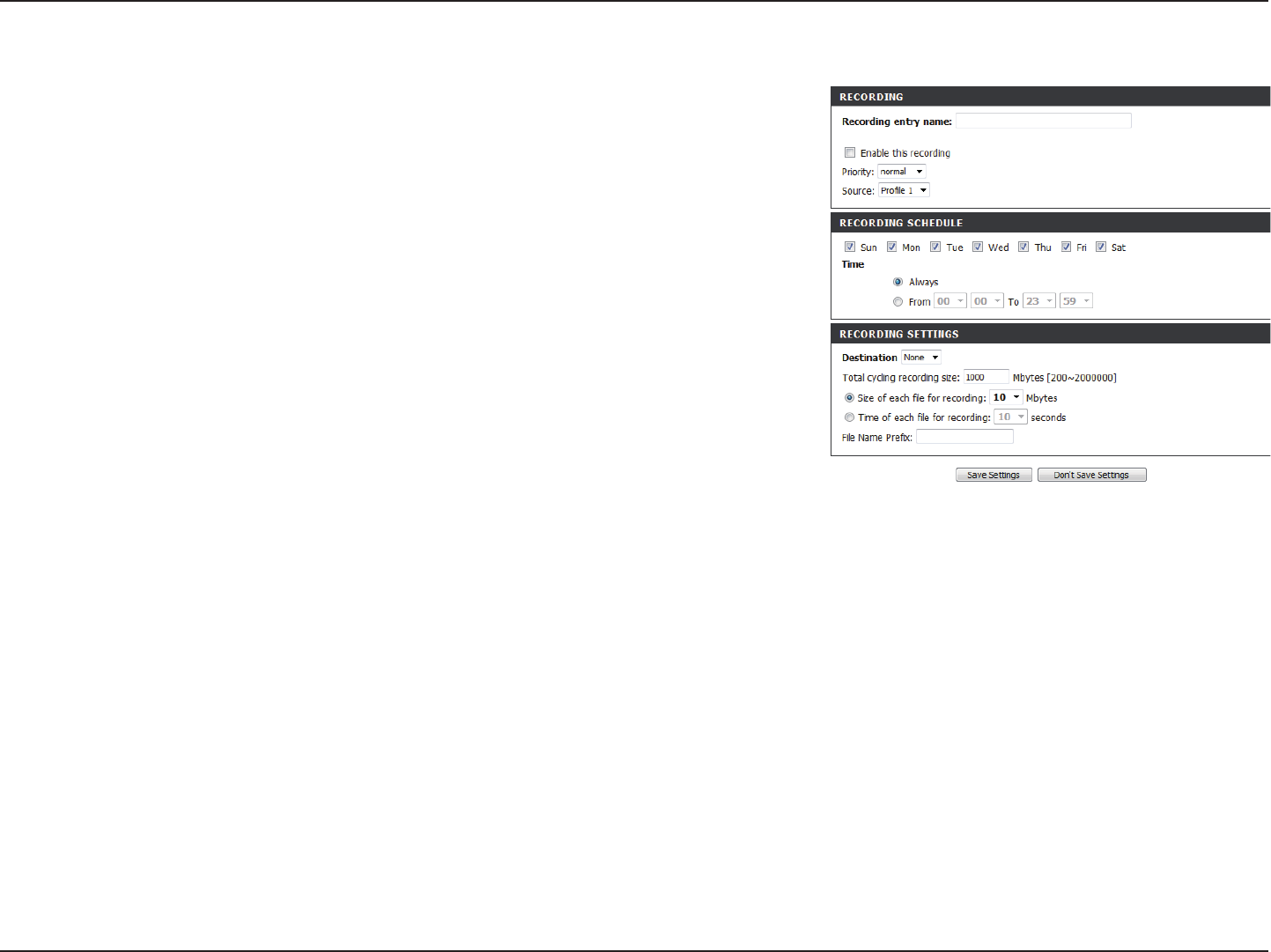
50D-Link DCS-4201 User Manual
Section 3: Conguration
Add Recording
Recording entry name:
Enable this recording:
Priority:
Source:
Recording schedule:
Recording settings:
Destination:
Total cycling recording size:
The unique name of the entry.
Select this to enable the recording function.
Set the priority for this entry. The entry with a higher
priority value will be executed rst.
The source of the stream.
Scheduling the recording entry.
Conguring the setting for the recording.
Select the folder where the recording le will be stored.
Please input a HDD volume between 1 MB and 2 TB for
recording space. The recording data will replace the
oldest record when the total recording size exceeds this
value. For example, if each recording le is 6MB, and the
total cyclical recording size is 600MB, then the camera
will record 100 les in the specied location (folder) and
then will delete the oldest le and create new le for
cyclical recording.
Please note that if the free HDD space is not enough, the
recording will stop. Before you set up this option please
make sure your HDD has enough space, and it is better to
not save other les in the same folder as recording les.
Here you can congure and schedule the recording settings. After making any changes,
click the Save Settings button to save your changes.

51D-Link DCS-4201 User Manual
Section 3: Conguration
Size of each le for recording:
Time of each le for recording:
File Name Prex:
If this is selected, les will be separated based on the le
size you specify.
If this is selected, les will be separated based on the
maximum length you specify.
The prex name will be added on the le name of the
recording le(s).
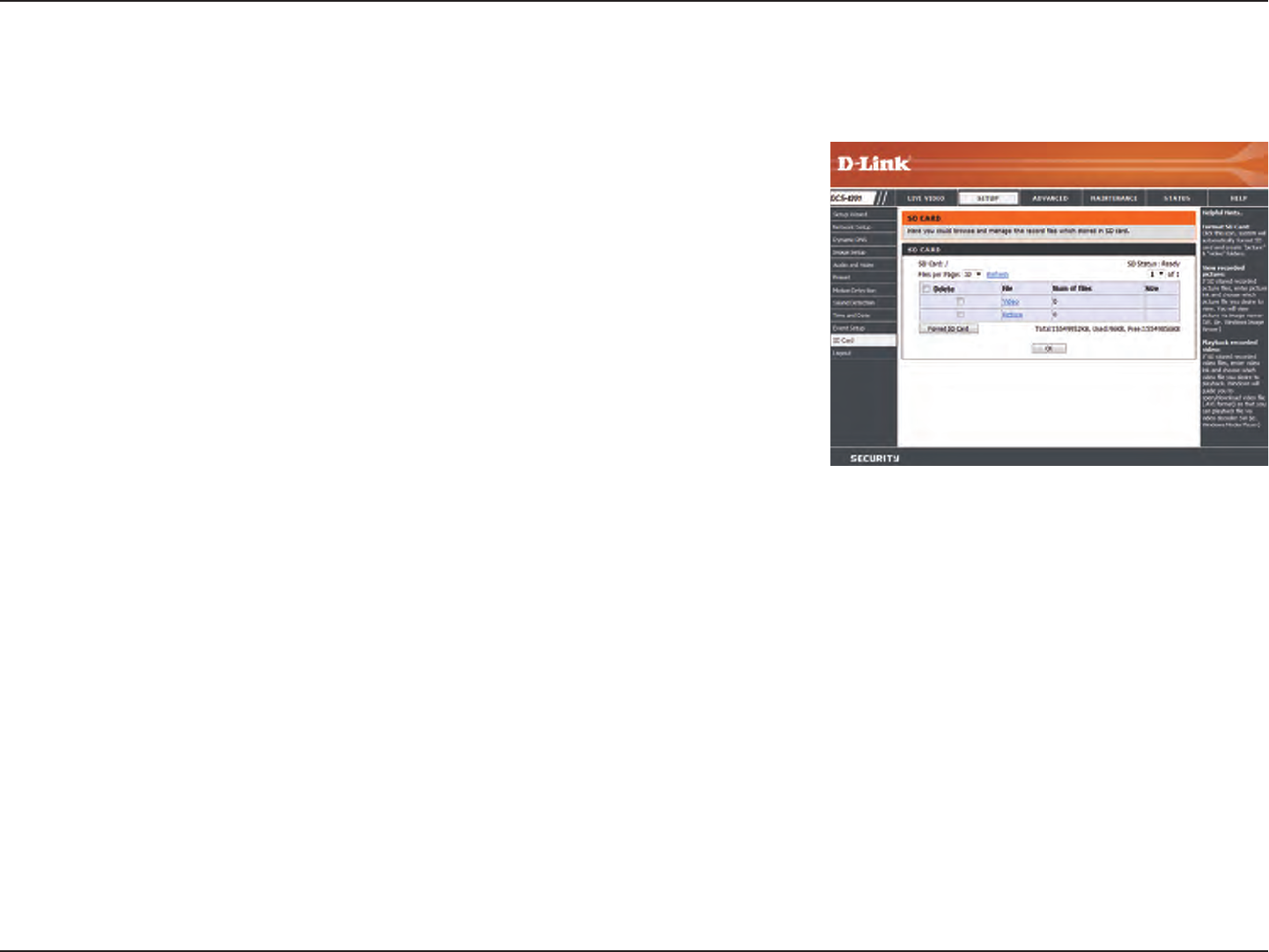
52D-Link DCS-4201 User Manual
Section 3: Conguration
SD Card
Format SD Card:
View Recorded Picture:
Playback Recorded Video:
Refresh:
Click this icon to automatically format the microSD card
and create "picture" & "video" folders.
If the picture les are stored on the microSD card, click
on the picture folder and choose the picture le you
would like to view.
If video les are stored on the microSD card, click on the
video folder and choose the video le you would like to
view.
Reloads the le and folder information from the microSD
card.
Here you may browse and manage the recorded les which are stored on the microSD card.

53D-Link DCS-4201 User Manual
Section 3: Conguration
Advanced
Digital Input/Output
This screen allows you to control the behavior of digital input and digital output devices. The I/O connector provides the physical interface for
digital output (DO) and digital input (DI) that is used for connecting a variety of external alarm devices such as IR-Sensors and alarm relays. The
digital input is used for connecting external alarm devices and once triggered images will be taken and e-mailed. After making any changes, click
the Save Settings button to save your changes.
Select D/I or D/O Mode: The camera will send a signal when an event is triggered,
depending upon the type of device connected to the DI
circuit.
N.C. stands for Normally Closed. This means that the
normal state of the circuit is closed. Therefore events are
triggered when the device status changes to "Open."
N.O. stands for Normally Open. This means that the
normal state of the circuit is open. Therefore events are
triggered when the device status changes to "Closed."
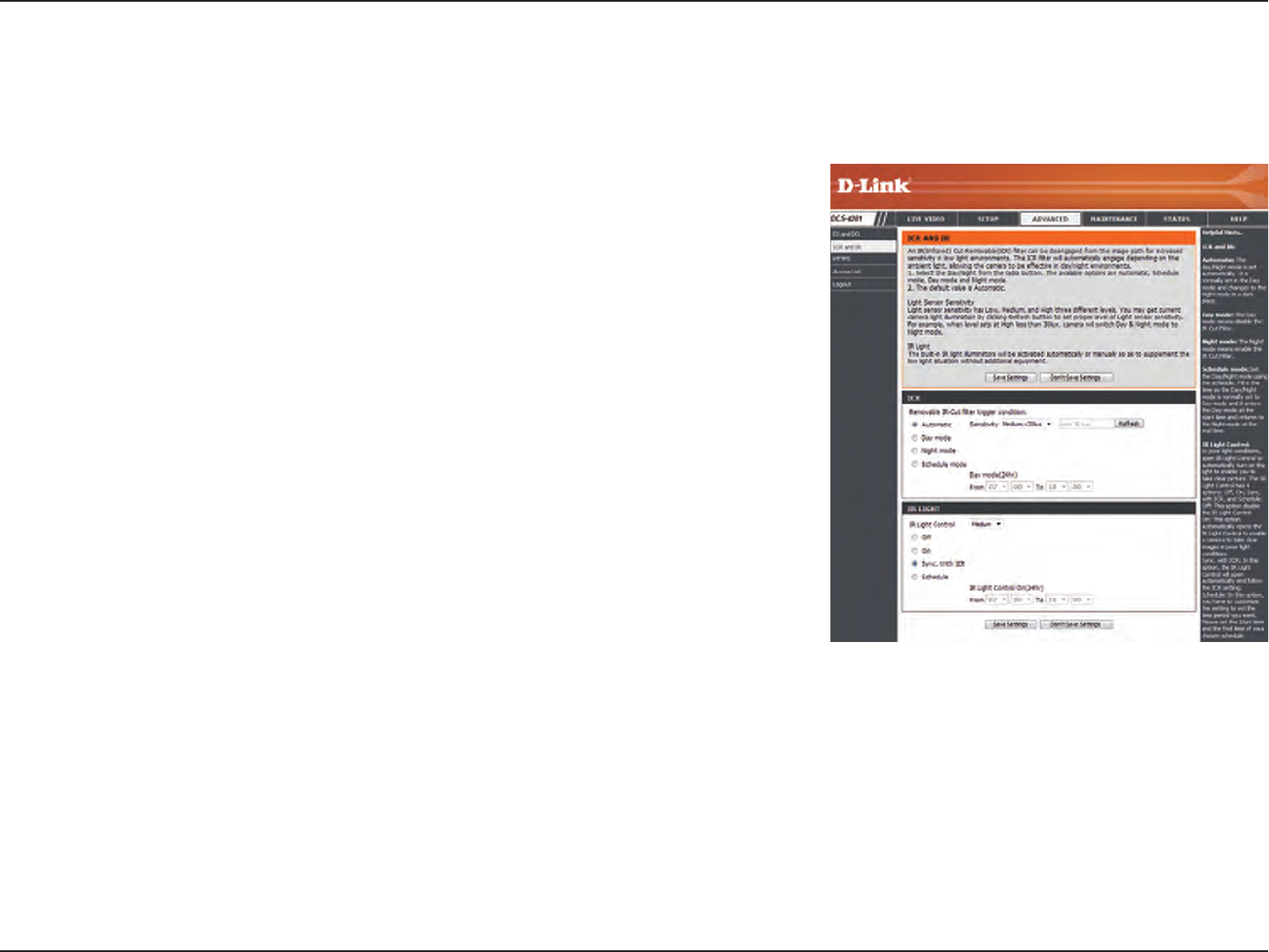
54D-Link DCS-4201 User Manual
Section 3: Conguration
ICR and IR
Here you can congure the ICR and IR settings. The IR(Infrared) Cut-Removable(ICR) lter can be disengaged for increased sensitivity in low light
environments.
Automatic:
Day Mode:
Night Mode:
Schedule Mode:
IR Light Control:
O:
On:
Sync with ICR:
Schedule:
The Day/Night mode is set automatically. You can use the
Sensitivity dropdown box to set when the camera will
switch to Night mode. The text box to the right shows
what lighting conditions are currently being detected
by the camera for reference. You can refresh this status
by clicking the Refresh button.
Day mode enables the IR Cut Filter.
Night mode disables the IR Cut Filter.
Set up the Day/Night mode using a schedule. The camera
will enter Day mode at the starting time and return to
Night mode at the ending time.
The camera can enable or disable the IR (infrared) light
according to your preferences. This setting provides
additional controls depending on your specic application.
The IR light will always be o.
The IR light will always be on.
The IR light will turn on when the ICR sensor is on.
The IR light will turn on or o according to the schedule
that you specify below.
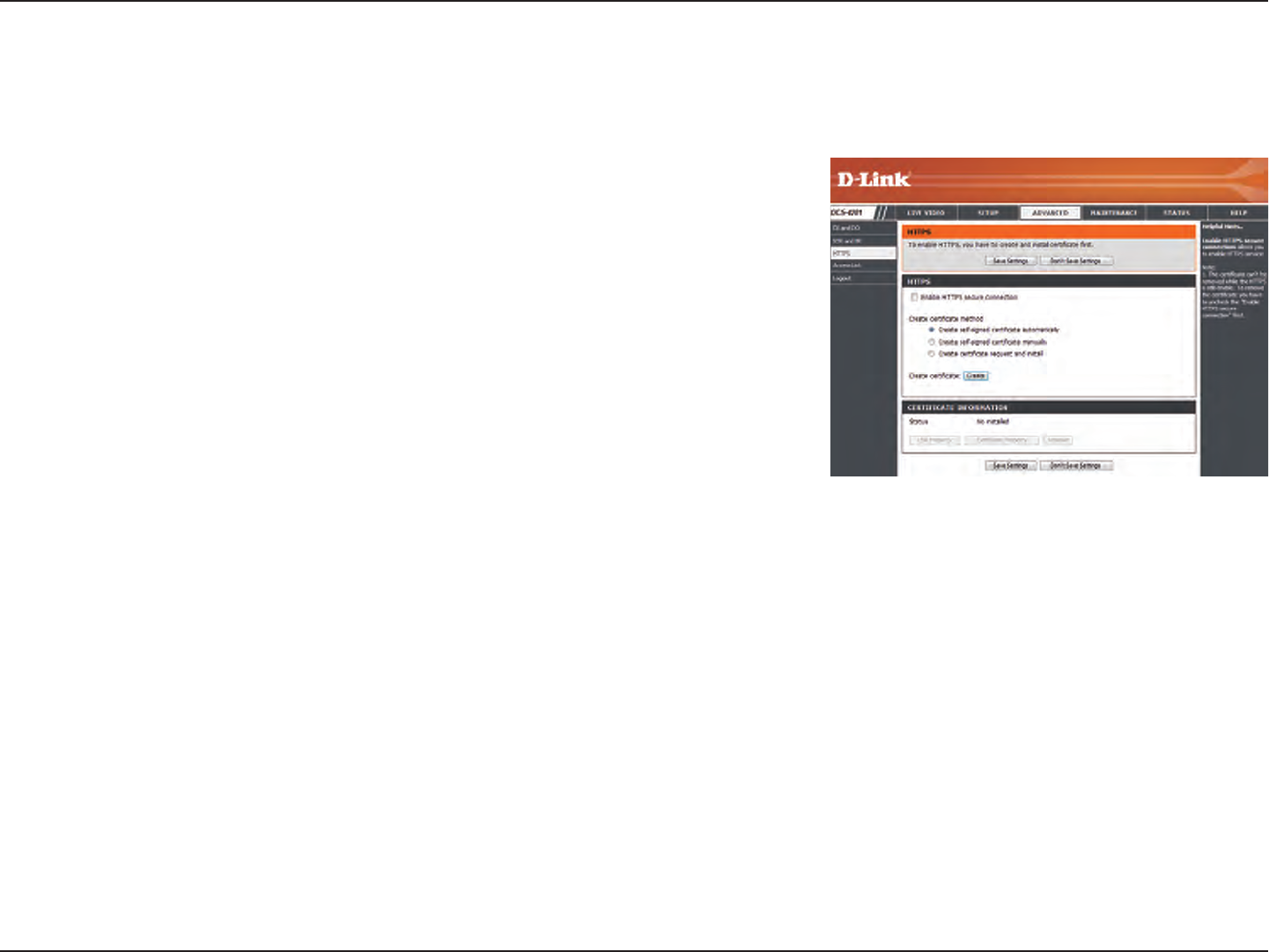
55D-Link DCS-4201 User Manual
Section 3: Conguration
HTTPS
This page allows you to install and activate an HTTPS certicate for secure access to your camera. After making any changes, click the Save Settings
button to save your changes.
Enable HTTPS Secure Connection:
Create Certicate Method:
Status:
Enable the HTTPS service.
Choose the way the certicate should be created. Three
options are available:
Create a self-signed certicate automatically
Create a self-signed certicate manually
Create a certicate request and install
Displays the status of the certicate.
Note: The certicate cannot be removed while HTTPS
is still enabled. To remove the certicate, you must rst
uncheck Enable HTTPS secure connection.
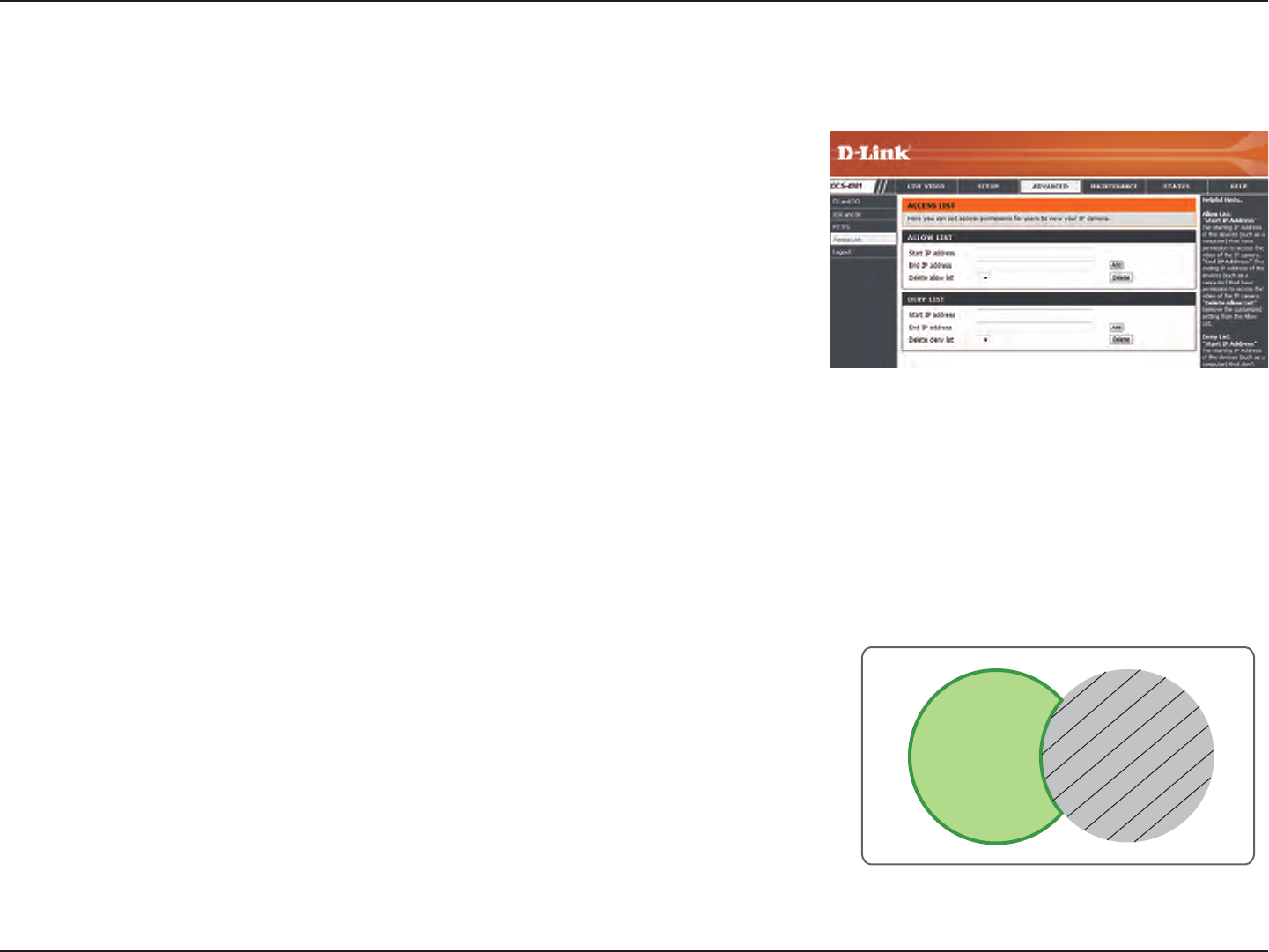
56D-Link DCS-4201 User Manual
Section 3: Conguration
Access List
Here you can set access permissions for users to view your DCS-4201.
Allow list:
Start IP address:
End IP address:
Delete allow list:
Deny list:
Delete deny list:
The list of IP addresses that have the access right to the
camera.
The starting IP Address of the devices (such as a computer)
that have permission to access the video of the camera.
Click Add to save the changes made.
Note: A total of seven lists can be congured for both
columns.
The ending IP Address of the devices (such as a computer)
that have permission to access the video of the camera.
Remove the customized setting from the Allow List.
The list of IP addresses that have no access rights to the
camera.
Remove the customized setting from the Delete List.
For example:
When the range of the Allowed List is set from 1.1.1.0
to 192.255.255.255 and the range of the Denied List is
set from 1.1.1.0 to 170.255.255.255. Only users with IPs
located between 171.0.0.0 and 192.255.255.255 can
access the Network Camera.
Alowed
List Denied
List

57D-Link DCS-4201 User Manual
Section 3: Conguration
Maintenance
Device Management
You may modify the name and administrator’s password of your camera, as well as add and manage the user accounts for accessing the camera.
You may also use this section to create a unique name and congure the OSD settings for your camera.
Admin Password Setting:
Add User Account:
User Name:
Password:
User List:
IP Camera Name:
Enable OSD:
Label:
Show Time:
LED:
Set a new password for the administrator’s account.
Add a new user account.
Enter the user name for the new account.
Enter the password for the new account.
All the existing user accounts will be displayed here. You
may delete accounts included in the list, but you may
want to reserve at least one as a guest account.
Create a unique name for your camera that will be added
to the le name prex when creating a snapshot or a
video clip.
Select this option to enable the On-Screen Display
feature for your camera.
Enter a label for the camera, which will be shown on the
OSD when it is enabled.
Select this option to enable the time-stamp display on
the video screen.
You may specify whether or not to illuminate the status
LED on the camera.
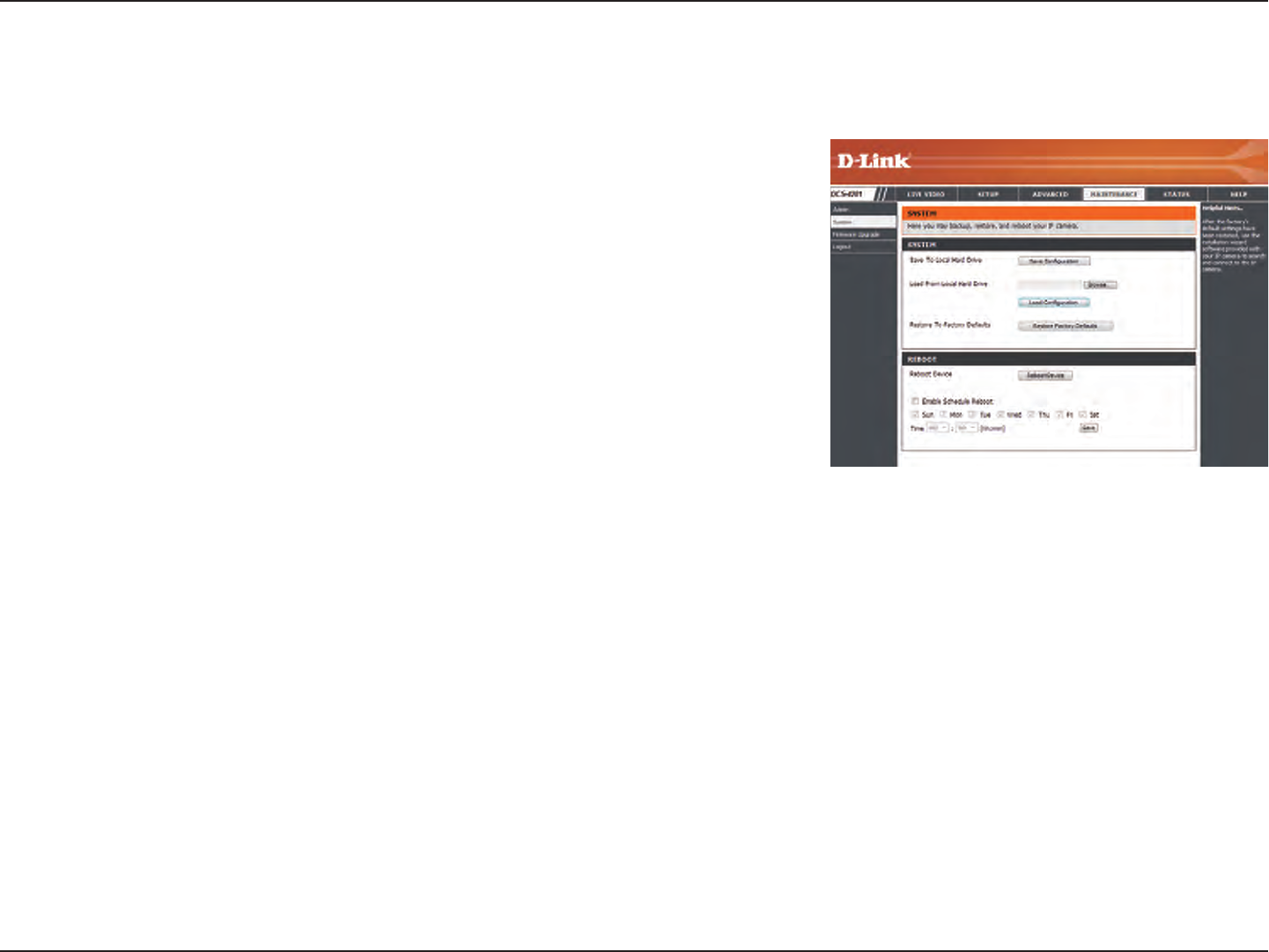
58D-Link DCS-4201 User Manual
Section 3: Conguration
System
In this section, you may back up, restore and reset the camera conguration, or reboot the camera.
Save To Local Hard Drive:
Local From Local Hard Drive:
Restore to Factory Default:
Reboot Device:
Enable Schedule Reboot:
You may save your current camera conguration as a le
on your computer.
Locate a pre-saved conguration by clicking Browse and
then restore the pre-dened settings to your camera by
clicking Load Conguration.
You may reset your camera and restore the factory
settings by clicking Restore Factory Defaults.
This will restart your camera.
You can schedule the camera to reboot according to a
schedule. Select the days and time you want the camera
to automatically reboot.

59D-Link DCS-4201 User Manual
Section 3: Conguration
Firmware Upgrade
The camera's current rmware version will be displayed on this screen. You may visit the D-Link Support Website to check for the latest available
rmware version.
To upgrade the rmware on your DCS-4201, please download and save the latest rmware version from the D-Link Support Page to your local
hard drive. Locate the le on your local hard drive by clicking the Browse button. Select the le and click the Upload button to start upgrading the
rmware.
Current Firmware Version:
Current Product Name:
File Path:
Upload:
Displays the detected rmware version.
Displays the camera model name.
Locate the le (upgraded rmware) on your hard drive
by clicking Browse.
Uploads the new rmware to your camera.
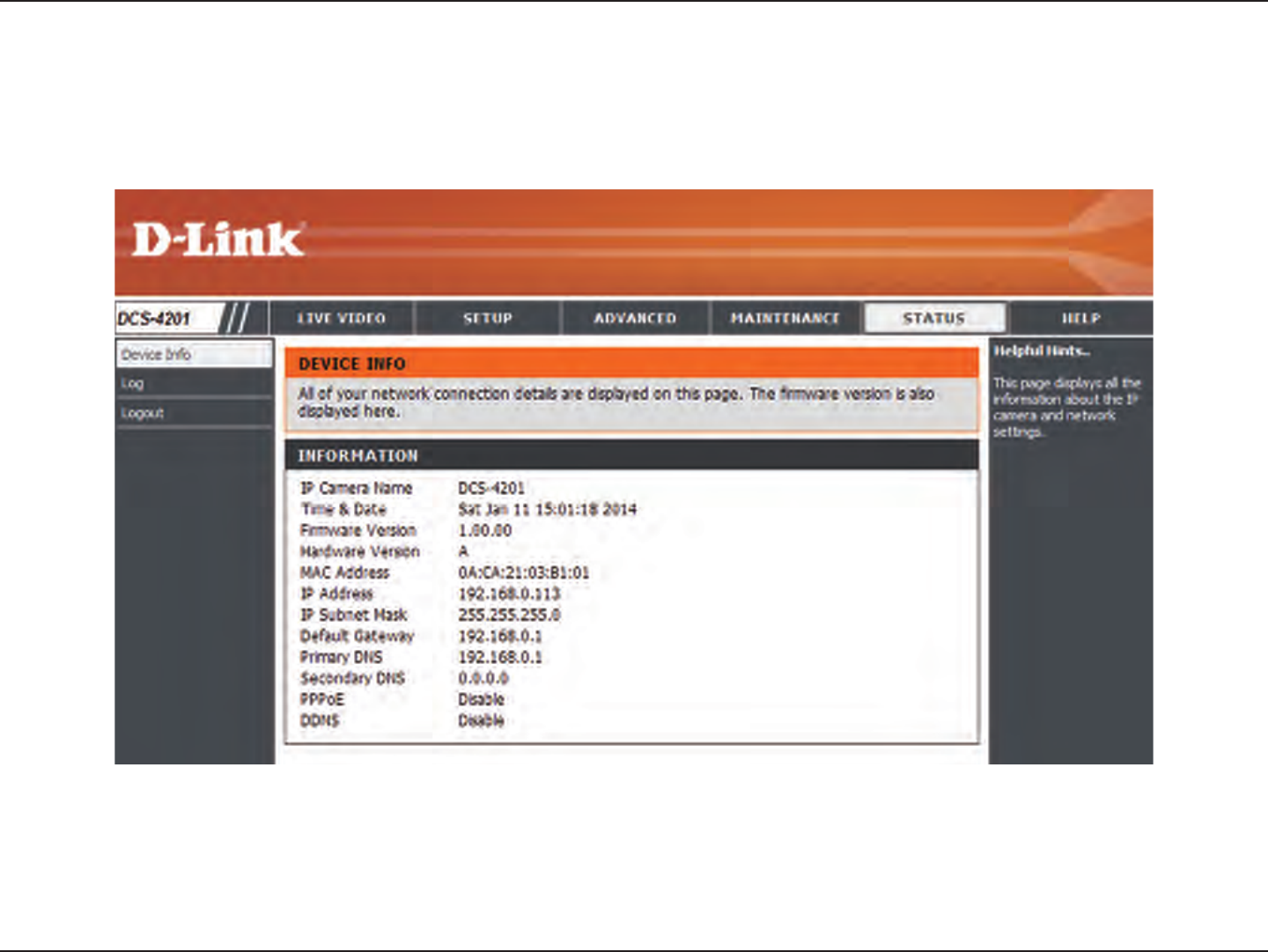
60D-Link DCS-4201 User Manual
Section 3: Conguration
Status
Device Info
This page displays detailed information about your device and network connection.
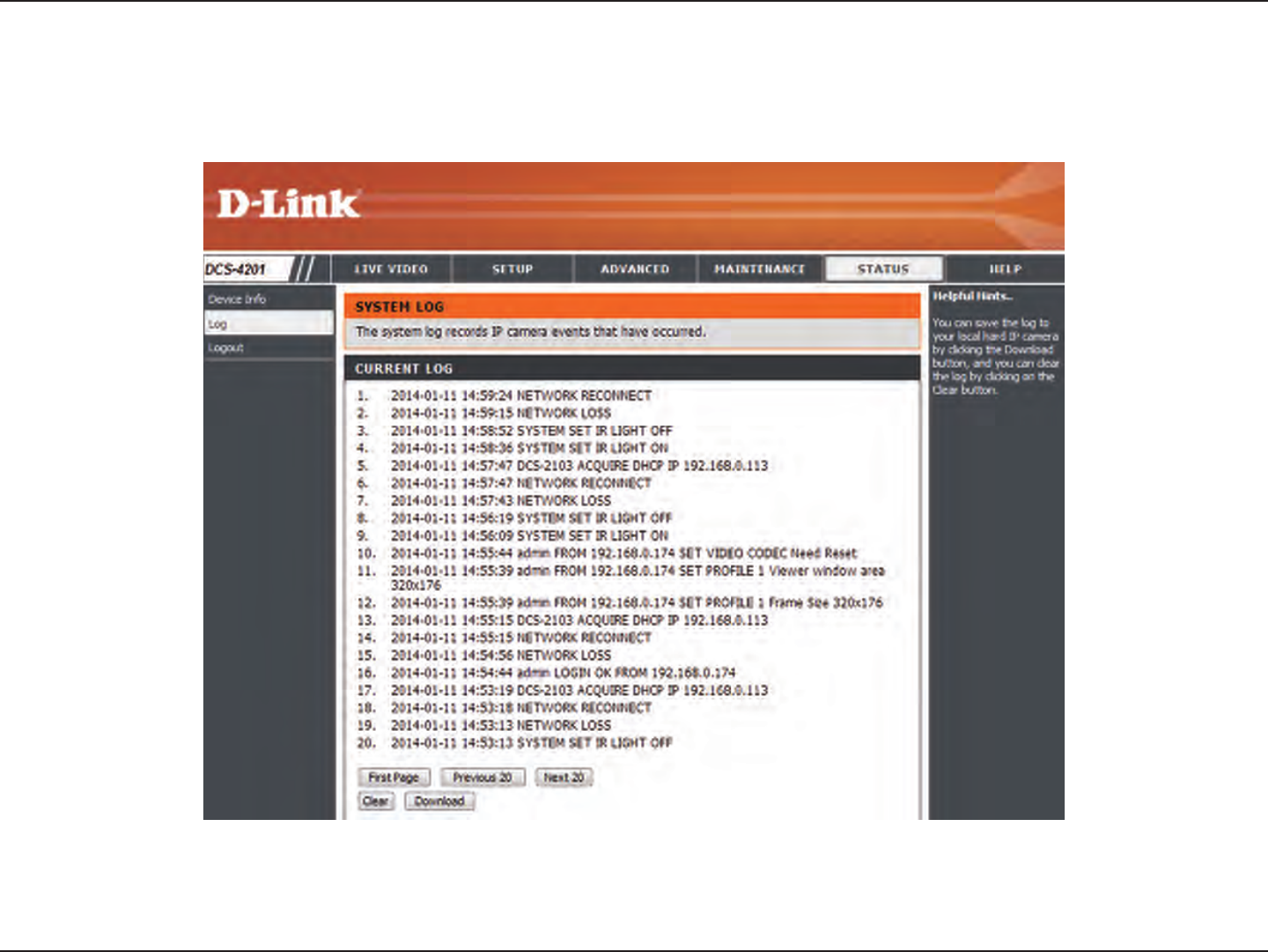
61D-Link DCS-4201 User Manual
Section 3: Conguration
This page displays the log information of your camera. You may download the information by clicking Download. You may also click Clear to delete
the saved log information.
Logs

62D-Link DCS-4201 User Manual
Section 3: Conguration
This page provides helpful information regarding camera operation.
Help
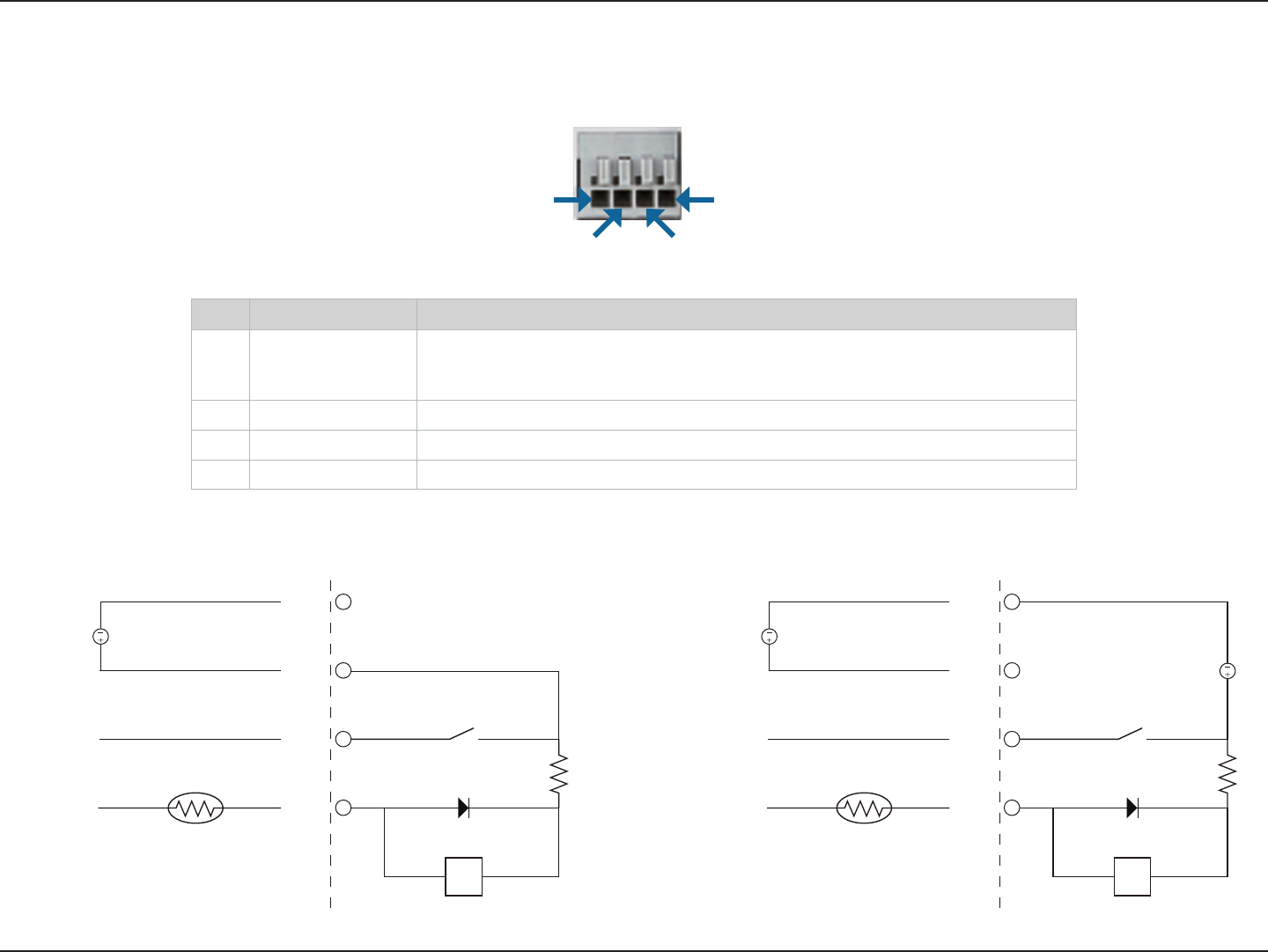
63D-Link DCS-4201 User Manual
Appendix A: DI/DO Specications
DI/DO Specications
Pin 1 Pin 4
Pin 3Pin 2
PIN FUNCTION NOTE
1 Digital Out (DO) Uses an open-drain NFET transistor with the source connected to GND in camera. If used
with an external relay, a diode must be connected in parallel with the load for protection
against voltage transients. Max loading is 100 mA.
2 Digital In (DI) A switch from DI to DC 5 V, activated by setting NO. or NC.
3 DC5V OUTPUT DC 5 V Output / Max. 100 mA
4 GND GND
Internal 5V Power External 3~12V Power
DO
DI
5V
DND
N.C / N.O
100 mA
ALARM
Reed switch
Diode
DC Power 5V
R
DO
DI
5V
DND
N.C / N.O
ALARM
Reed switch
Diode
DC Power 5V
R
DC Power 3V~12V
100 mA

64D-Link DCS-4201 User Manual
Appendix B: Technical Specications
Technical Specications
Camera Camera Hardware
Prole
1/4” Megapixel progressive CMOS sensor
10 meter IR illumination distance
Minimum illumination: 0 lux with IR LED on
Built-in Infrared-Cut Removable (ICR) Filter module
Built-in PIR sensor
Built-in microphone and speaker
10x digital zoom
Focal length: 1.8 mm
Aperture: F2.4
Angle of view:
(H) 97.6°
(V) 69.2°
(D) 108.9°
Image Features
Congurable image size, quality, frame rate, and bit rate
Time stamp and text overlays
Congurable motion detection windows
Congurable privacy mask zones
Congurable shutter speed, brightness, saturation, contrast,
and sharpness
Video Compression
Simultaneous H.264/MJPEG format compression
H.264 multicast streaming
JPEG for still images
Video Resolution 16:9 - 1280x720, 800x448, 640x360, 480x272, 320x176 4:3 - 960x720, 800x592, 640x480, 480x352, 320x240
Audio Support G.711, AAC
External Device
Interface
10/100 BASE-TX Fast Ethernet port
DI/DO port
MicroSD card slot
802.11n wireless
Network Network Protocols IPv6
IPv4
TCP/IP
UDP
ICMP
DHCP client
NTP client (D-Link)
DNS client
DDNS client (D-Link)
SMTP client
FTP client
HTTP / HTTPS
Samba Client
PPPoE
UPnP port forwarding
RTP / RTSP/ RTCP
IP ltering
QoS
CoS
Multicast
SNMP
ONVIF compliant
Security
Administrator and user group protection
Password authentication
HTTP and RTSP digest encryption
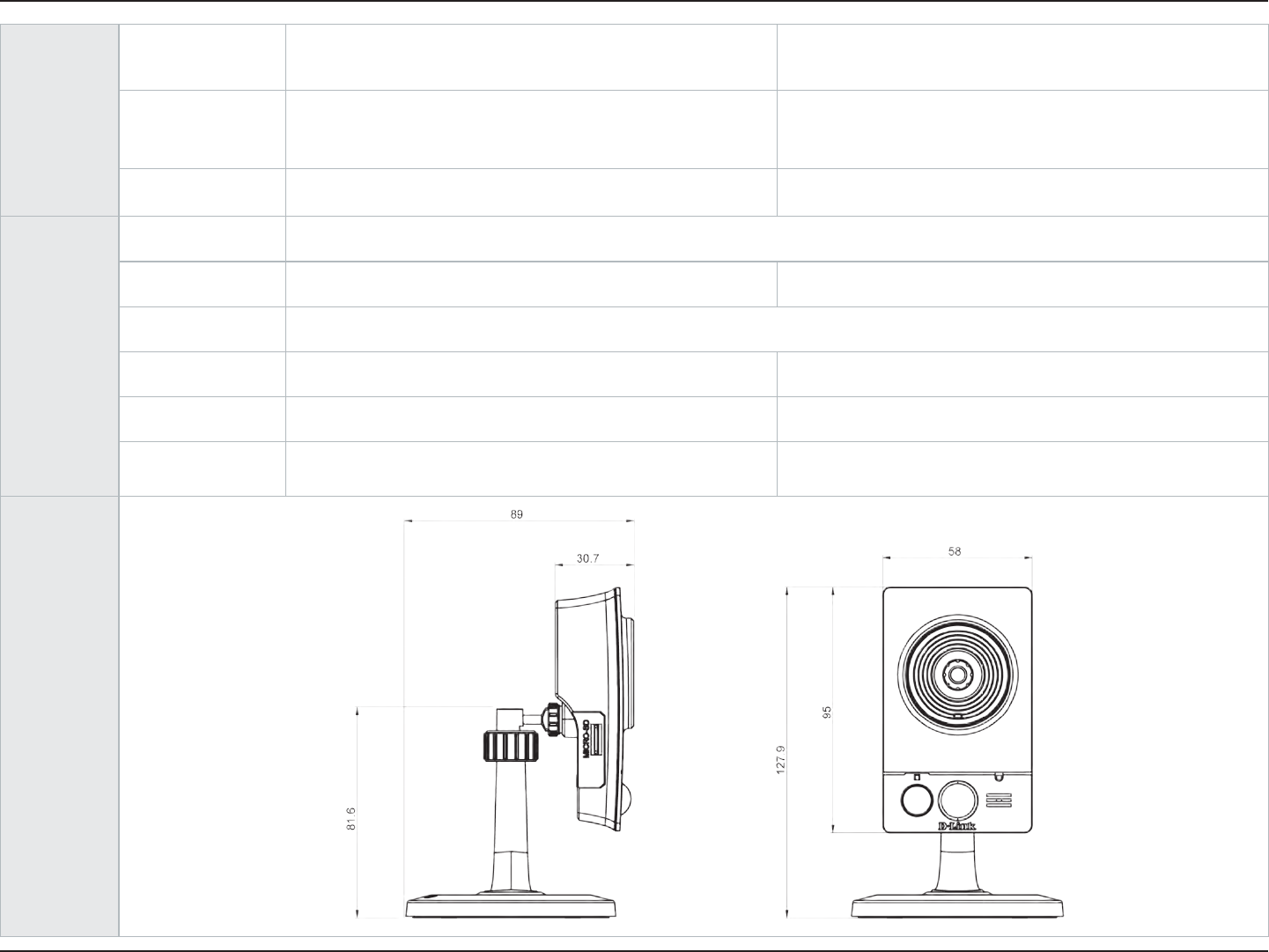
65D-Link DCS-4201 User Manual
Appendix B: Technical Specications
System
Management
System
Requirements for
Web Interface
Operating System: Microsoft Windows 8/7/Vista
Browser: Internet Explorer, Firefox
Event Management
Motion detection
Event notication and uploading of snapshots/video clips via
e-mail or FTP
Supports multiple SMTP and FTP servers
Multiple event notications
Multiple recording methods for easy backup
Remote
Management
Take snapshots/video clips and save to local hard drive
Conguration interface accessible via web browser
General Weight 118g
Power Supply 5 VDC, 1.2 A
Power Consumption 4.0 +-5% watts
Temperature Operating: 0 to 40 °C (32 to 104 °F) Storage: -20 to 70 °C (-4 to 158 °F)
Humidity Operating: 20% to 80% non-condensing Storage: 5% to 95% non-condensing
Certications CE
CE LVD
FCC
C-Tick
Dimensions
•
For Model: DCS-4201
FCC Statement
Part 15 General
This device complies with Part 15 of the FCC Rules. Operation is subject to the following two conditions: (1) This device may not cause harmful
interference, and (2) this device must accept any interference received, including interference that may cause undesired operation.
FCC Caution: Any changes or modifications not expressly approved by the party responsible for compliance could void the user's authority to operate
this equipment.
This transmitter must not be co-located or operating in conjunction with any other antenna or transmitter.
15B
This equipment has been tested and found to comply with the limits for a Class B digital device, pursuant to Part 15 of the FCC Rules. These limits
are designed to provide reasonable protection against harmful interference in a residential installation. This equipment generates, uses and can
radiate radio frequency energy and, if not installed and used in accordance with the instructions, may cause harmful interference to radio
communications. However, there is no guarantee that interference will not occur in a particular installation. If this equipment does cause harmful
interference to radio or television reception, which can be determined by turning the equipment off and on, the user is encouraged to try to correct
the interference by one of the following measures:
- Reorient or relocate the receiving antenna.
- Increase the separation between the equipment and receiver.
- Connect the equipment into an outlet on a circuit different from that to which the receiver is connected.
- Consult the dealer or an experienced radio/TV technician for help.
FCC Caution: Any changes or modifications not expressly approved by the party responsible for compliance could void the user's authority to operate
this equipment.
This transmitter must not be co-located or operating in conjunction with any other antenna or transmitter.
Note: The country code selection is for non-US model only and is not available to all US model. Per FCC regulation, all WiFi product marketed in US
must fixed to US operation channels only.
MPE or SAR
Radiation Exposure Statement:
This equipment complies with FCC radiation exposure limits set forth for an uncontrolled environment. This equipment should be installed and
operated with minimum distance 20cm between the radiator & your body.
IC Statement
RSS-210 General
This device complies with RSS-210 of the Industry Canada Rules. Operation is subject to the following two conditions: (1) This device may not cause
harmful interference, and (2) this device must accept any interference received, including interference that may cause undesired operation.
Ce dispositif est conforme à la norme CNR-210 d'Industrie Canada applicable aux appareils radio exempts de licence. Son fonctionnement est sujet
aux deux conditions suivantes: (1) le dispositif ne doit pas produire de brouillage préjudiciable, et (2) ce dispositif doit accepter tout brouillage reçu, y
compris un brouillage susceptible de provoquer un fonctionnement indésirable.
MPE Statement
Radiation Exposure Statement:
This equipment complies with IC radiation exposure limits set forth for an uncontrolled environment. This equipment should be installed and
operated with minimum distance 20cm between the radiator & your body.
Déclaration d'exposition aux radiations:
Cet équipement est conforme aux limites d'exposition aux rayonnements IC établies pour un environnement non contrôlé. Cet équipement doit être
installé et utilisé avec un minimum de 20cm de distance entre la source de rayonnement et votre corps.